In the coming days and weeks, VW wants to launch the first ID. Deliver Buzz. With a starting price of 64,581.30 euros, the electric bus is anything but cheap, but the want-to-have factor is still extremely high. On the first test drive in Denmark and Sweden, the electric legacy of the T1 turned a lot of heads.
Table of contents
- 1 In 20 years from the study to the series
- MEB also for the electric bus
- Consumption of 21.1 kWh for the test drive
- Technical data of the ID. Buzz and ID. Buzz Cargo
- Cd value almost like an ID.4
- The two-tone paintwork is mandatory
- The beefy Bulli is wider than it is high
- The assistance systems provide an overview
- Travel Assist uses swarm data
- Two assistance packages are available
- Park Assist Plus with memory function
- ID. Light has more functions
- Infotainment system with ID. Software 3.2
- Automatic selector lever in a new position
- Apple Music and Spotify natively in the car
- Many USB-C sockets with 45 watts
- ID. Buzz starts as a five-seater in Germany
- Seven-seater with longer wheelbase planned
- Cargo takes two Euro pallets
- Late pre-orders have to be patient
- ID. Buzz starts at EUR 64,581.30
- The ID. Buzz turns more heads than a Lamborghini
- Conclusion
In 20 years from study to series< /h2>
VW's desire to revive the T1 built in the 1950s and 60s was brewing before the official announcement of the ID. Buzz in March of this year has been with the company for more than 20 years. In 2001, VW presented the Microbus study at the Detroit Auto Show, in 2011 the VW Bulli study was on display in Geneva, in 2016 the Budd-E at CES and finally the ID again in Detroit in 2017. buzz More than 70 years after the T1, we have come full circle, except that the ID. Buzz on a purely electric, much more modern, but still well-known platform.
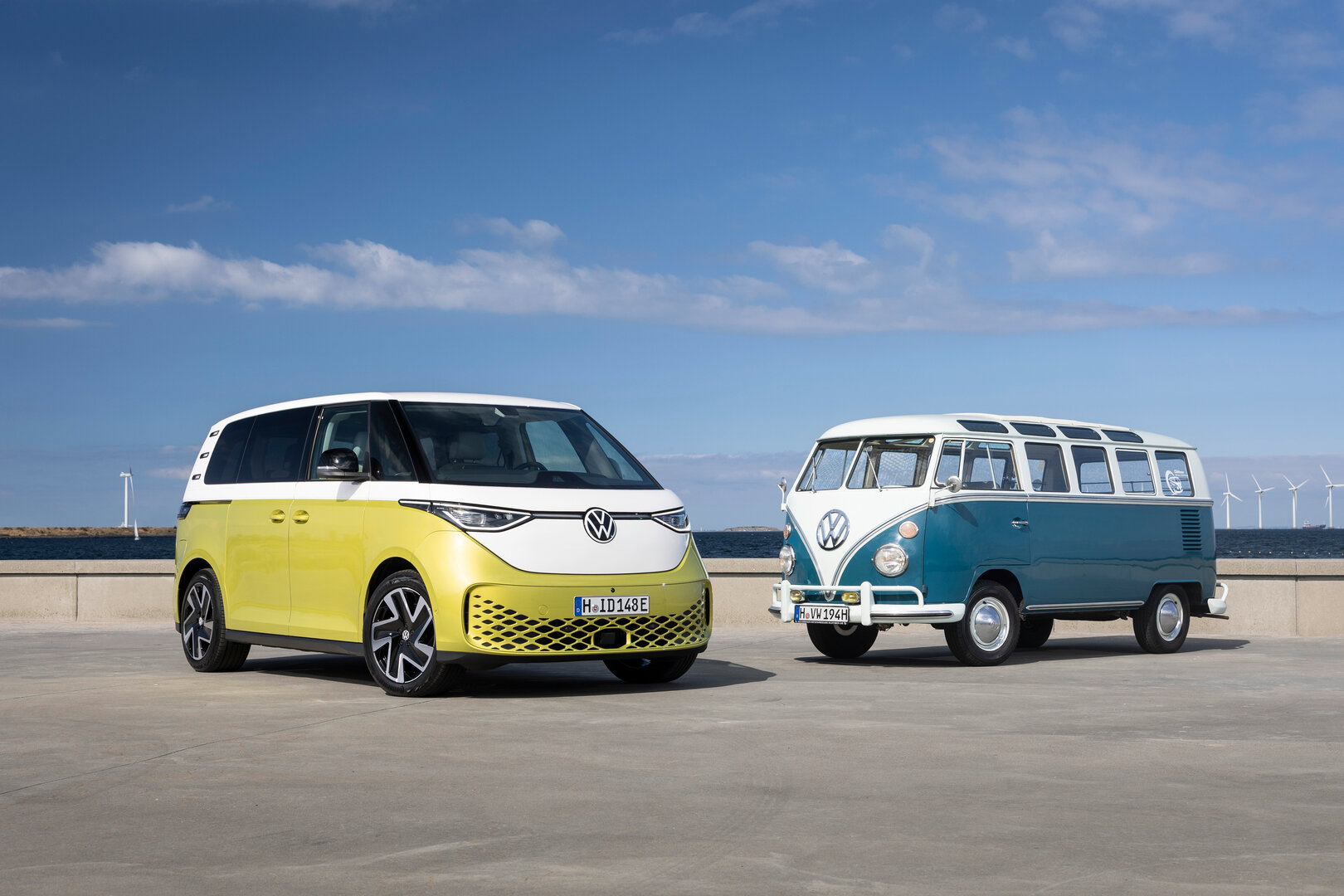 < /figure>
< /figure>
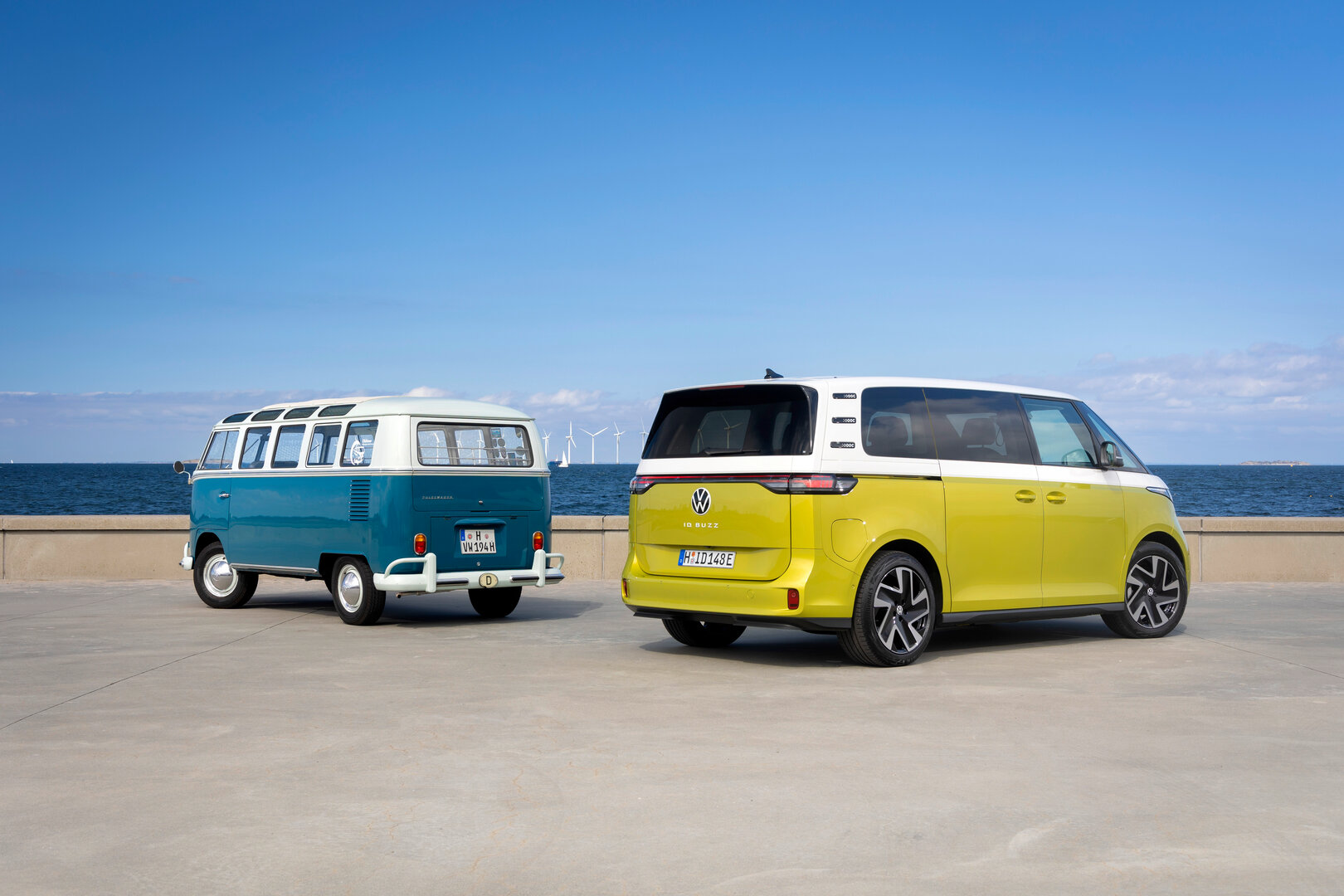
ID. Buzz and VW T1 (Image: VW)
MEB also for the electric bus
Like many electric vehicles from the VW Group, the ID. Buzz the modular electric drive kit (MEB). In the electric bus, an electric motor drives the rear axle in the same way as the four-cylinder boxer engine in the T1, so that the steering remains free of drive influences. VW combines the 150 kW (204 hp) and 310 Nm drive with a 77 kWh battery (net, gross: 82 kWh), which should enable a range of 402 to 423 km (WLPT). Acceleration from 0 to 100 km/h takes 10.2 s and the top speed is 145 km/h. As with all ID. models, there is a 1-speed gearbox at the rear, which allows coasting in automatic mode “D”, but activates single-pedal mode in “B”, the recuperation effect of which is so great that the normal brakes are hardly used have to. With the help of the electric brake booster, the ID. Brake Buzz up to a deceleration requirement of around 0.3 g and thus generate around 100 kW recuperation power. In the footwell of the vehicle, the driver is again greeted by pedals with a play and pause symbol.
Consumption of 21.1 kWh for the test drive
A first trip by ComputerBase with the ID. Buzz on almost 150 km driving route around and through Copenhagen and Malmö, where consumption was 21.1 kWh with a mix of city, country roads and motorway. VW has increased the maximum charging power within the ID. portfolio from initially 100 kW for the first ID.3 to 170 kW for the ID. Buzz increased. The manufacturer explains that a charging process from 5 to 80 percent can be completed in 30 minutes. For AC charging with 11 kW at the home wall box, 7:30 hours from 0 to 100 percent are given.
Technical data of the ID . Buzz and ID. Buzz Cargo
cd value almost like an ID.4
That the ID. Buzz does not drive like a wall unit on wheels, both in terms of streamlining and thus consumption and agility, is partly due to the comparatively low drag coefficient of the body, which at first glance appears rather massive. VW gives this as 0.285, so only slightly more than the ID.4 (0.28). The ID.5 as a combination of SUV and coupe, on the other hand, has a lower drag coefficient of 0.27. For comparison: A first wooden model of the T1 with a vertical front came to 0.75, the production model with a rounded snout was 0.44. The ID Buzz comes not only as a bus, but also as a transporter with the name ID. Buzz Cargo, with a drag coefficient of 0.29.
The two-tone paint finish is mandatory
VW moves with the ID. Buzz has many parallels with the T1, and that's very understandable given the car's basic shape and appearance, especially when one of the two-tone paint finishes is selected. The “Candy White” as a contrasting color above the waistline is practically mandatory for the perfect style factor and can be combined with “Bay Leaf Green”, “Energetic Orange”, the “Lime Yellow” often used for advertising photos and the one used by the editors for the first Exit selected “Starlight Blue” can be combined. The same colors as well as “Monosilver” and “Deep Black Pearl Effect” are also available for the single color finish.
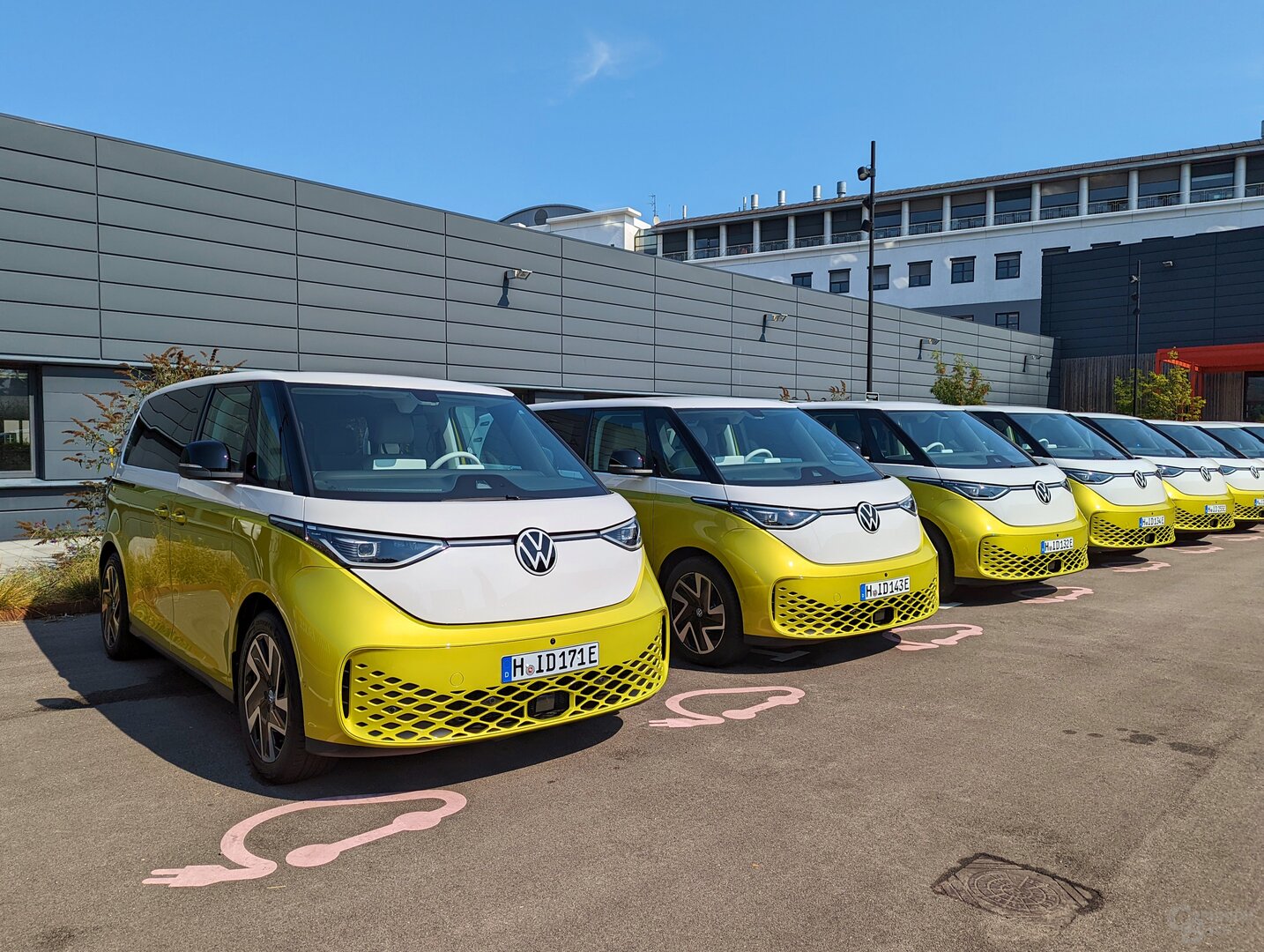 ID. Candy White and Lime Yellow Buzz
ID. Candy White and Lime Yellow Buzz Image 1 of 14
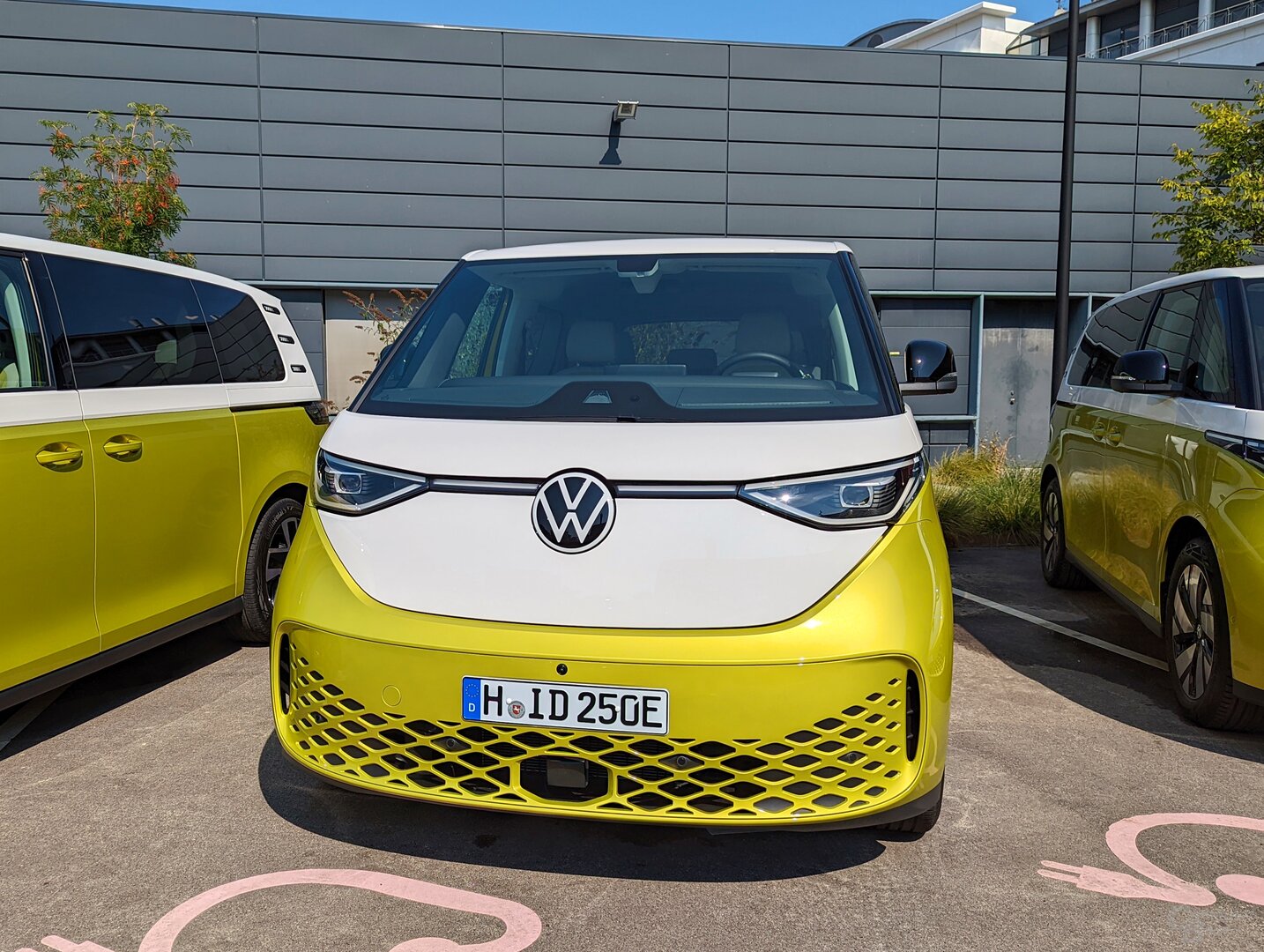 ID. Candy White and Lime Yellow Buzz
ID. Candy White and Lime Yellow Buzz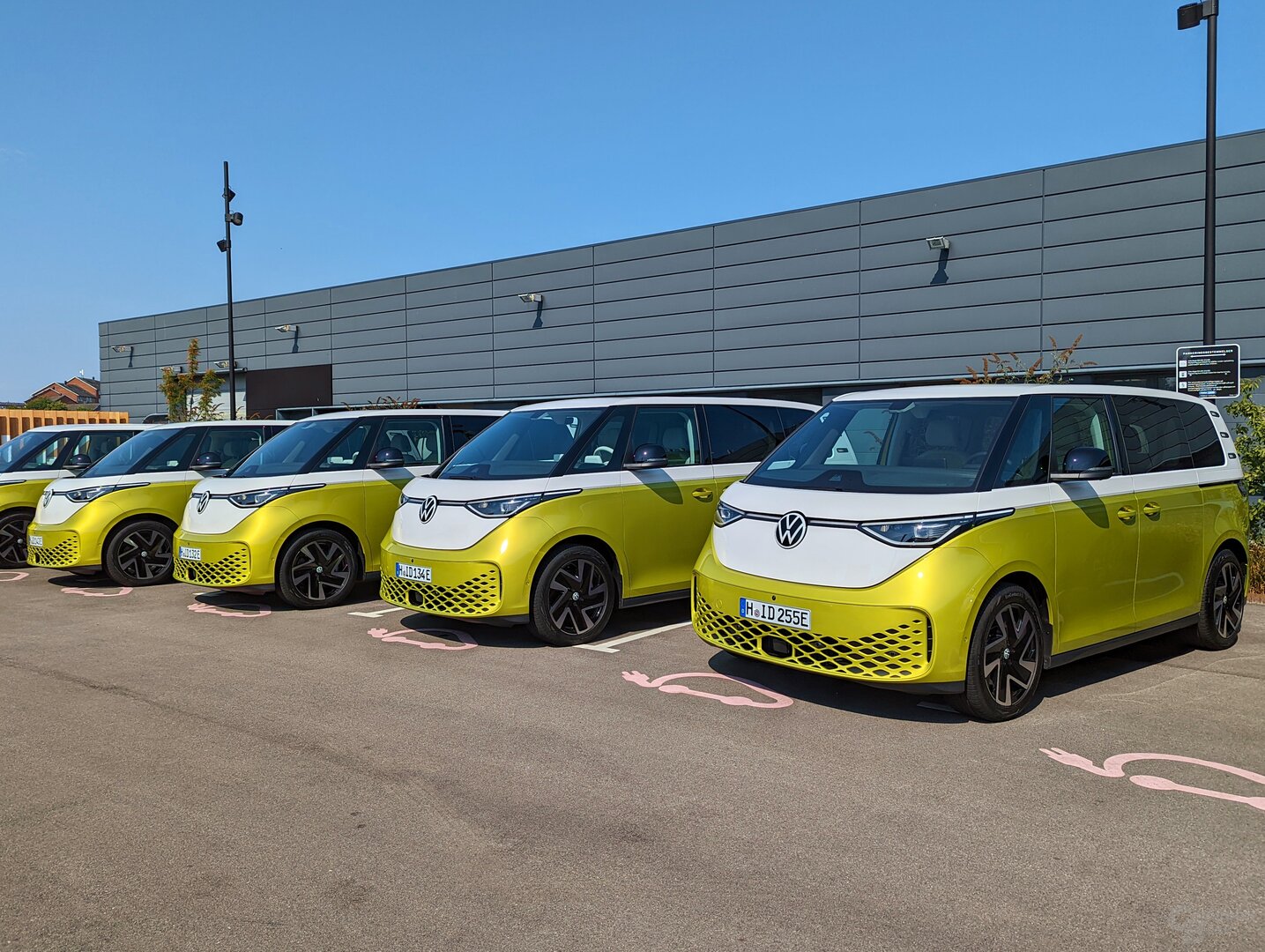 ID. Candy White and Lime Yellow Buzz
ID. Candy White and Lime Yellow Buzz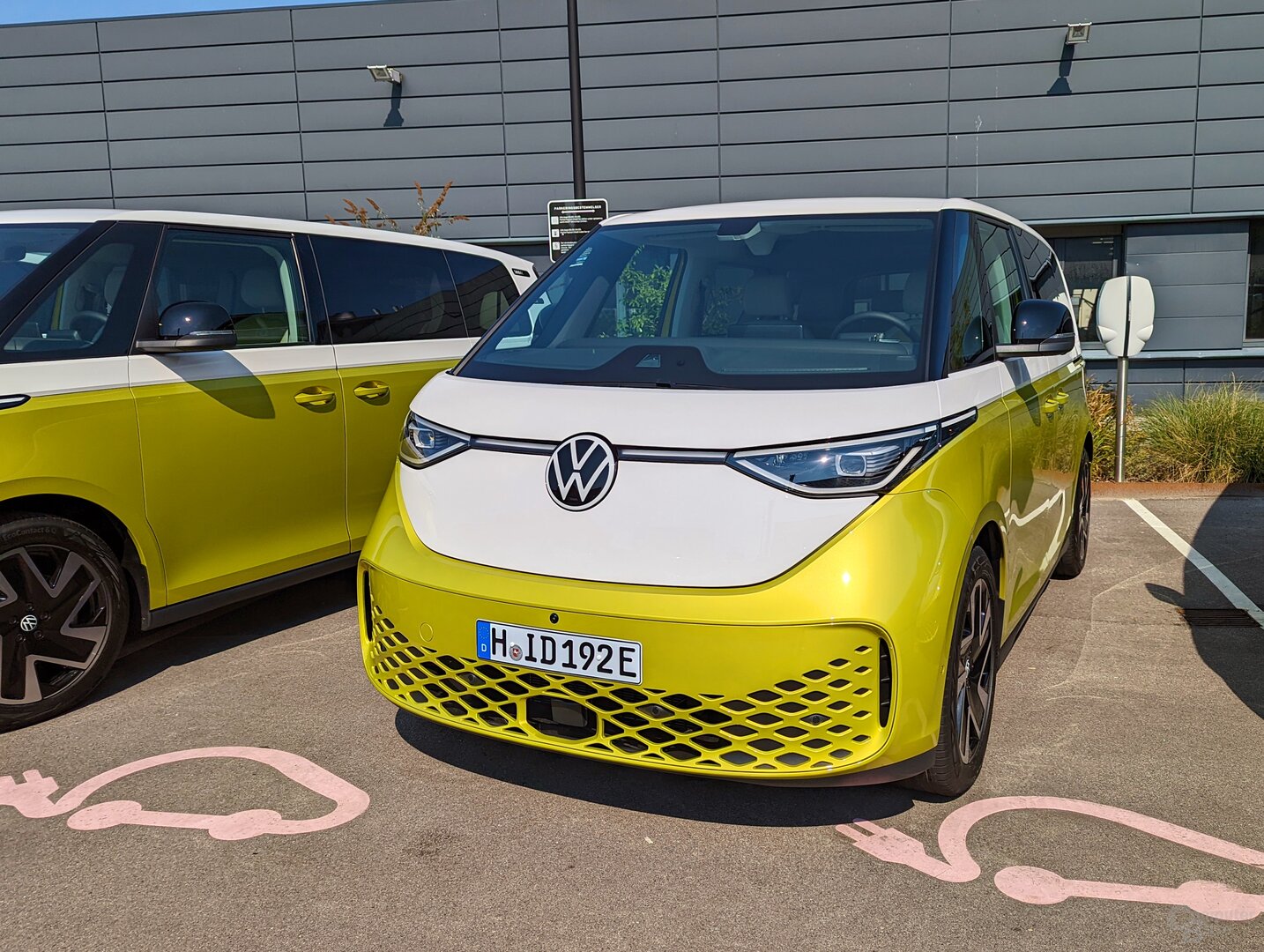 ID. Buzz in candy white and lime yellow
ID. Buzz in candy white and lime yellow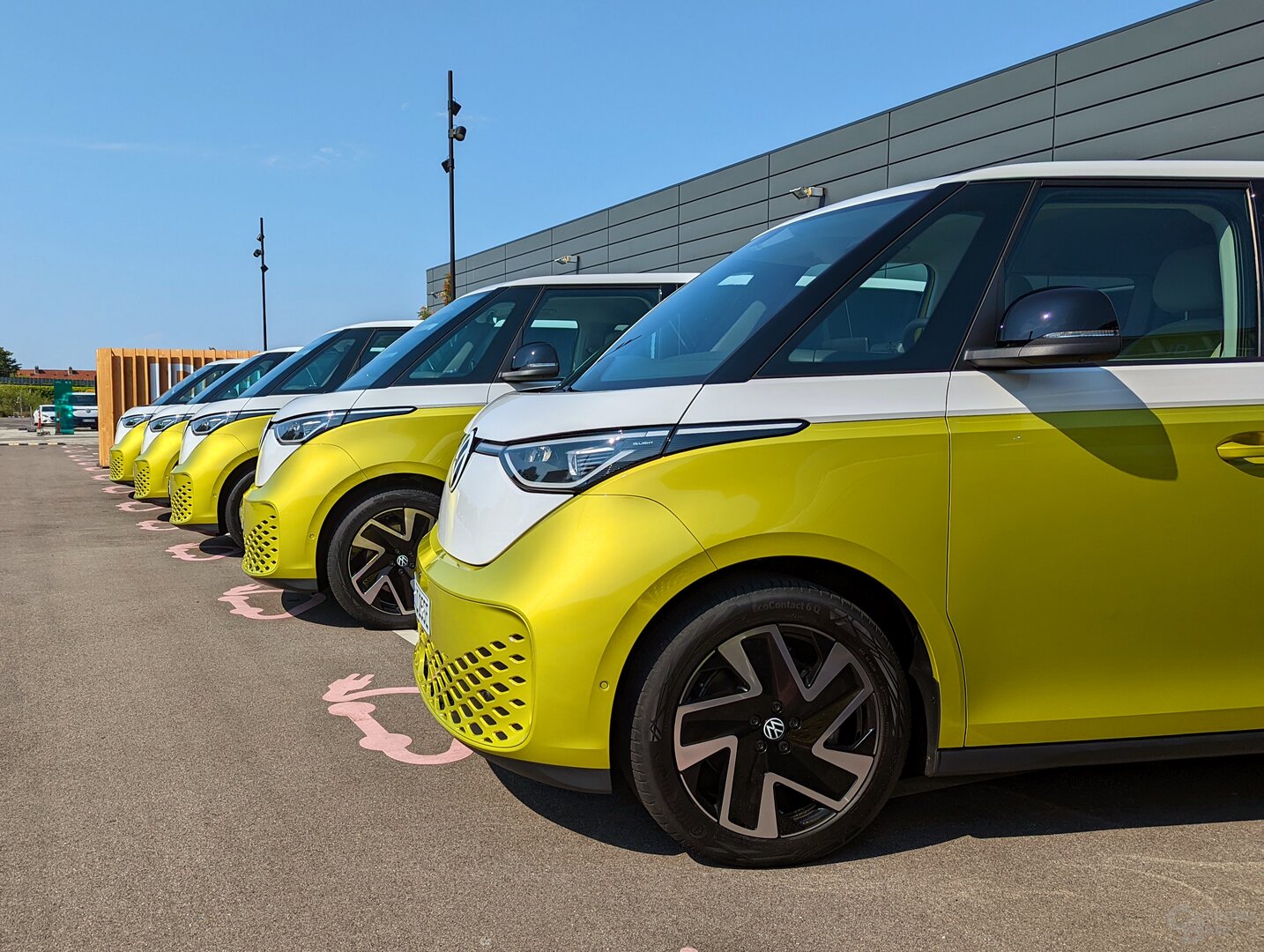 ID. Candy White and Lime Yellow Buzz
ID. Candy White and Lime Yellow Buzz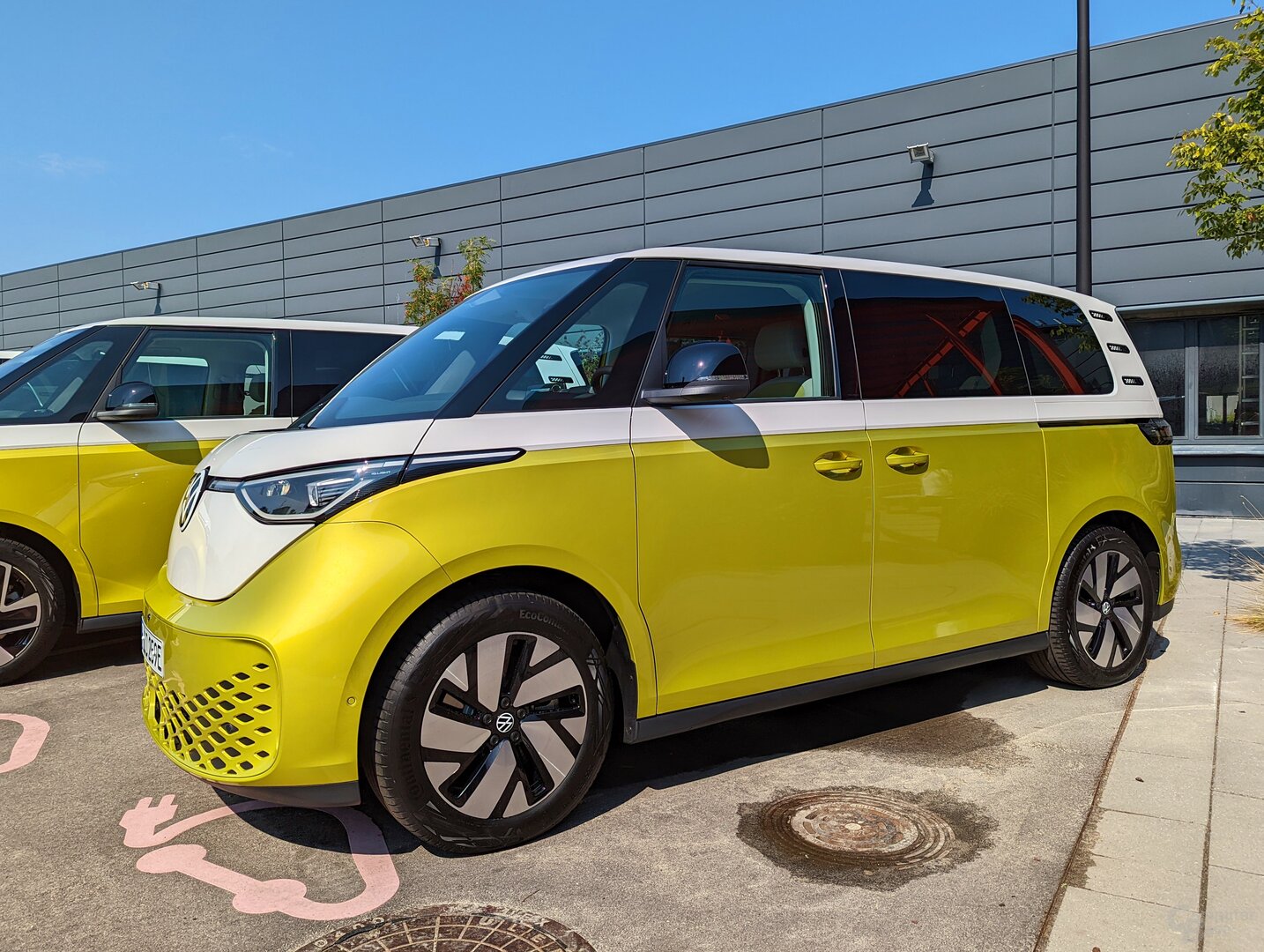 ID. Candy White and Lime Yellow Buzz
ID. Candy White and Lime Yellow Buzz ID. Candy White and Lime Yellow Buzz
ID. Candy White and Lime Yellow Buzz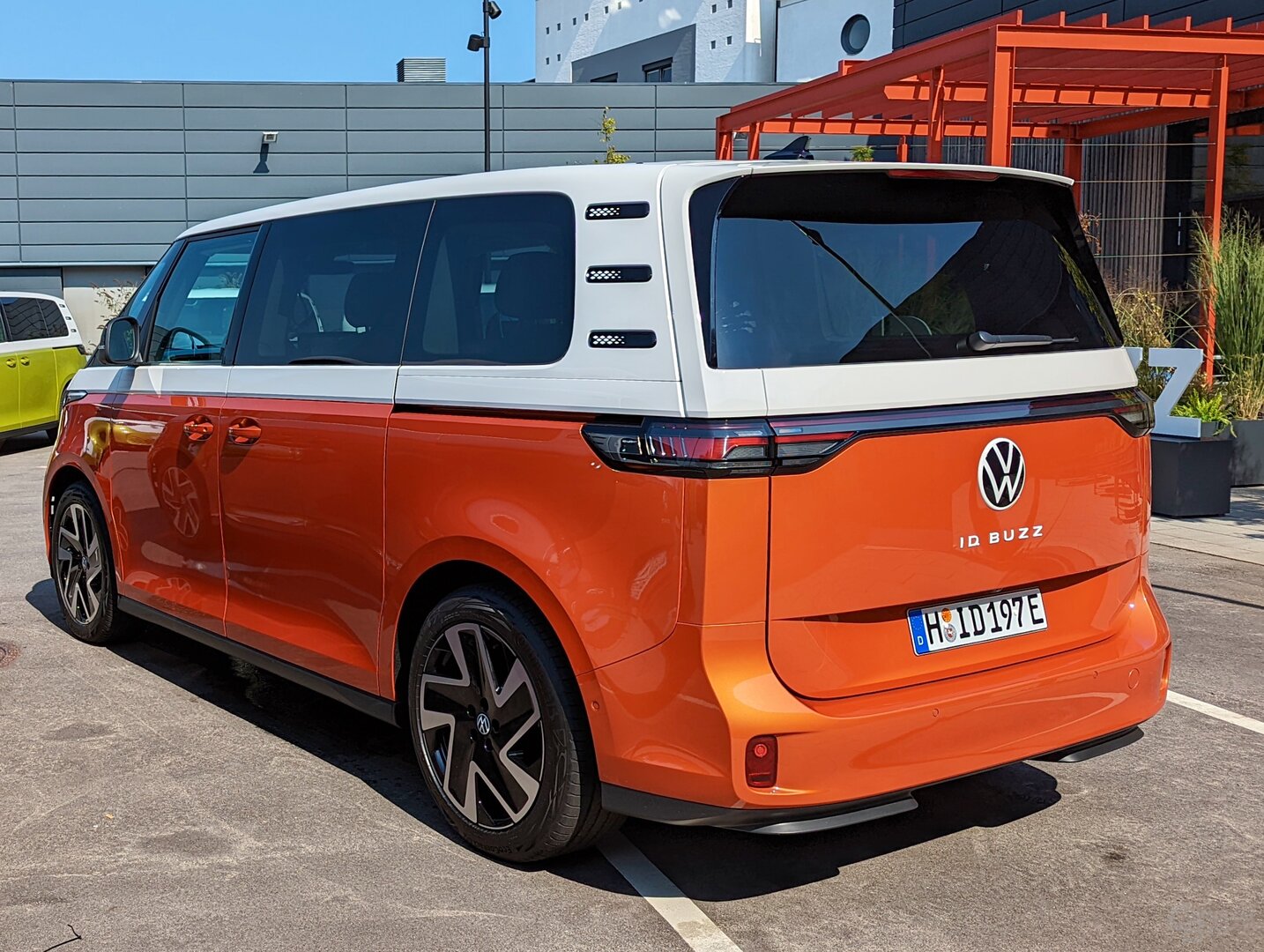 ID. Buzz in Candy White and Energetic Orance
ID. Buzz in Candy White and Energetic Orance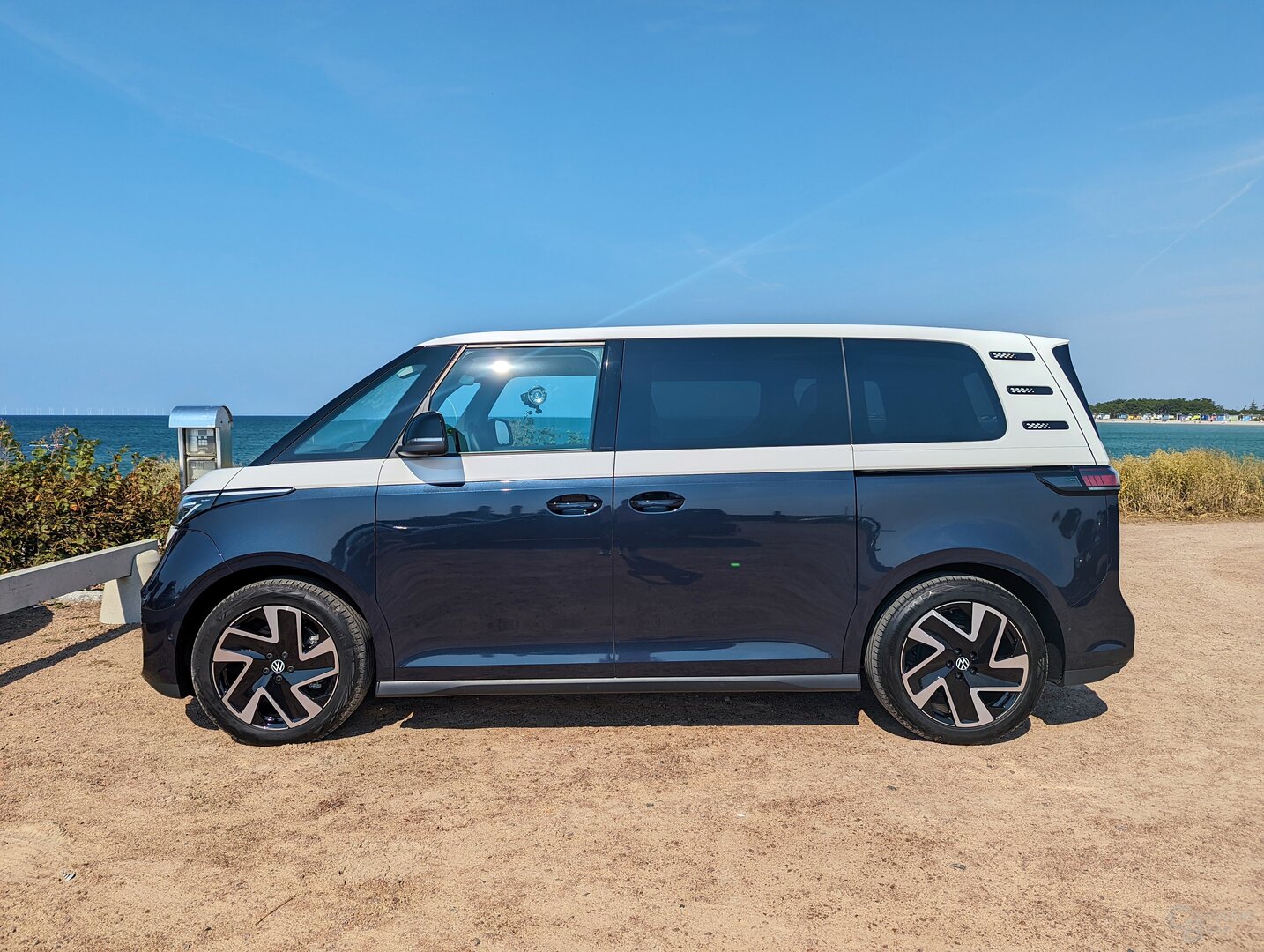 ID. Candy White and Starlight Blue Buzz
ID. Candy White and Starlight Blue Buzz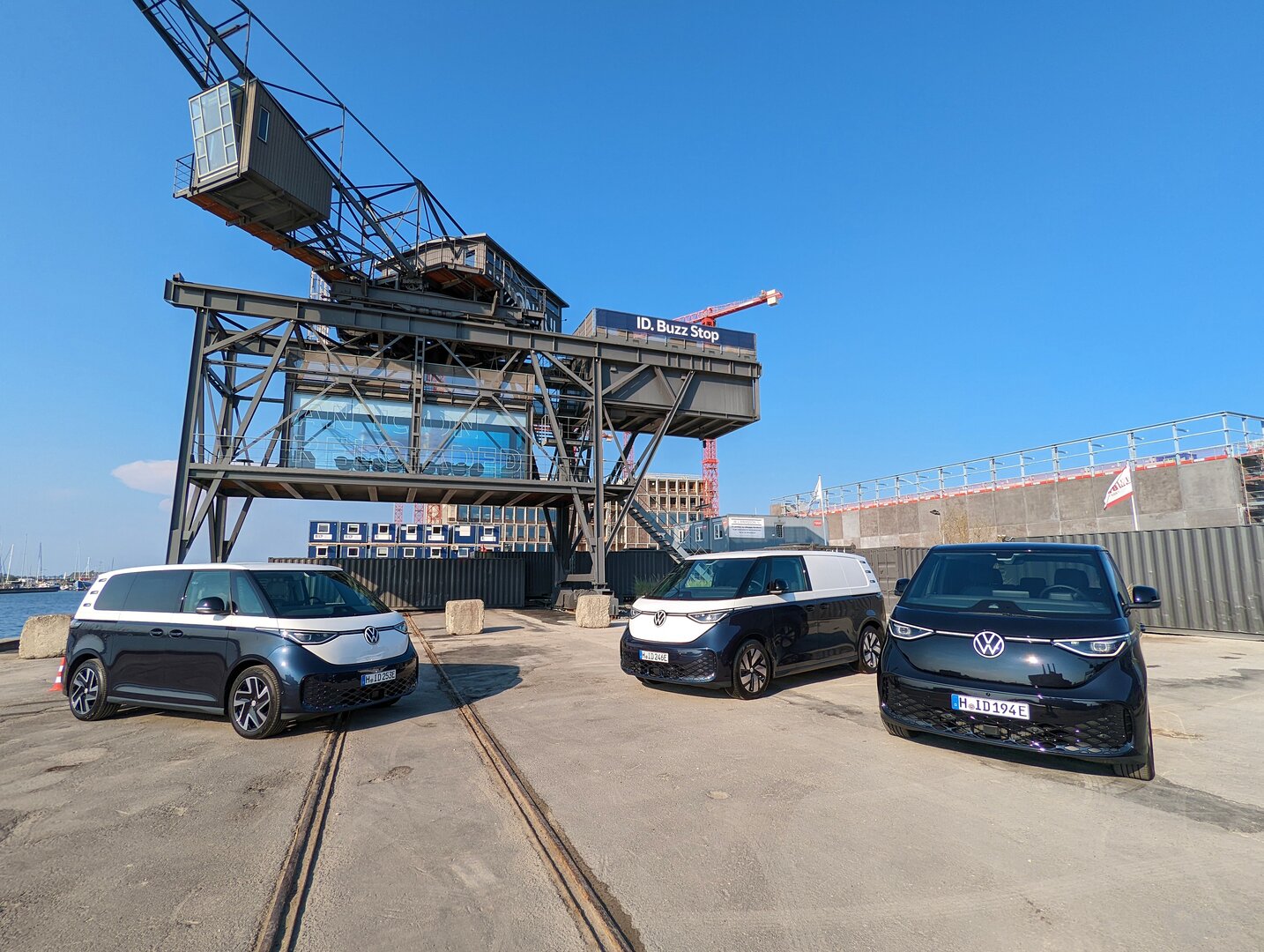 ID. Buzz and Buzz Cargo in Candy White and Starlight Blue, ID. Buzz in Deep Black Pearl Effect
ID. Buzz and Buzz Cargo in Candy White and Starlight Blue, ID. Buzz in Deep Black Pearl Effect ID. Buzz in Candy White and Starlight Blue
ID. Buzz in Candy White and Starlight Blue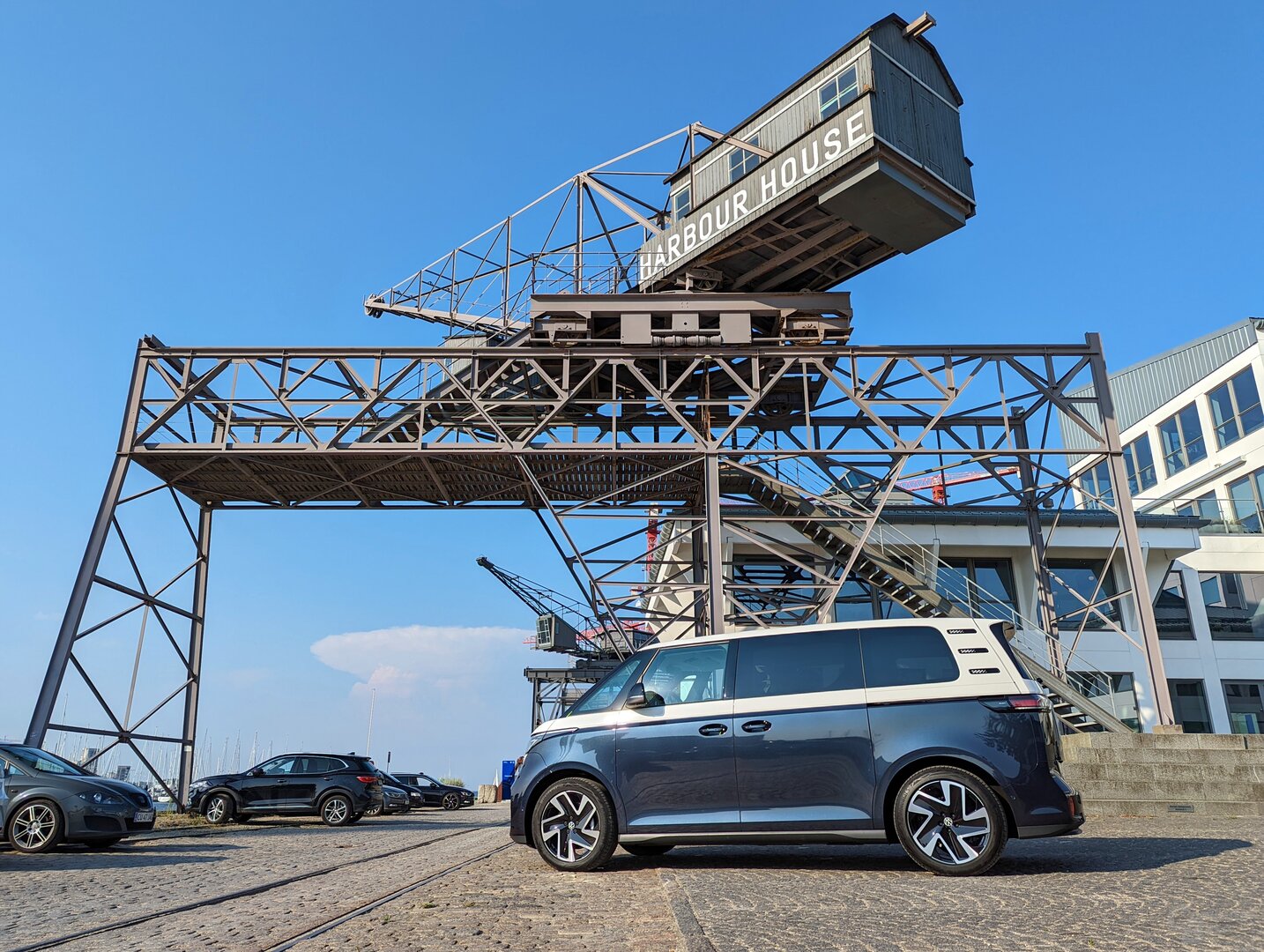 ID. Candy White and Starlight Blue Buzz
ID. Candy White and Starlight Blue Buzz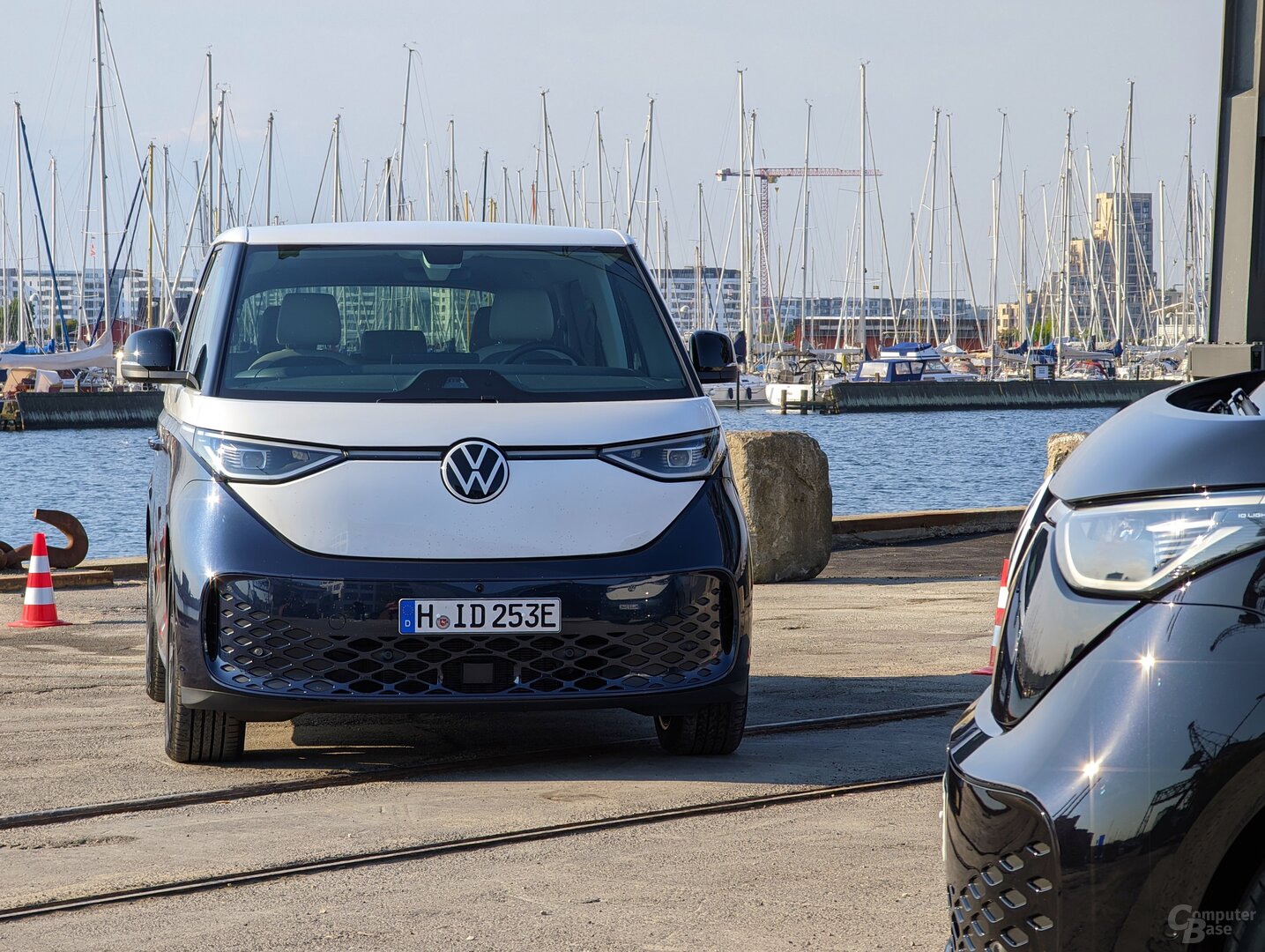 ID. Buzz in Candy White and Starlight Blue
ID. Buzz in Candy White and Starlight Blue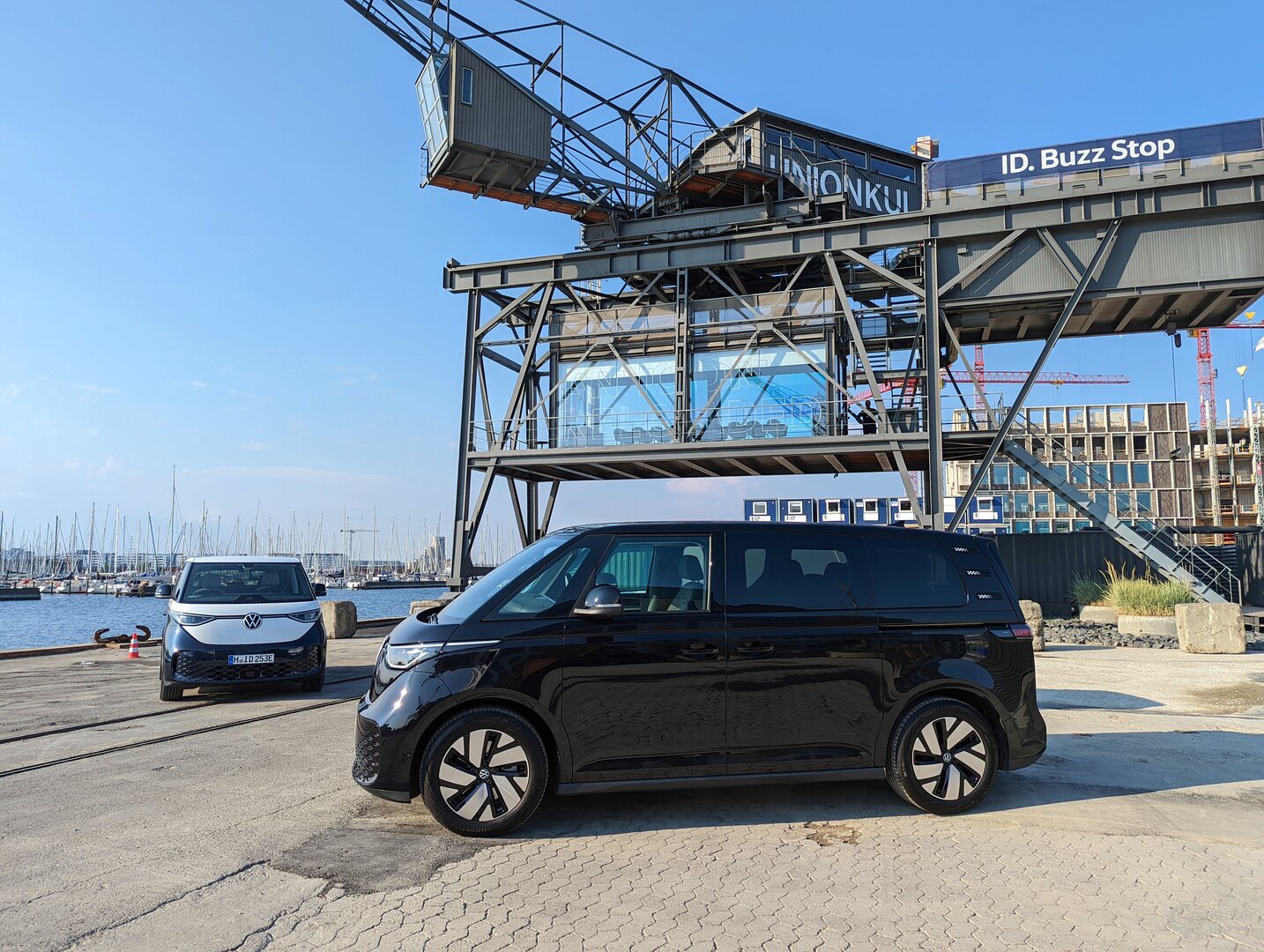 ID. Buzz in Deep Black Pearl Effect
ID. Buzz in Deep Black Pearl EffectThe beefy Bulli is wider than it is high
Painted in one color, the Bulli looks even beefier than it already is. Because in terms of dimensions, the ID. Buzz is definitely not a T1, even if he would like to be. The ID. Buzz is fed up with the road, which is also helped by the fact that the bus is wider than it is tall. The car measures 4,712 × 1,985 × 1,927 – 1,951 mm (L × W × H) – minus the exterior mirrors, mind you. It is 2,212 mm including the mirrors, which makes the Bulli a fright on any construction site, where the restriction is usually 2 m wide. That with the ID. Buzz can get tight from time to time and tact is required when steering, as was repeatedly demonstrated in the test on small streets and alleys in Copenhagen and Malmö. The curb weight is 2,471 kg, the permissible total weight is 3,000 kg (cargo: 2,353/3,000 kg). The lithium-ion high-voltage battery in the floor, divided into twelve modules, the additional units in the front end and the electric motor in the rear ensure comparatively agile driving behavior that conceals the weight well, so that the weight distribution is 50:50. There is a “frunk” with the ID. Not buzz, by the way.
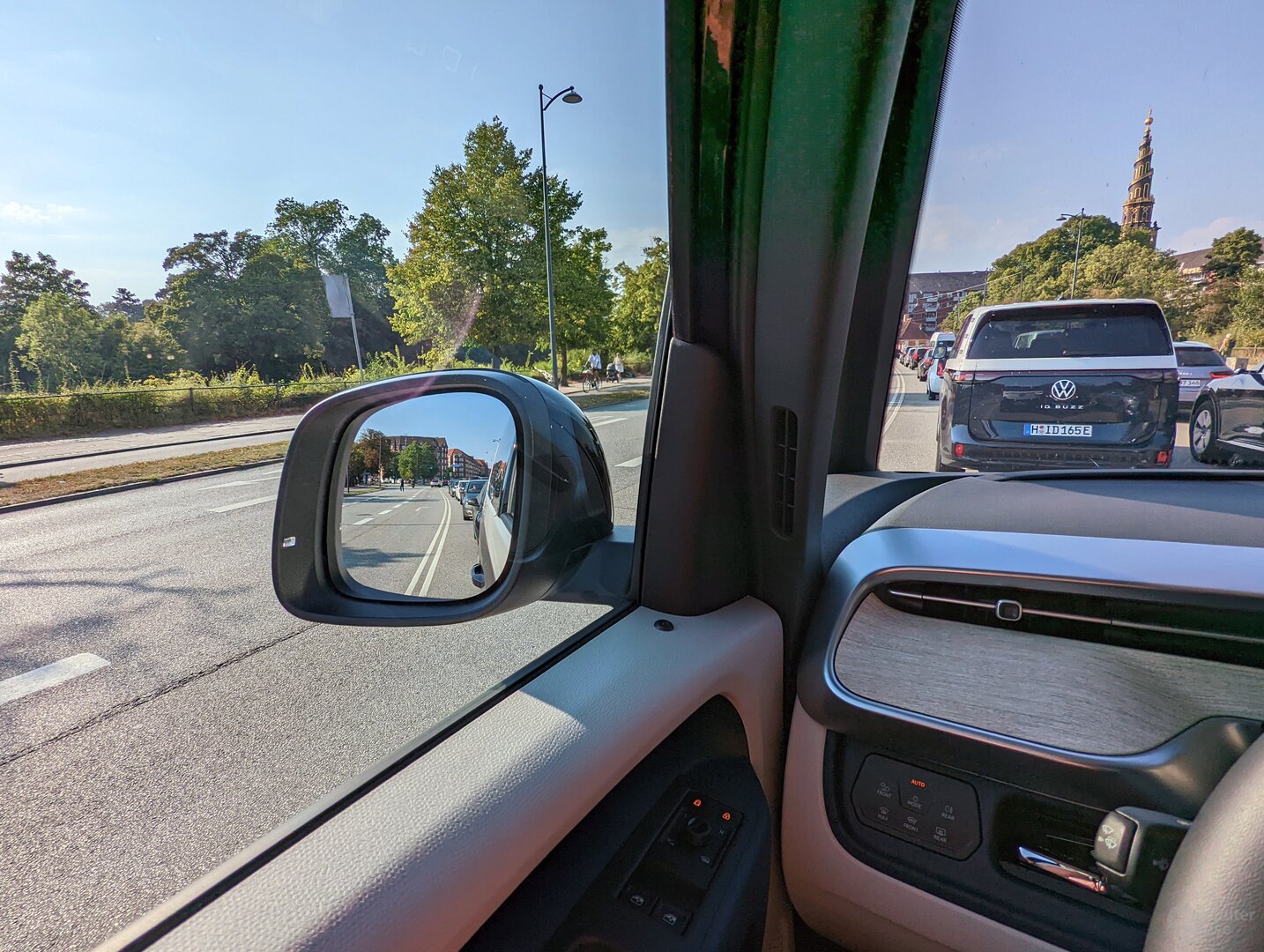 Including the mirror, the ID. Buzz 2,212mm wide
Including the mirror, the ID. Buzz 2,212mm wideThe assistance systems help with the overview
The ID However, Buzz drives anything but sluggishly and not like a “bus” in the classic sense. The all-round view in the cockpit is very good, at least in the front 180 degrees of the car, given the divided A-pillar and the large glass surfaces. However, the all-round view while driving should not be equated with the precise recognition of the dimensions when parking. Because where the car ends at the front, one can only guess in view of the view into nothing when guessing the length including the snout. The recess at the bottom of the windshield, in which VW accommodates the camera and other sensors for the assistance systems, is not exactly helpful. This “box” is usually found in the area of the rear-view mirror on other vehicles. It gets a little darker in the back of the bus, because VW doesn't offer a glass or sunroof. Only the two front windows can be opened.
-
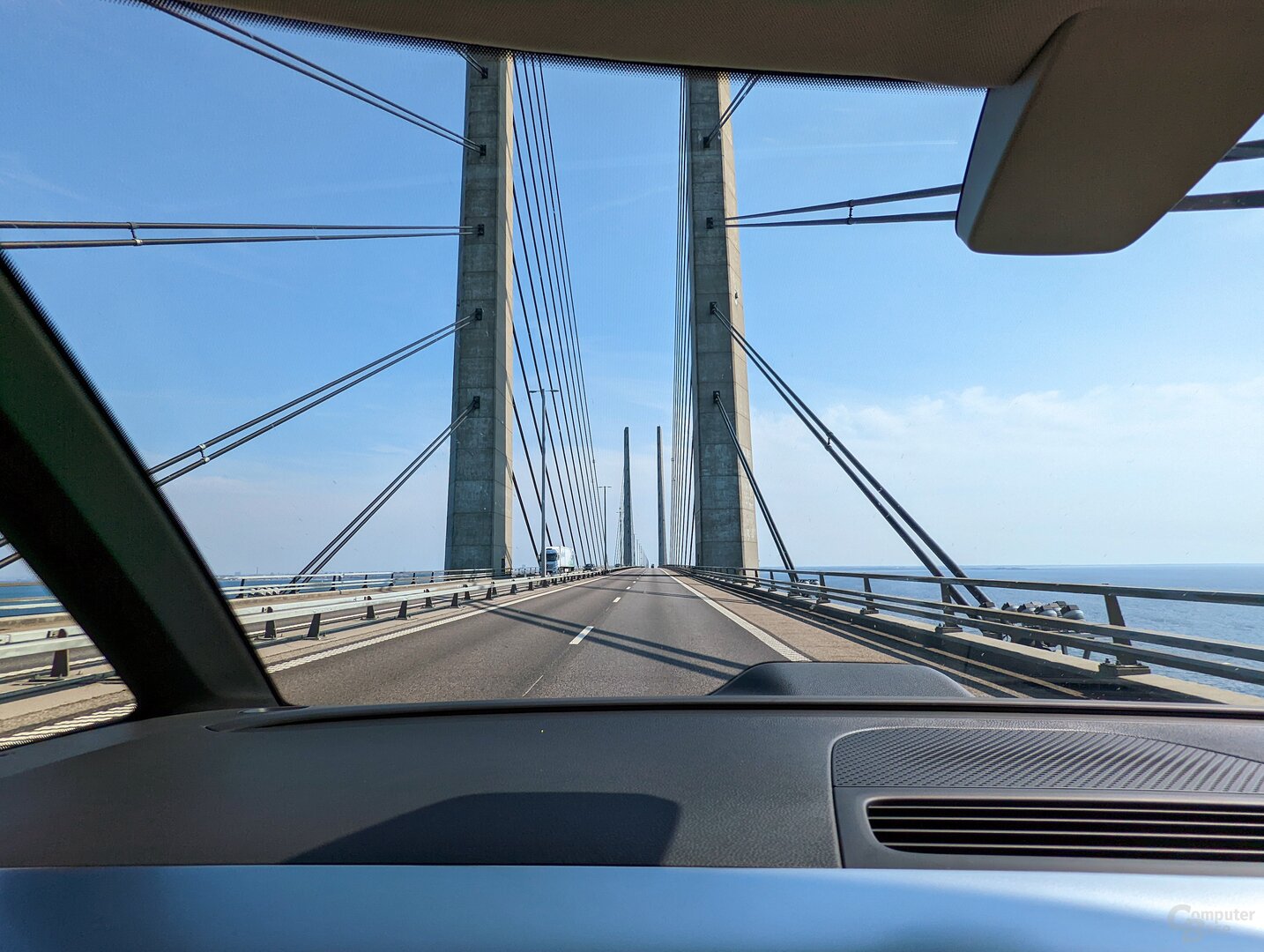 The view ahead in the ID. Buzz
The view ahead in the ID. Buzz
Image 1 of 5
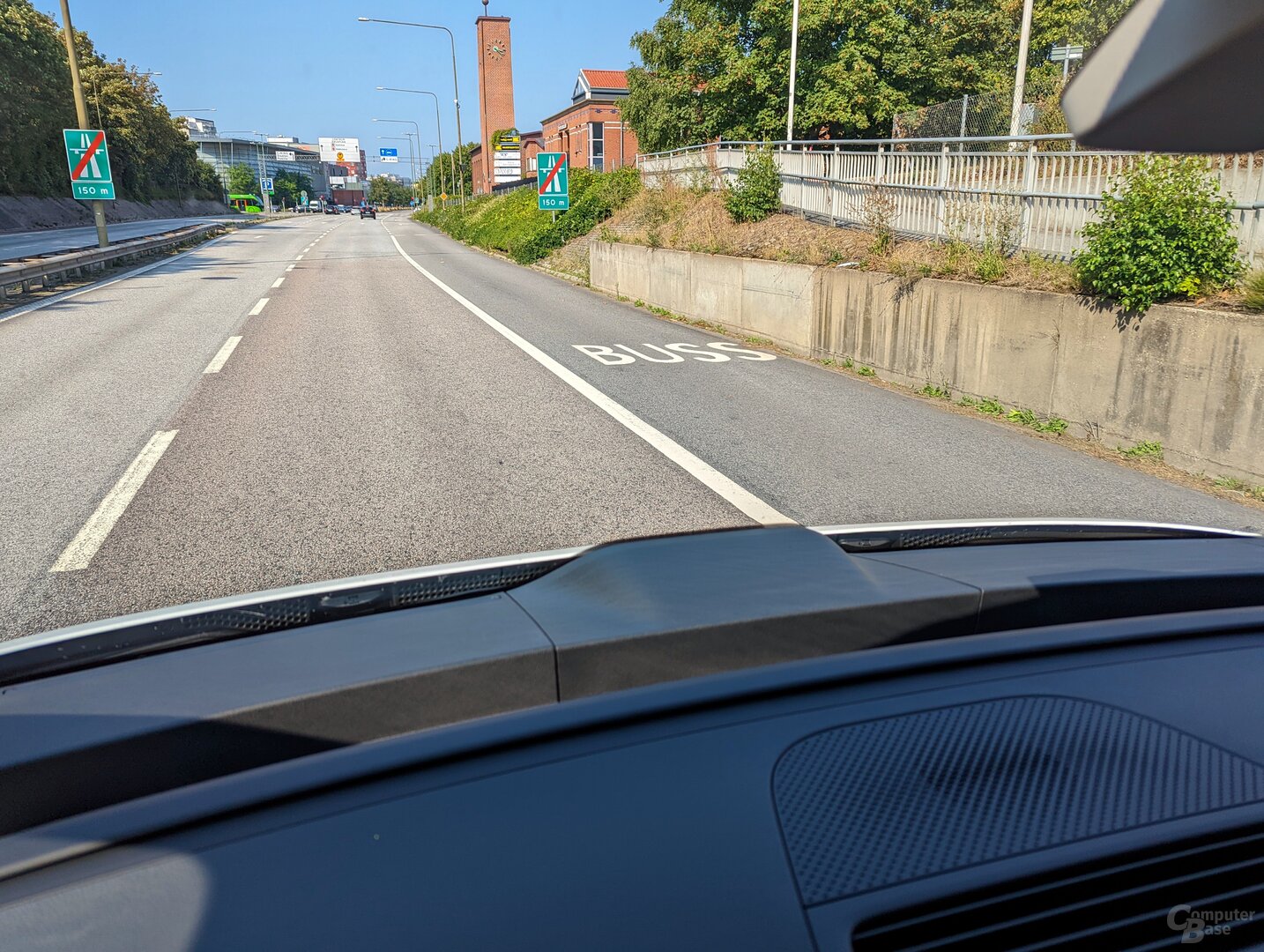 Box for sensors at the bottom of the windshield
Box for sensors at the bottom of the windshield Sensor box in the bottom of the windshield
Sensor box in the bottom of the windshield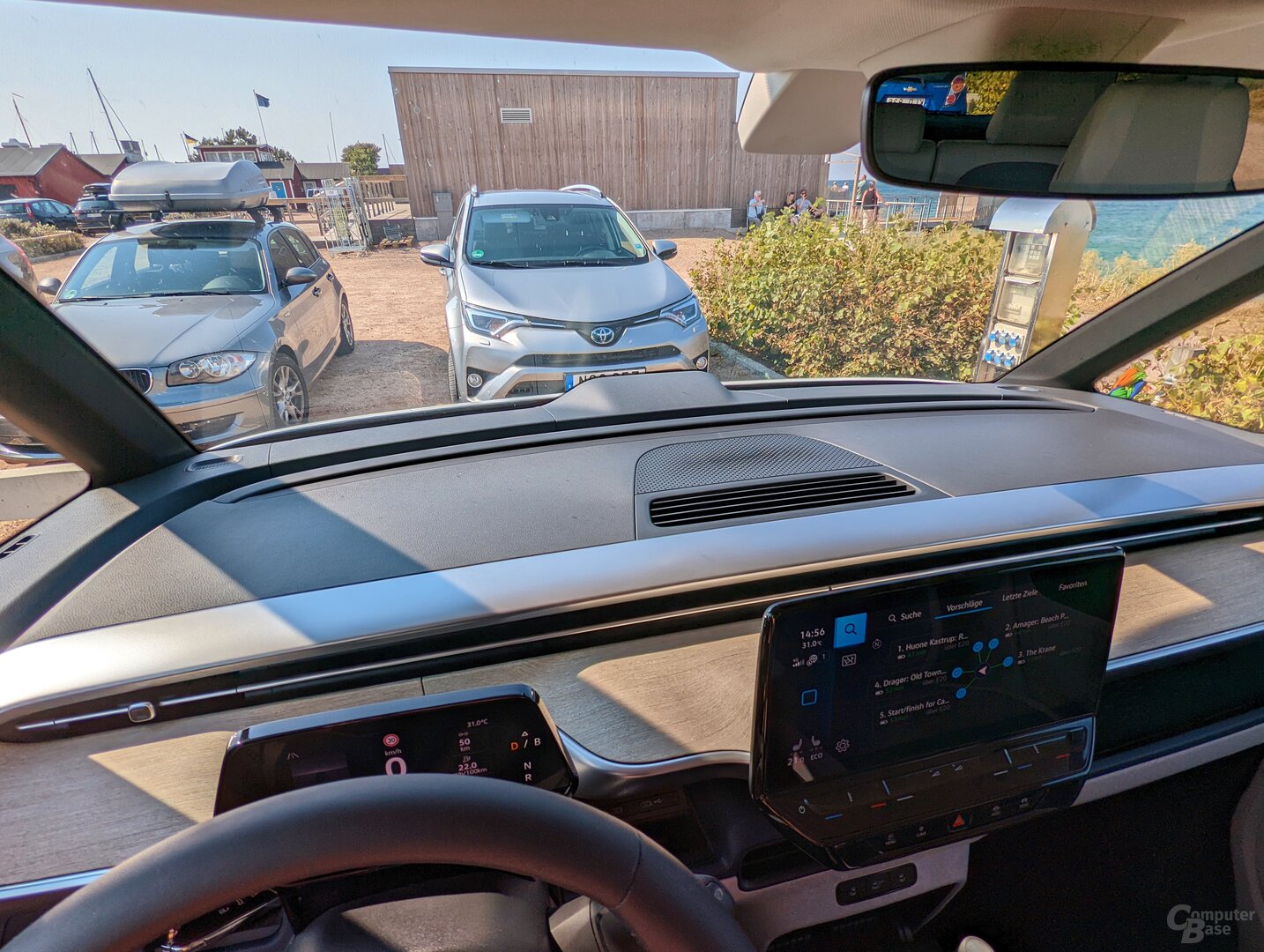 PXL_20220818_125604366
PXL_20220818_125604366Travel Assist uses swarm data
Ultimately, it is the assistance systems that ensure precise navigation of the ID. Enable buzz in tight parking spaces. In this respect, the bus is just as well positioned as the other vehicles from the ID. portfolio, both when parking and when driving. The optional Travel Assist corresponds to Level 2 and is responsible for the assisted longitudinal and lateral guidance. Using the infrared, radar and camera sensors, the ID. Buzz can maintain a desired speed or automatically follow signs, react to the speed of other vehicles and automatically follow the lane provided the driver keeps their hands on the steering wheel. Previously, lane guidance required left and right lane boundaries, but this can now also be done with lane boundaries on one side, provided there is swarm data from other vehicles in the immediate vicinity that has been transmitted anonymously to a backend system. This swarm data enables assisted lane changes on motorways from 90 km/h, which can be carried out after manually tapping the indicator.
Two assistance packages are available
The Travel Assist costs 2,374.05 euros in the “Plus” assistance package, which includes other systems such as Park Assist Plus with memory function, an alarm system, a multifunction steering wheel, illuminated door handle recesses, the view of the surroundings including a reversing camera and central locking with a keyless locking and starting system. Keyless Advanced” includes. The smaller assistance package without “Plus” for 1,386.35 euros only includes the automatic distance control, the alarm system, Park Assist Plus without memory function, a normal reversing camera, also the illuminated door handle recesses and “Keyless Advanced”. The ID. Buzz features such as Car2X, Front Assist with emergency braking function, traffic sign recognition and the “Lane Assist” lane departure warning system.
Park Assist Plus with memory function
If the cameras are not sufficient to support you when parking, Park Assist Plus helps you to park in parallel and perpendicular parking spaces by having these processes carried out automatically by the system. At least in parallel parking spaces, the ID. Buzz can also be automatically parked again. With the memory function, which ComputerBase was last able to see with the ID.5, individual parking maneuvers of up to 50 m can be stored in the system and then automatically carried out from the original starting point to the destination. This mode is suitable, for example, for narrow garages and carports, but the vehicle cannot be left. BMW offers a comparable system and wants to add a remote function to it in the future.
ID. Light has more functions
The assistance systems can also include the interactive ID. Light count, which is a narrow strip of light that VW stretches across the windshield in the driver's field of vision and provides the driver with visual information. The position of the light signal corresponds to the position of a potential source of danger, such as hidden obstacles when parking. A completely red light, on the other hand, signals a critical situation and prompts you to brake before systems such as Front Assist intervene. Because the bus already has the ID. Software 3.2, the ID. Light extended functions such as the warning of breakdown vehicles, accidents and emergency vehicles using Car2X. A new feature is a visual lane change recommendation, for which the ID. Light issues an early warning on the relevant lane.
Infotainment system with ID. Software 3.2
That the ID. Buzz is, to put it bluntly, just another ID. model with familiar components, only now available in bus format, shows the infotainment area, which is served as standard by a 10-inch display on which the ID. Software 3.2 is running. The “Plus” infotainment package installed in the test car for 1,517.25 euros leads to an upgrade to 12 inches and enables inductive charging of the smartphone in a compartment to the right of the steering wheel and includes the “Discover Pro” navigation system. However, if you want to use Android Auto or Apple CarPlay wirelessly, you don't have to purchase this package, because both variants are on board as standard.
-
The pulpit of the ID. Buzz
Image 1 of 4
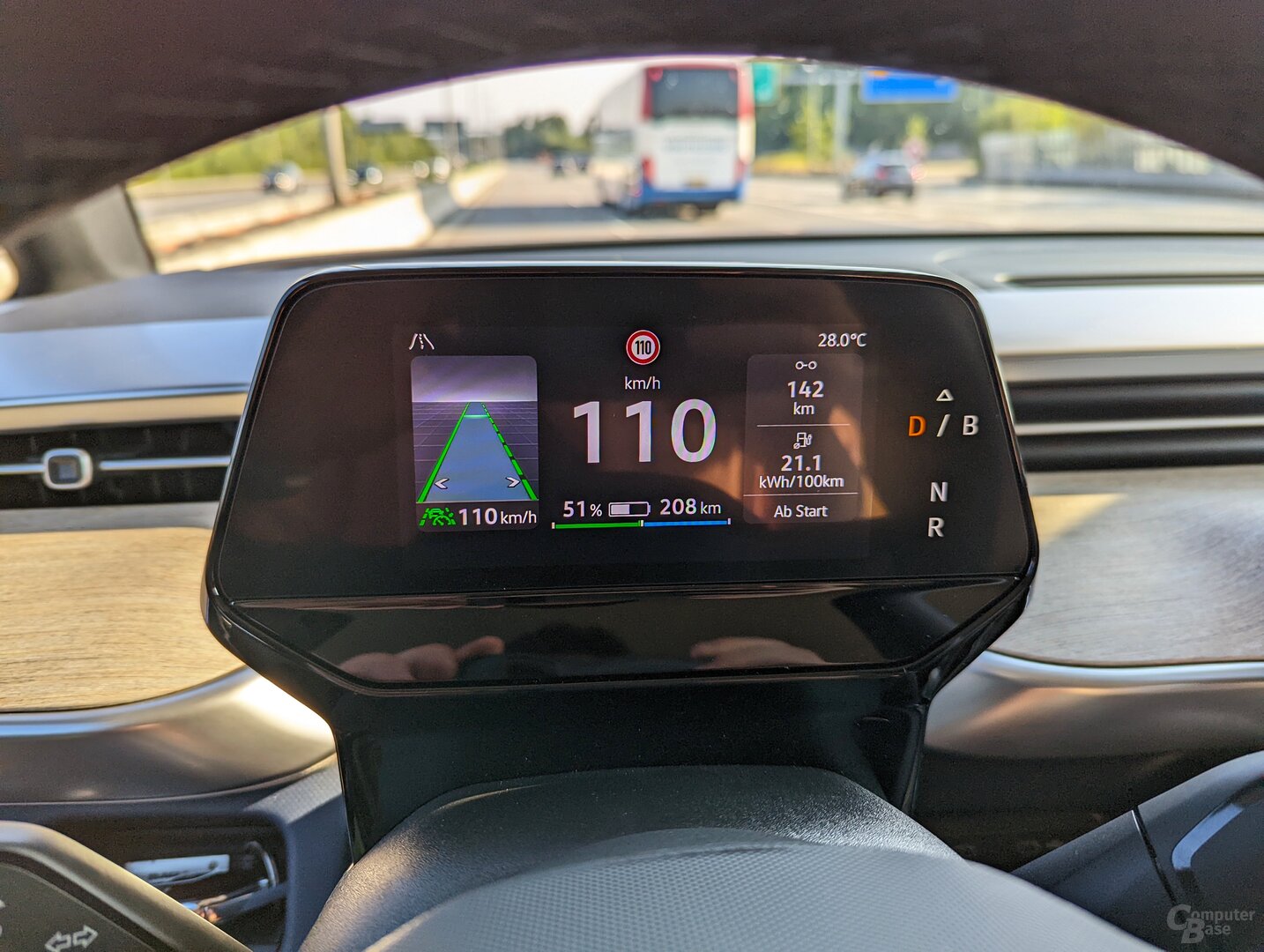 5.3 inch driver display
5.3 inch driver display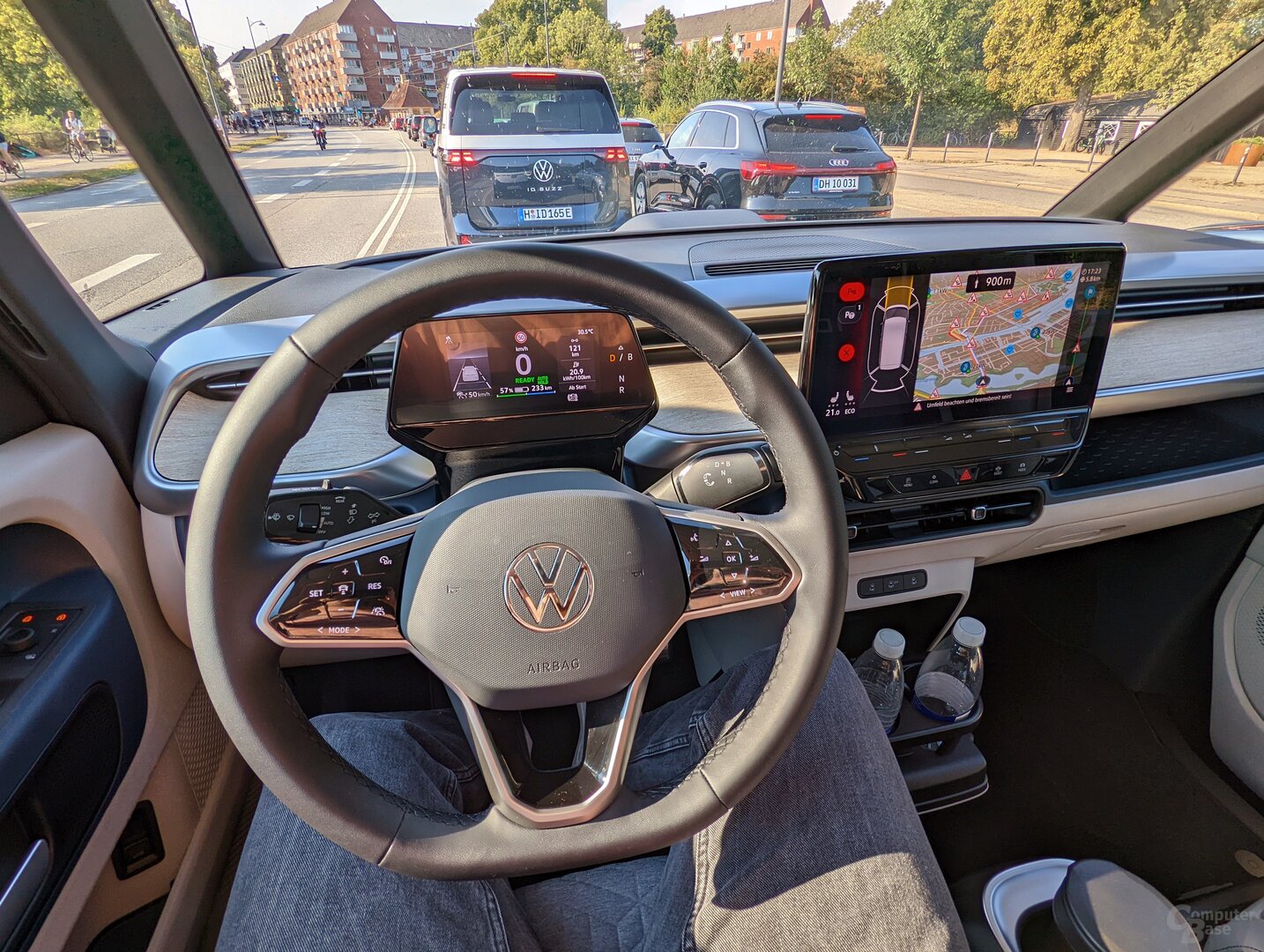 Interior of the ID. Buzz
Interior of the ID. BuzzAutomatic gear selector in new position
In front of the driver, VW is again positioning a free-standing 5.3-inch display for the most important information while driving. New for the ID. Buzz: The selector lever for the automatic transmission is no longer attached to the driver's display, which makes the component appear significantly less bulky as a whole. The gear selector is now on the right as a pitman switch, but it still has to be turned, which seems counterintuitive given the new positioning as you tend to want to pull it. In contrast to the ID.5, for example, VW offers the ID. Buzz no head-up display.
Apple Music and Spotify natively in the car
During the ID.5, depending on the delivery date, with ID. Software 3.1 comes onto the market, use ID. Buzz and ID. Buzz Cargo for delivery the new version 3.2. The “Plug & Charge” can be used, in which the car and charging station communicate with each other and payment at the station is no longer necessary. The planning of long distances should also be easier by including charging stops in the route planning with an improved algorithm. Refined setting options come into play here, such as loading time optimization, so that you don't have to load unnecessarily long at the last loading stop before the destination. The ID Software 3.2 also brings Apple Music and Spotify natively into the car, so that a smartphone no longer needs to be paired. The manufacturer also promises improvements for the “Hello ID.” voice control. The crux of previous software updates has often been the need to visit the workshop, which should now finally be a thing of the past. Updates “Over the Air” (OTA) are the new standard, according to VW.
Many USB-C sockets with 45 watts
During the first trip, we liked the extensive equipment in the interior with USB-C interfaces, so that practically the driver and every passenger can supply their own devices with energy. For the driver there is a slot to the right of the steering wheel for wireless charging, which should not be used as a key compartment, however, because smaller objects can quickly disappear permanently in the depths of this storage area. A smaller open compartment to the left of the steering wheel and the light controls is better suited for the key. There are eight USB-Cs in the ID. Buzz, in the cargo version there are still five interfaces. There are two sockets to the right of the steering wheel, one in the passenger door, another in the rear-view mirror mount depending on equipment, two in the rear in the standard sliding doors and two more in the luggage compartment. With the exception of the connection in the rearview mirror (15 watts), all USB-C sockets offer USB Power Delivery with 45 watts. A 230-volt socket in the front passenger seat frame is optional and can also be used when the drive unit is switched off. In the cargo model, however, one would have preferred this socket to be in the hold and maybe two of them.
-
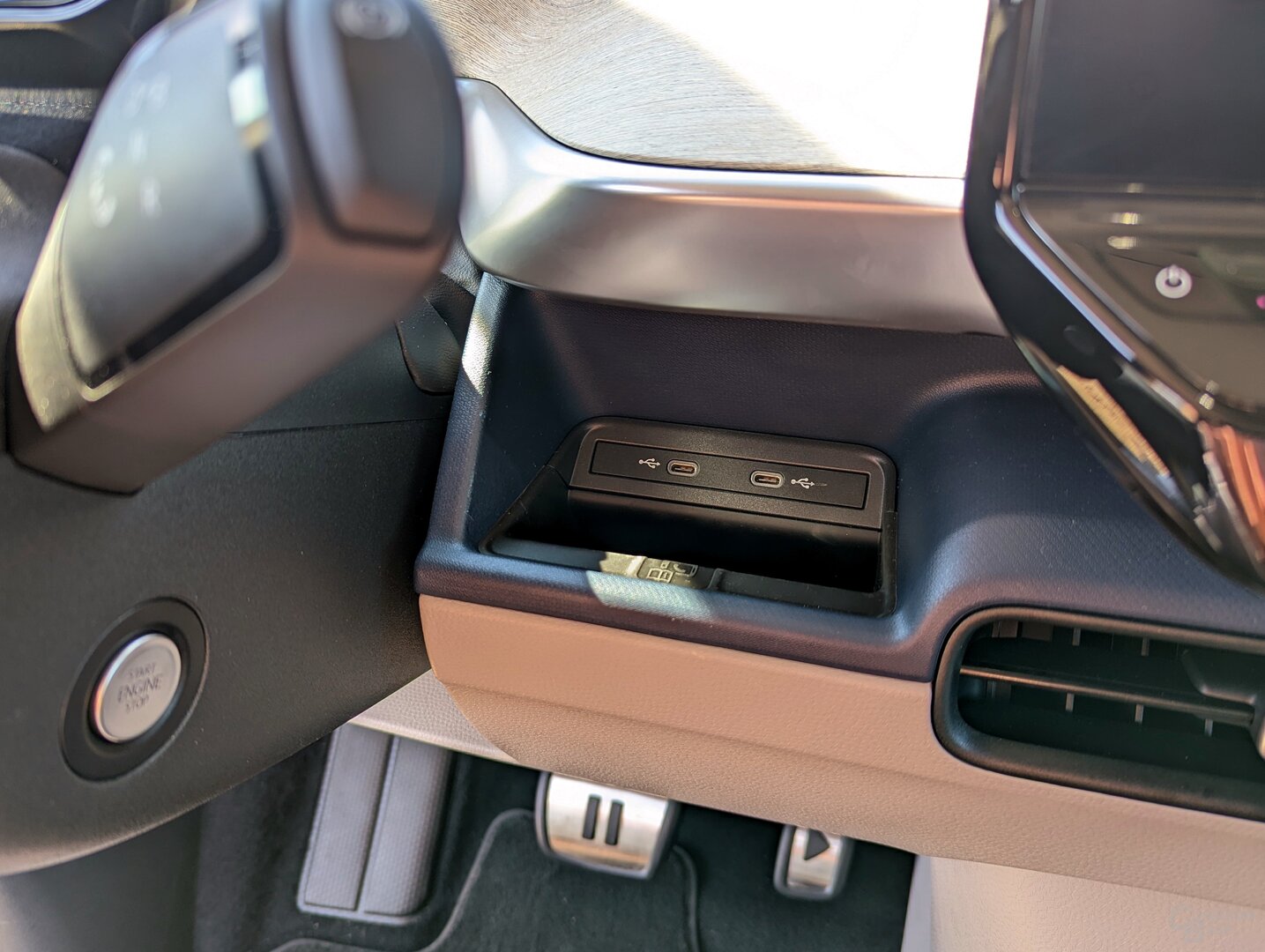 USB-C and compartment for inductive charging
USB-C and compartment for inductive charging
Image 1 of 5
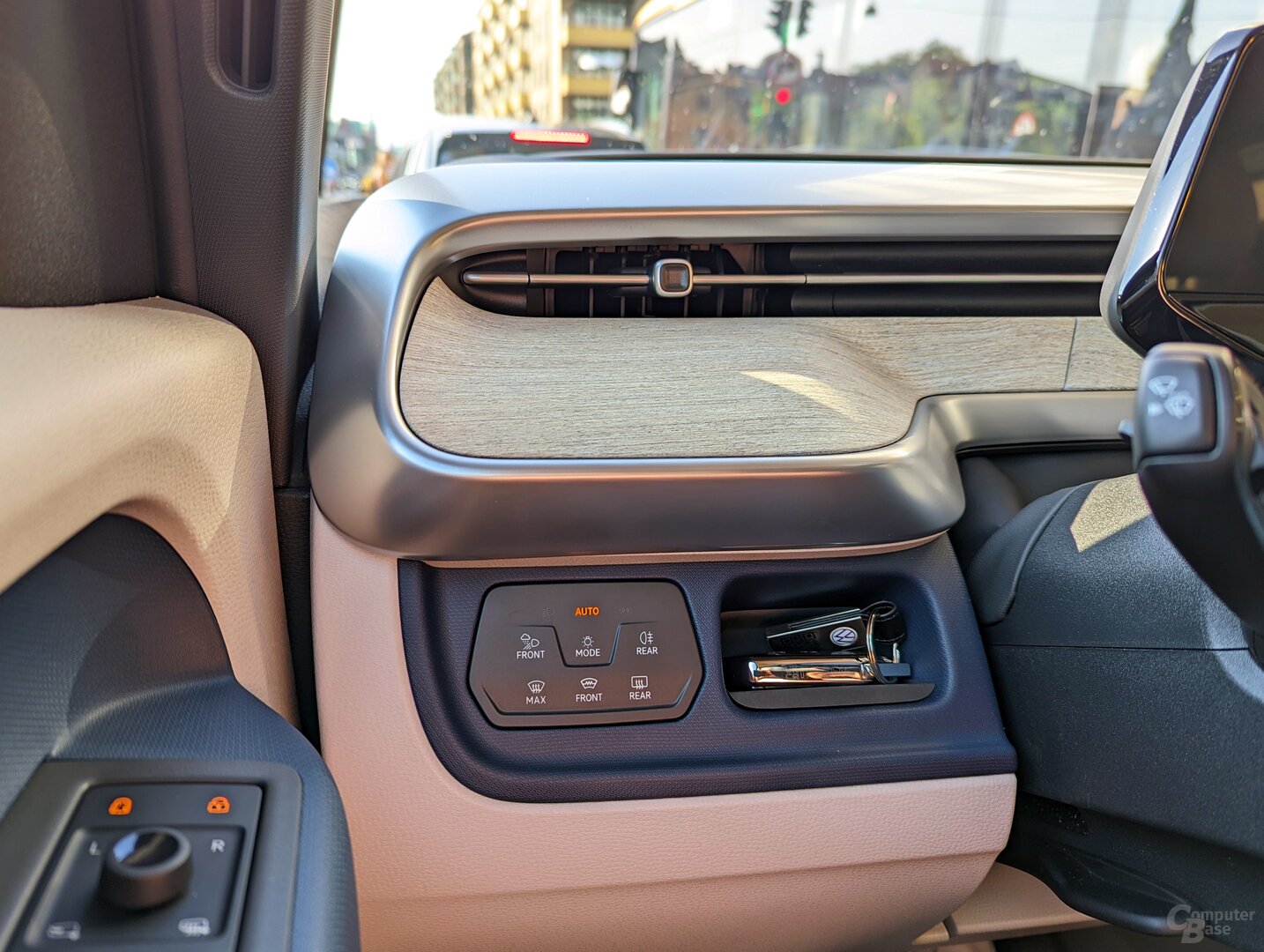 The key compartment
The key compartment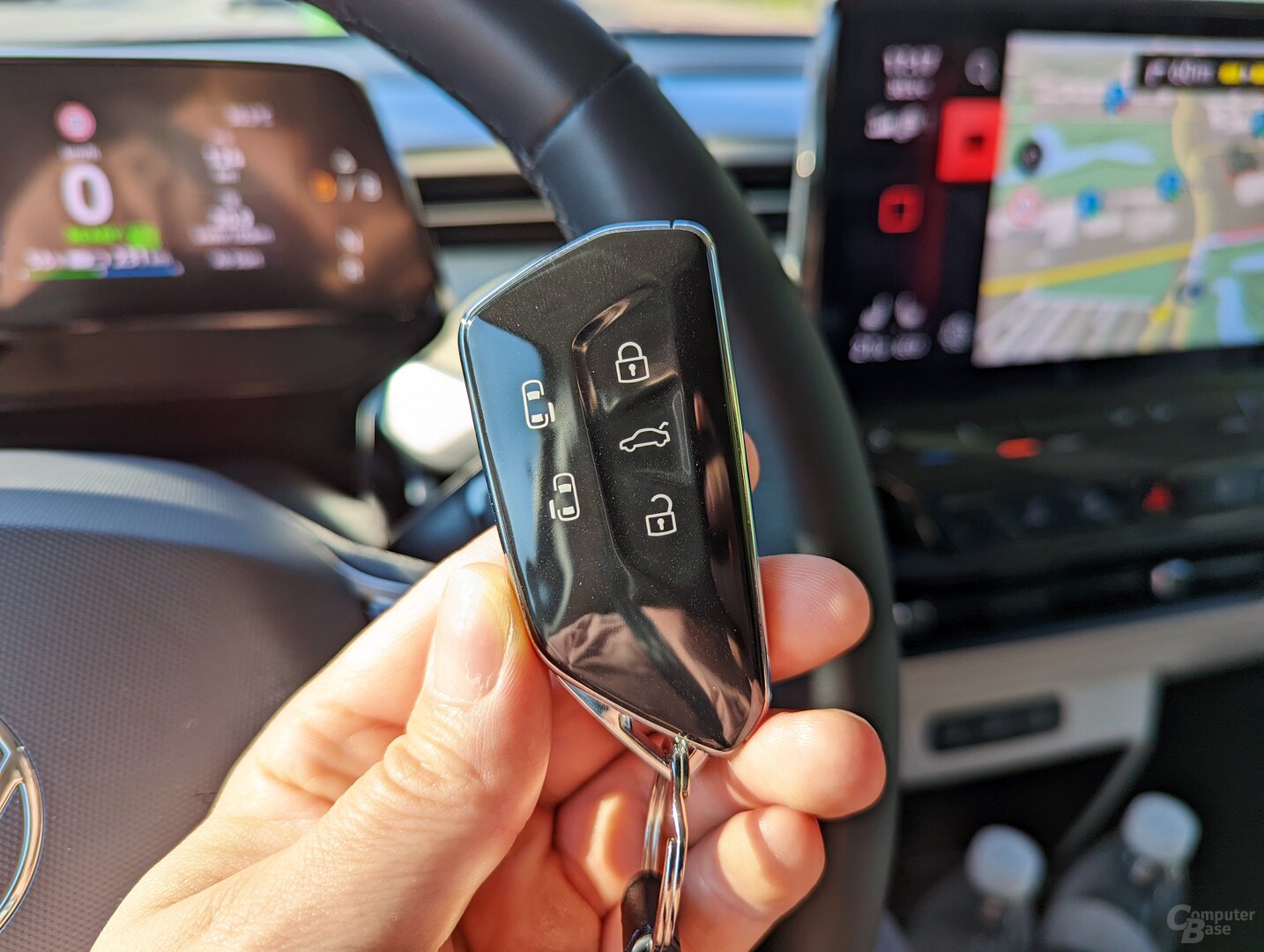 Key including remote control for the sliding doors
Key including remote control for the sliding doors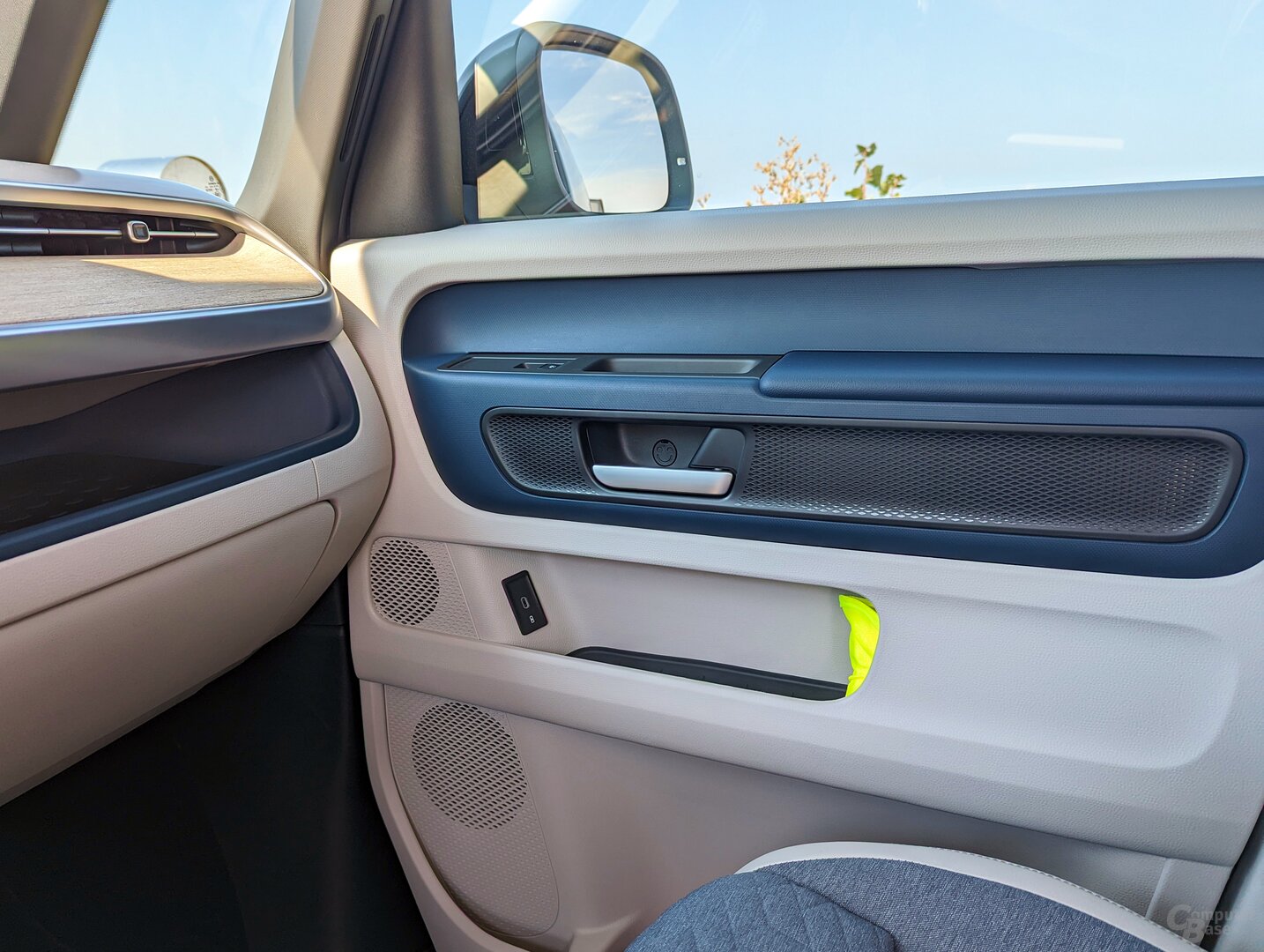 USB-C in passenger door
USB-C in passenger door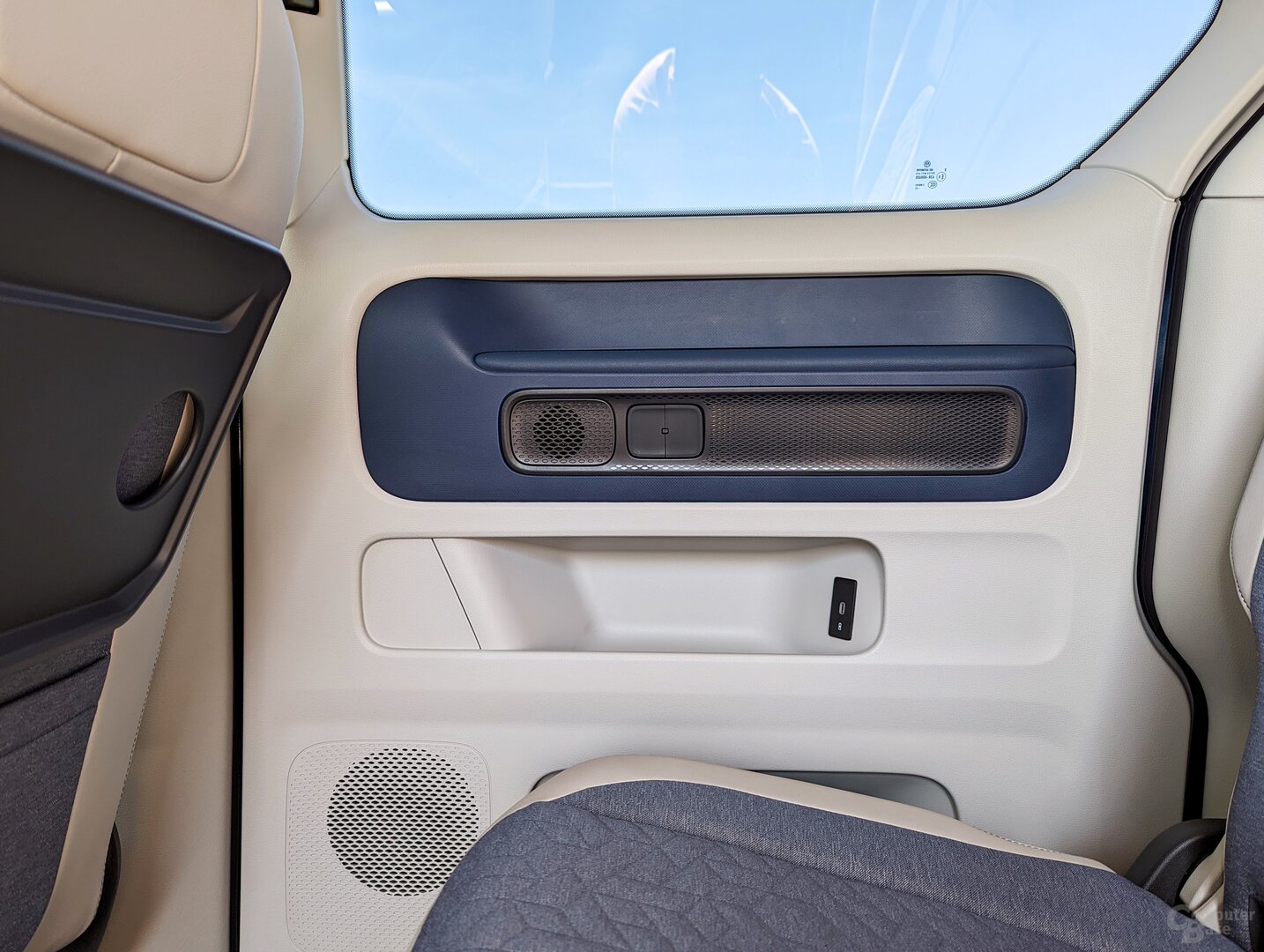 USB-C in the rear sliding doors
USB-C in the rear sliding doorsID. Buzz starts as a five-seater in Germany
Otherwise, the interior is not lacking in clever details. This starts with details such as the smiley face in the front doors, behind which the access point for the door panels is hidden, continues with the drawer in the center console, where an image of the ID. Buzz study can be found, and continues in the load compartment with the same illustration and finally ends with the rear window, which shows a small umbrella in the black frame in the area of the windshield wiper and the bus again. The fact that the engineers also paid attention to small details elsewhere is shown by the parking sensors in the red lights on the rear bumper, which are made in the same color as the light itself, instead of VW simply taking any black or gray component .
- < figure class="gallery__figure">
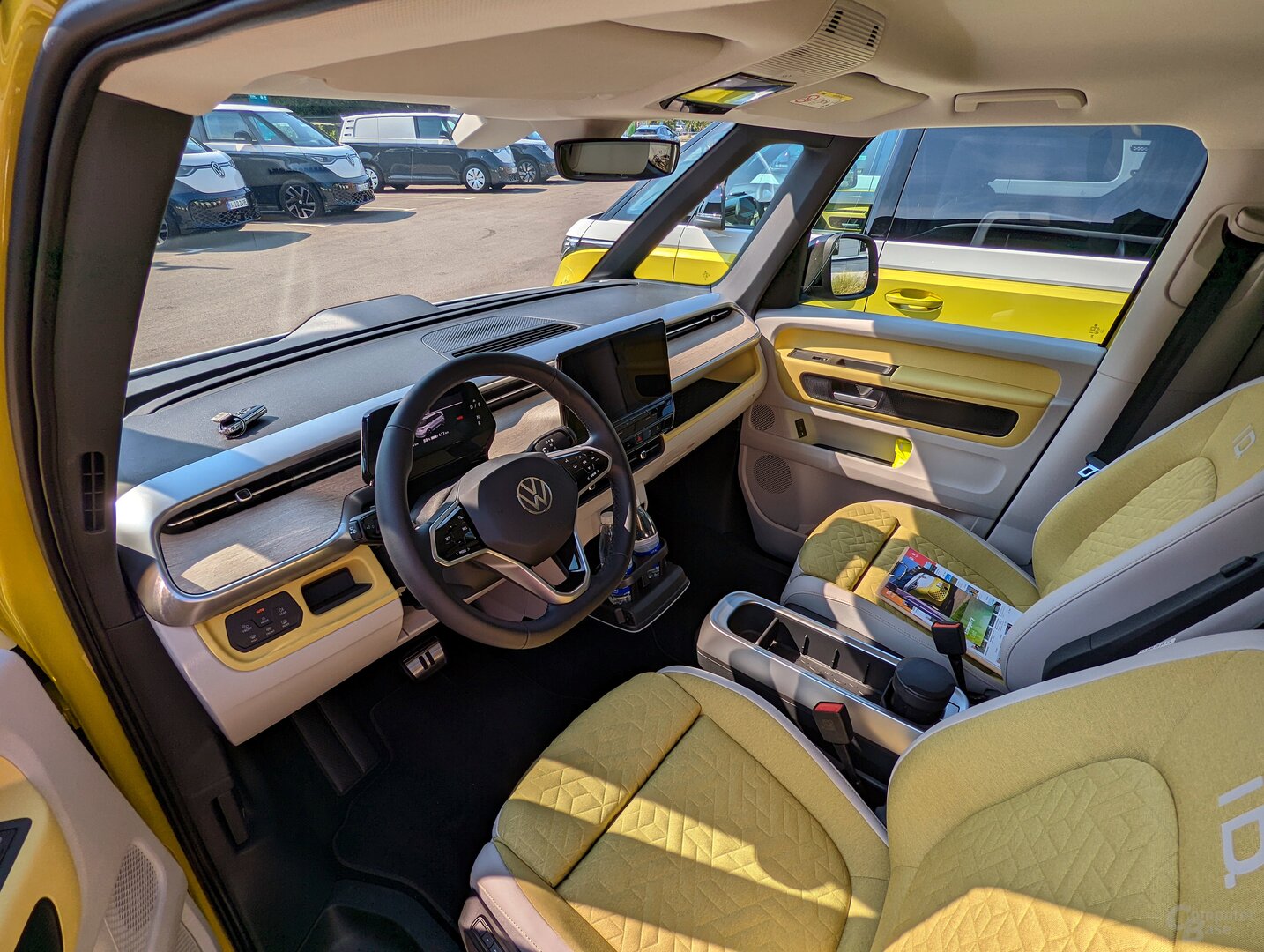 The interior of the ID. Buzz
The interior of the ID. Buzz
Image 1 of 9
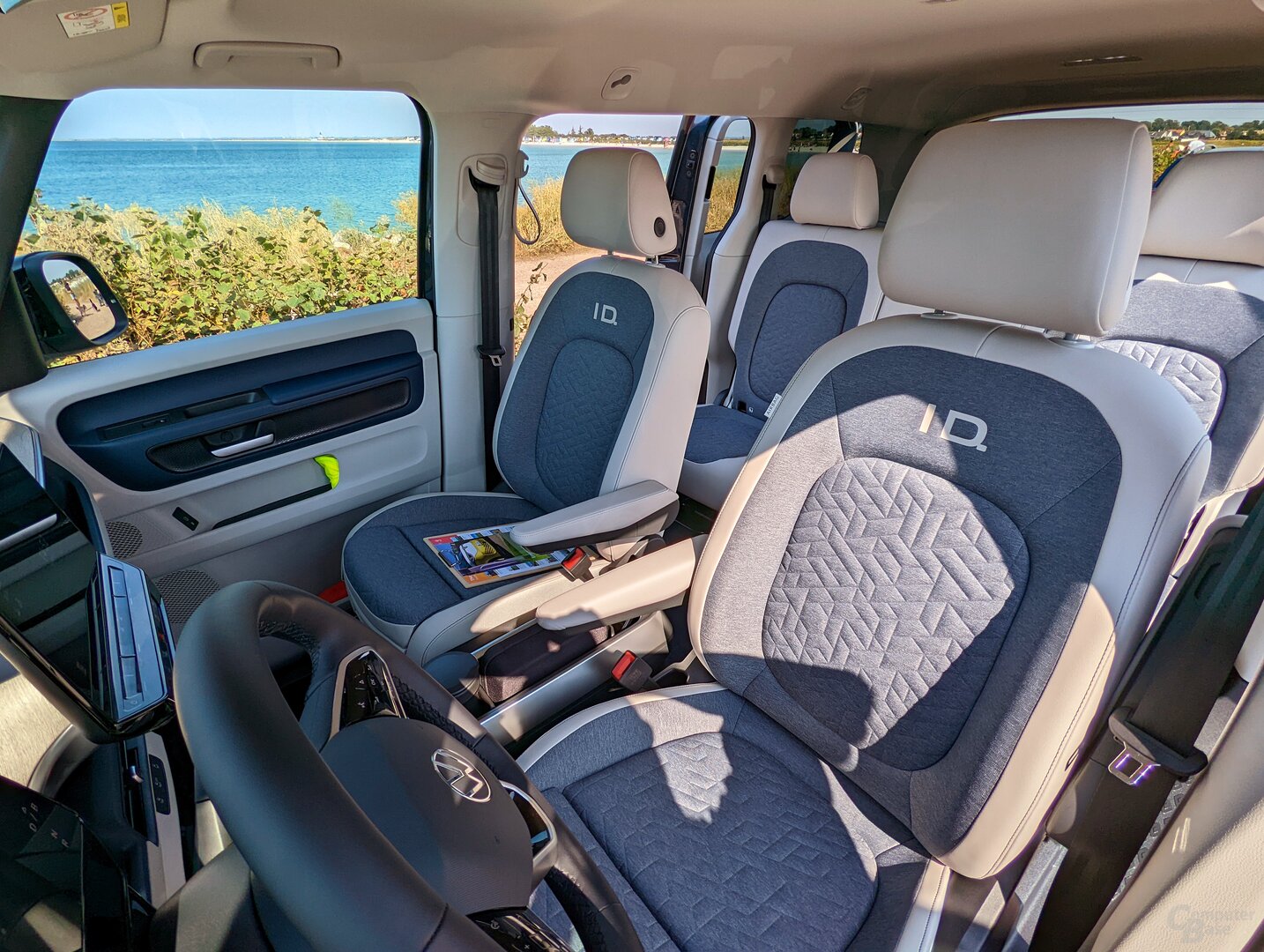 The interior of the ID. Buzz
The interior of the ID. Buzz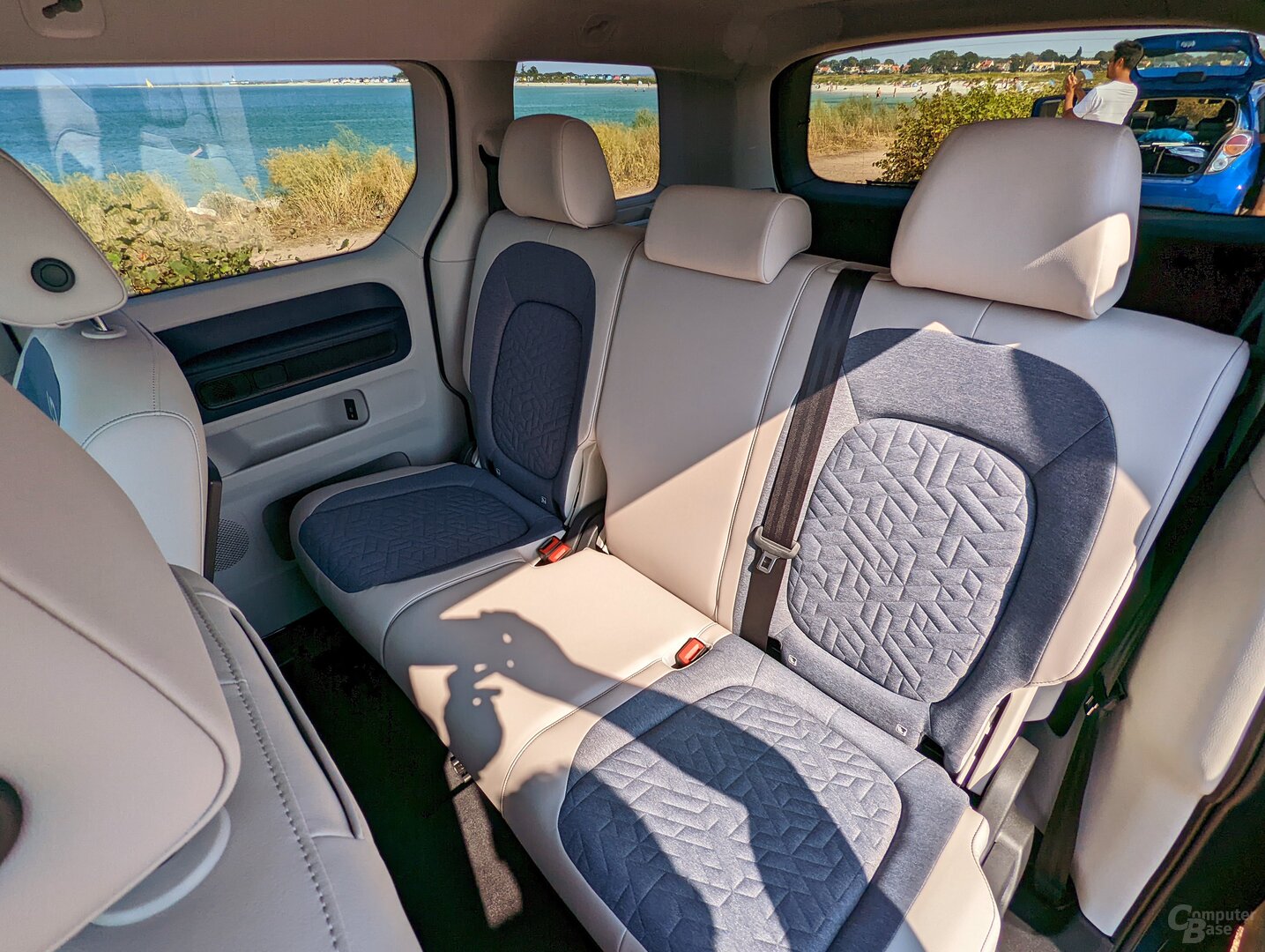 The interior of the ID. Buzz
The interior of the ID. Buzz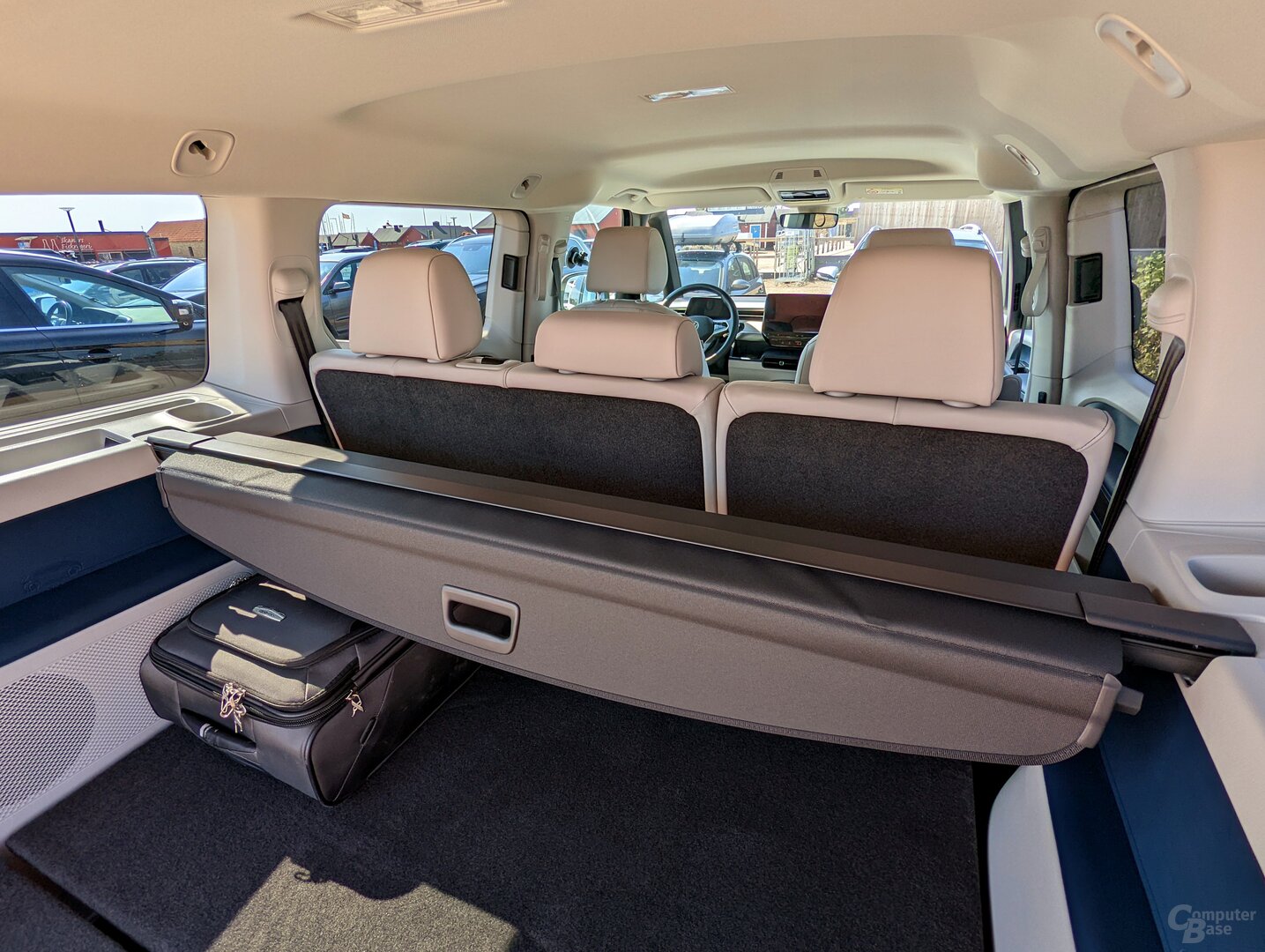 Cargo hold of the ID. Buzz
Cargo hold of the ID. Buzz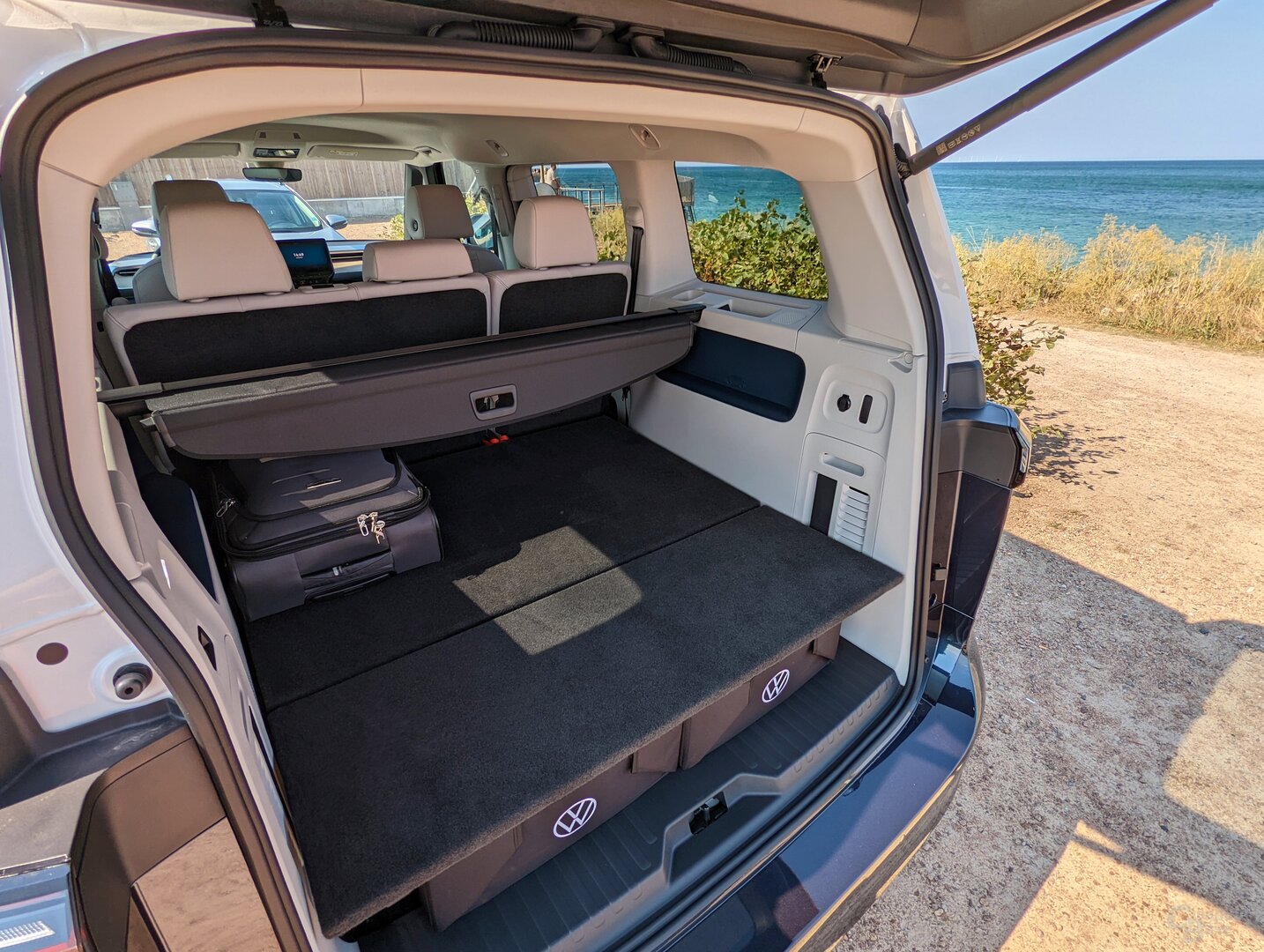 cargo space of the ID. Buzz
cargo space of the ID. Buzz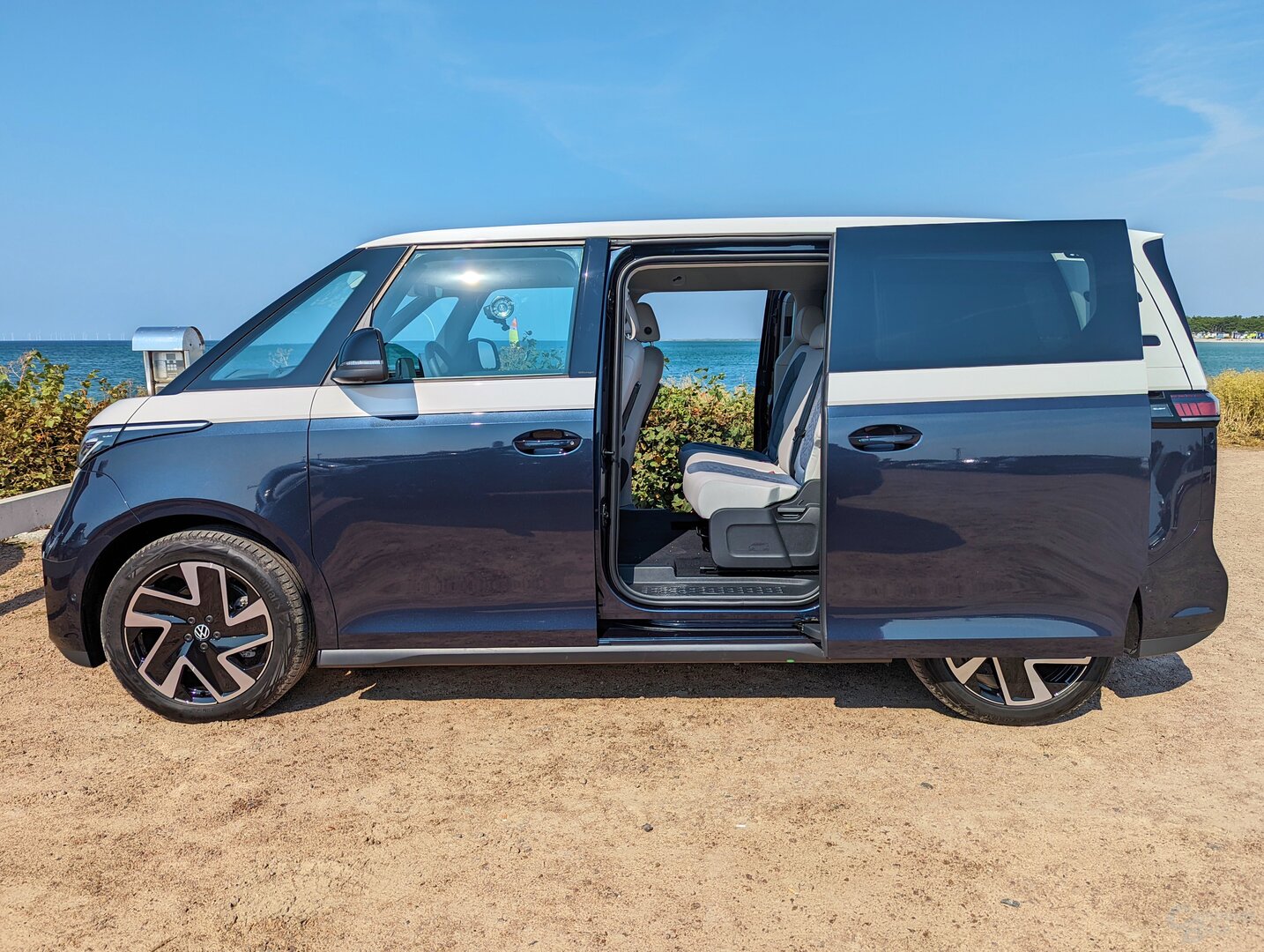 Two electric sliding doors
Two electric sliding doors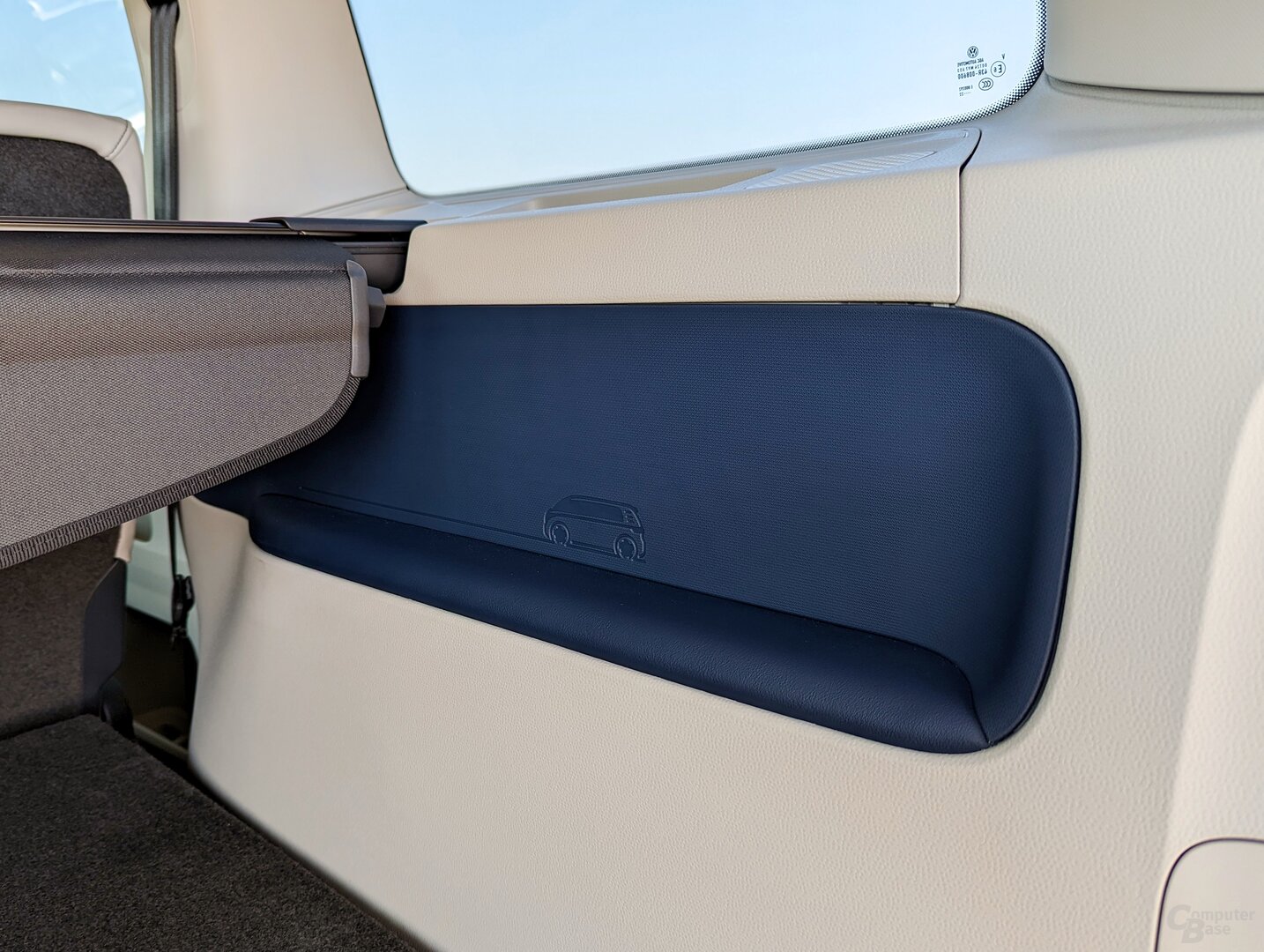 Clever details in the hold
Clever details in the hold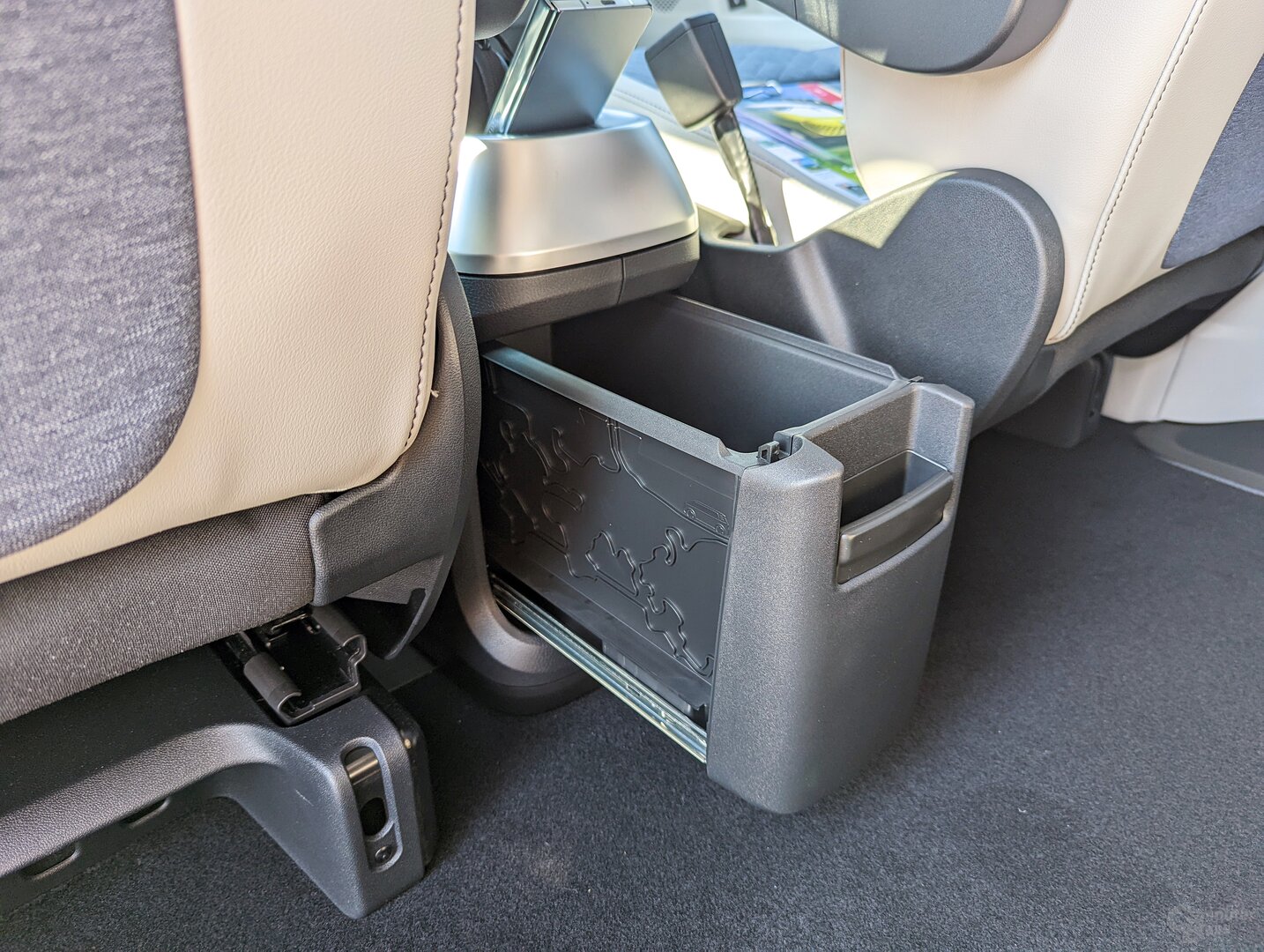 Rear drawer
Rear drawer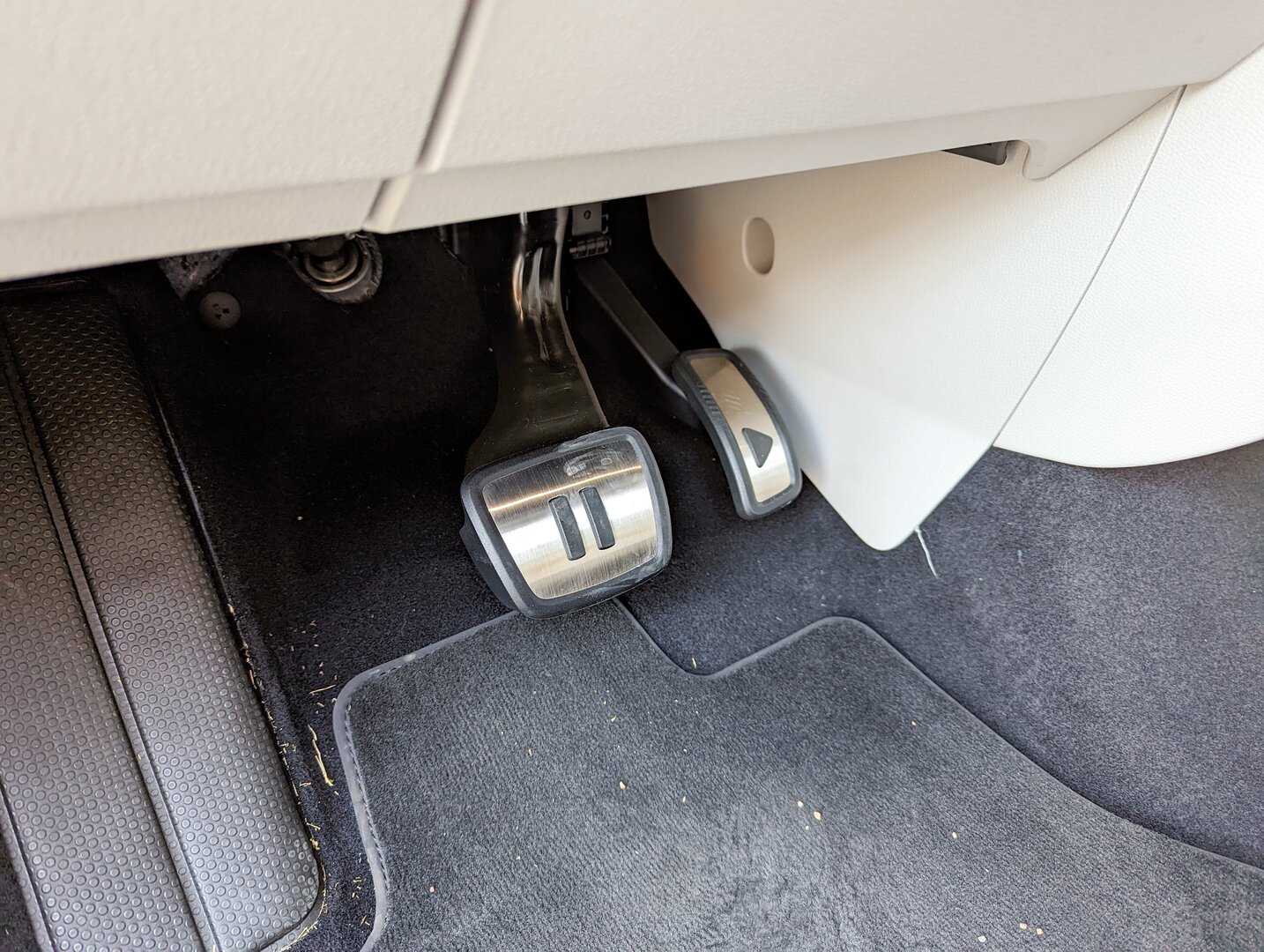 Pedals with play and pause symbols
Pedals with play and pause symbolsSeven-seater with longer wheelbase in planning
In countries other than Germany, the ID. Buzz further details of the striking exterior to show off even more. For the US market, the large VW logos on the snout and boot lid should be allowed to light up while driving. In Germany, however, they don't even do this when stationary. In the USA, the ID. Buzz will only be offered in the long-wheelbase version, after the corresponding model is to be presented next year, on which the California will later be based. This variant offers space for seven people instead of five, with two additional seats following the two individual seats in the front and the bench seat for three people in the rear. The rear seats of the five-seater can be moved by 150 mm and folded in a 60:40 ratio, which results in a flat surface with a raised floor in the load compartment. The GTX model with all-wheel drive, more power and a higher top speed is still undecided.
Cargo takes on two Euro-pallets
Apart from the Cargo, there is only one version of the ID. Buzz, which is sold in this country under the name ID. Buzz Pro is running, so far it hasn't stopped pre-orderers in either camp from buying it. For more than 10,000 units of the ID. Buzz has already taken firm pre-orders (not reservations) from VW, it said at the presentation in Denmark. Of this, around 55 percent is accounted for by the bus and 45 percent by cargo. Even as a smart transporter, the ID. Buzz to be popular, which VW justifies not only with the style factor, but also with the loading volume of 3,900 l and the maximum payload of 648 kg. Exactly two Euro pallets fit across the load compartment of the ID. Buzz Cargo and can be secured with lashing eyes in the floor and rails in the side walls. As with the bus, access to the transported goods is via the electric tailgate, but only a standard sliding door (passenger side). A second sliding door and rear wing doors instead of the flap are optionally available for the Cargo.
-
VWID. Buzz Cargo (Image: VW)
Image 1 of 14
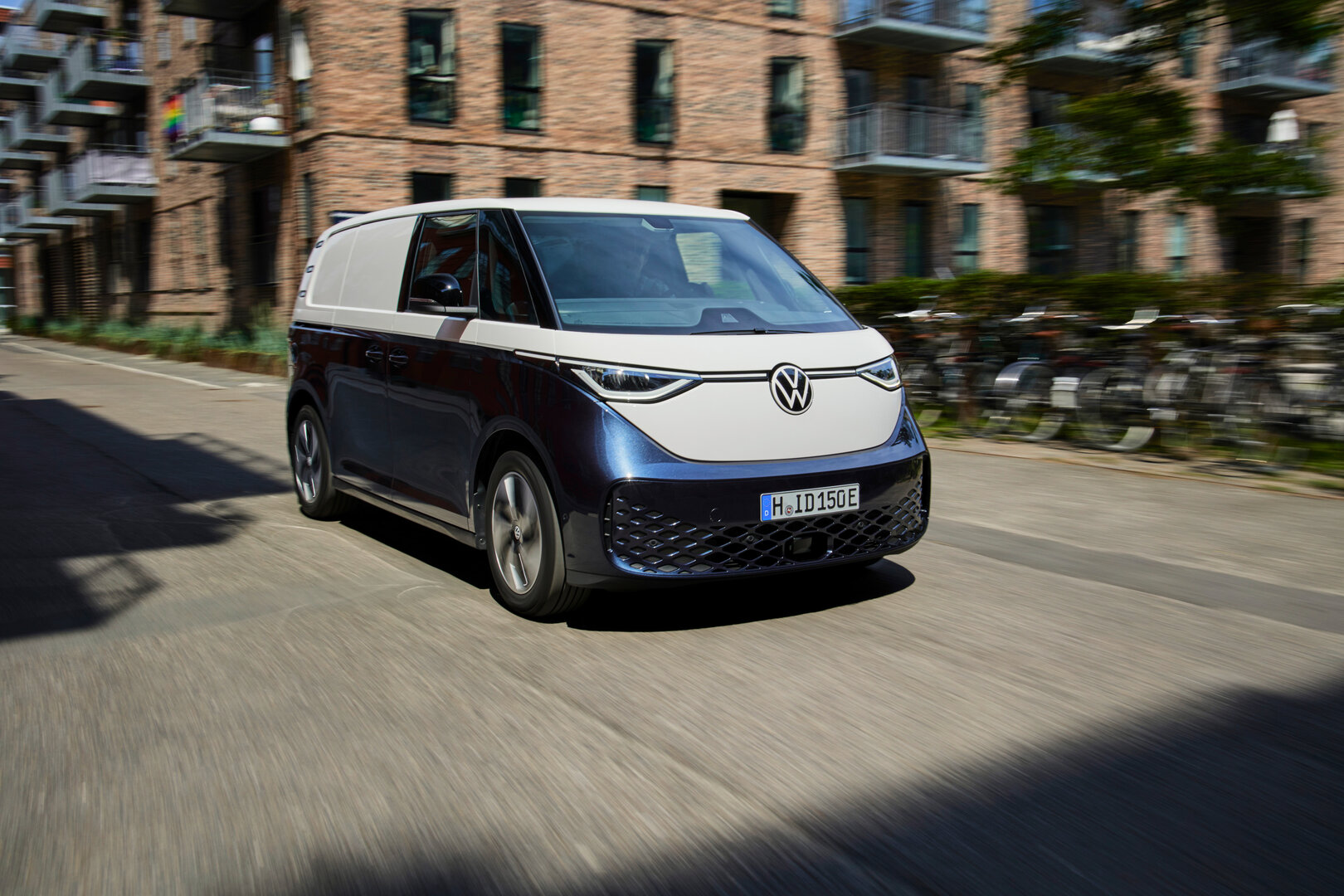
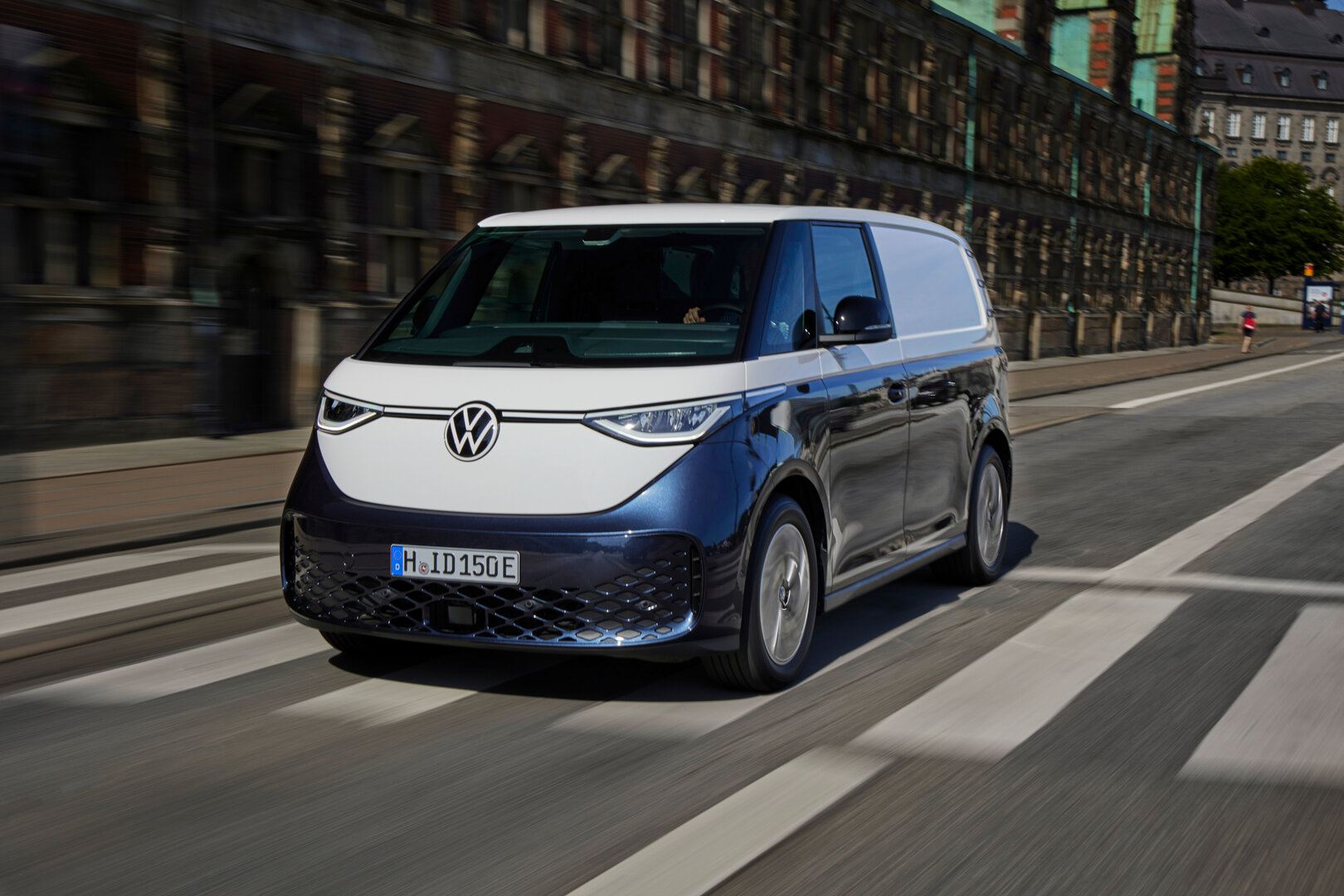
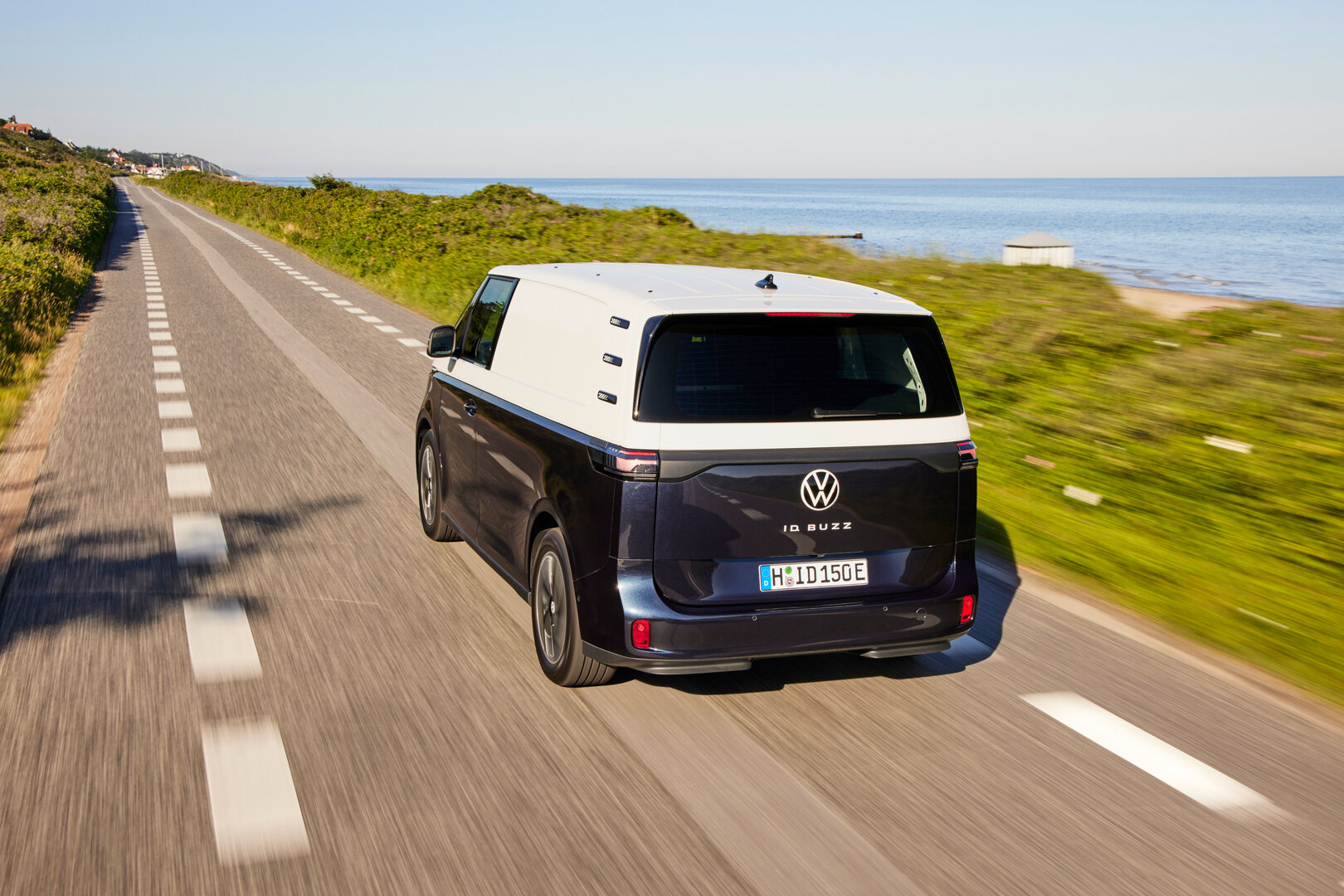
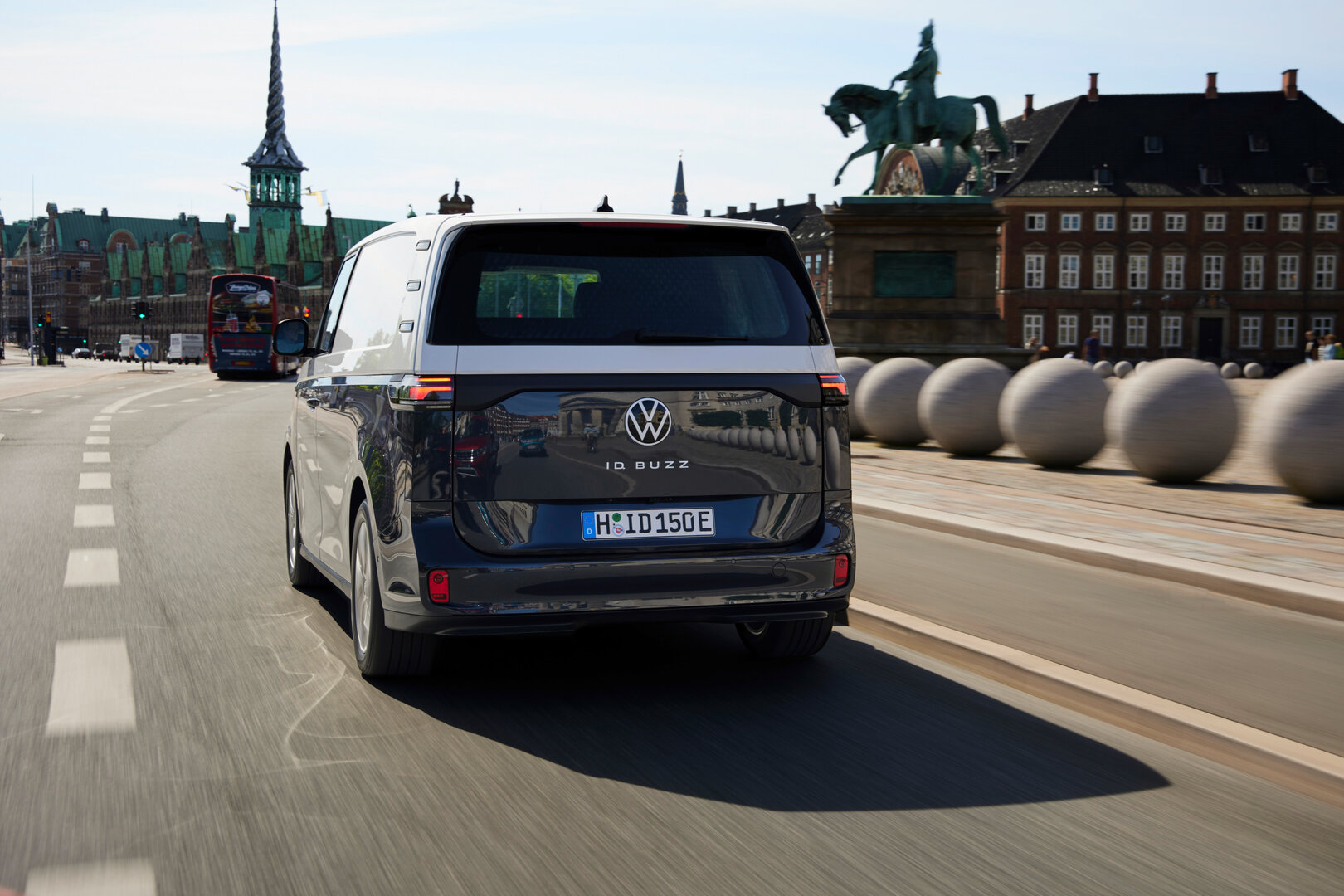
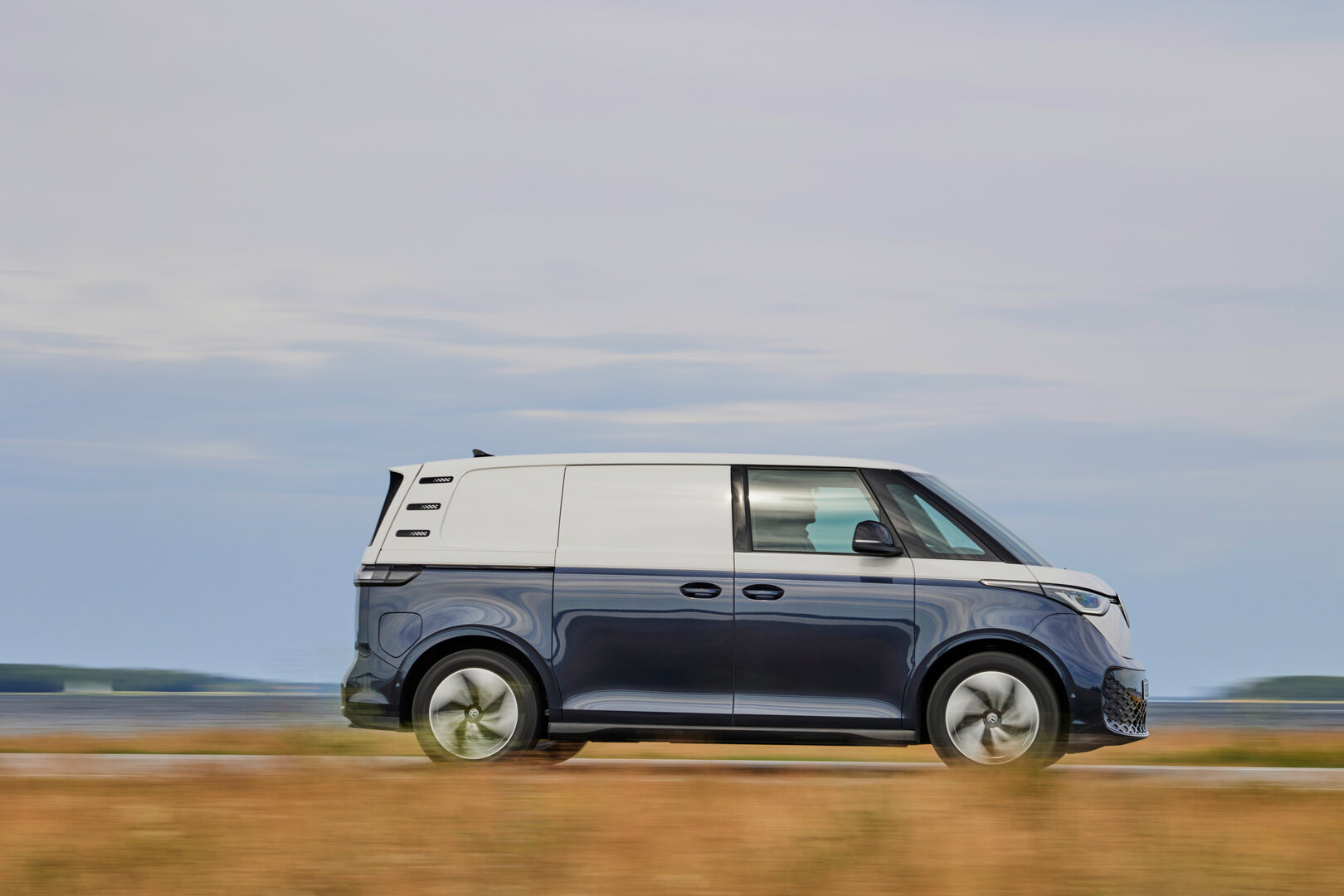
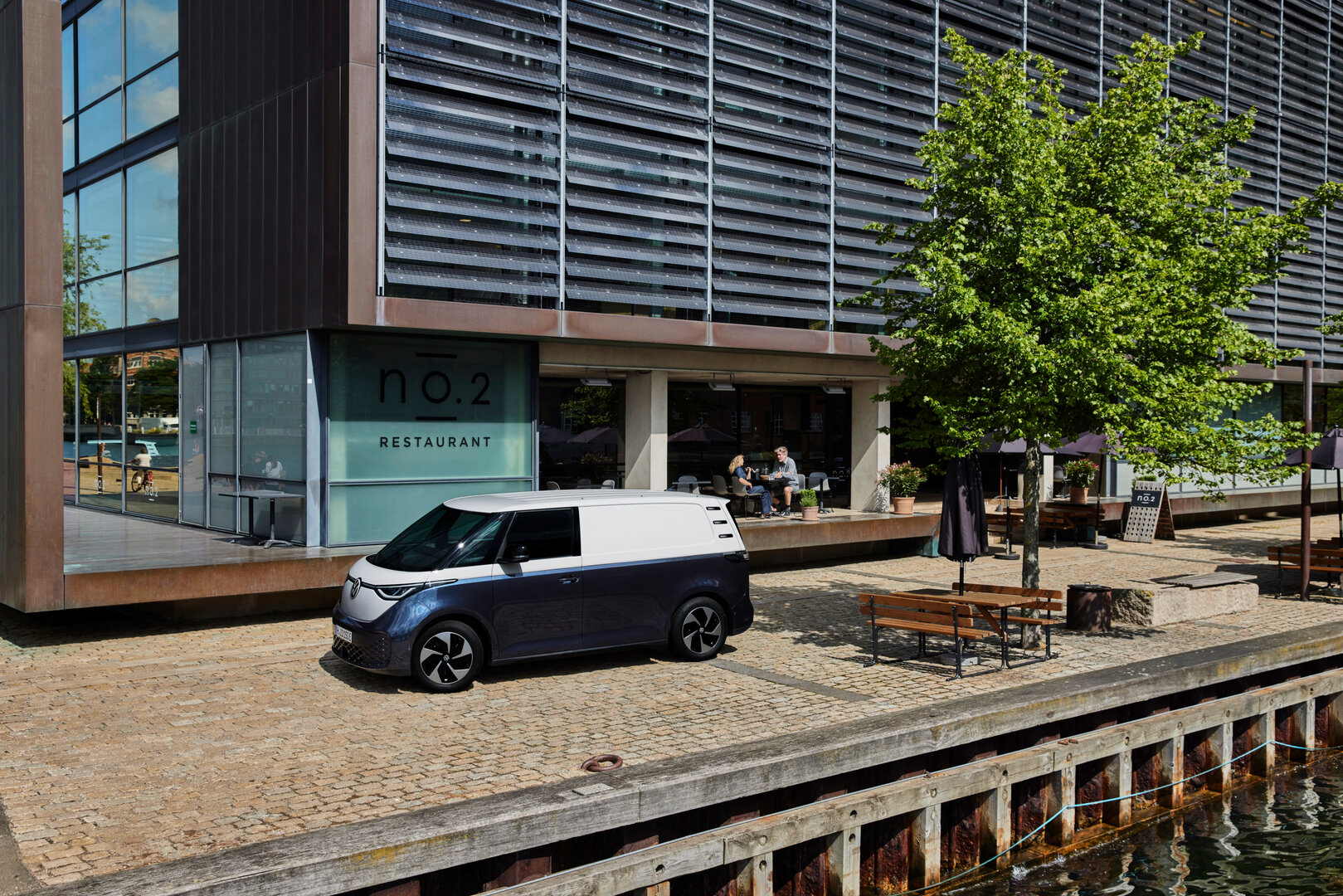
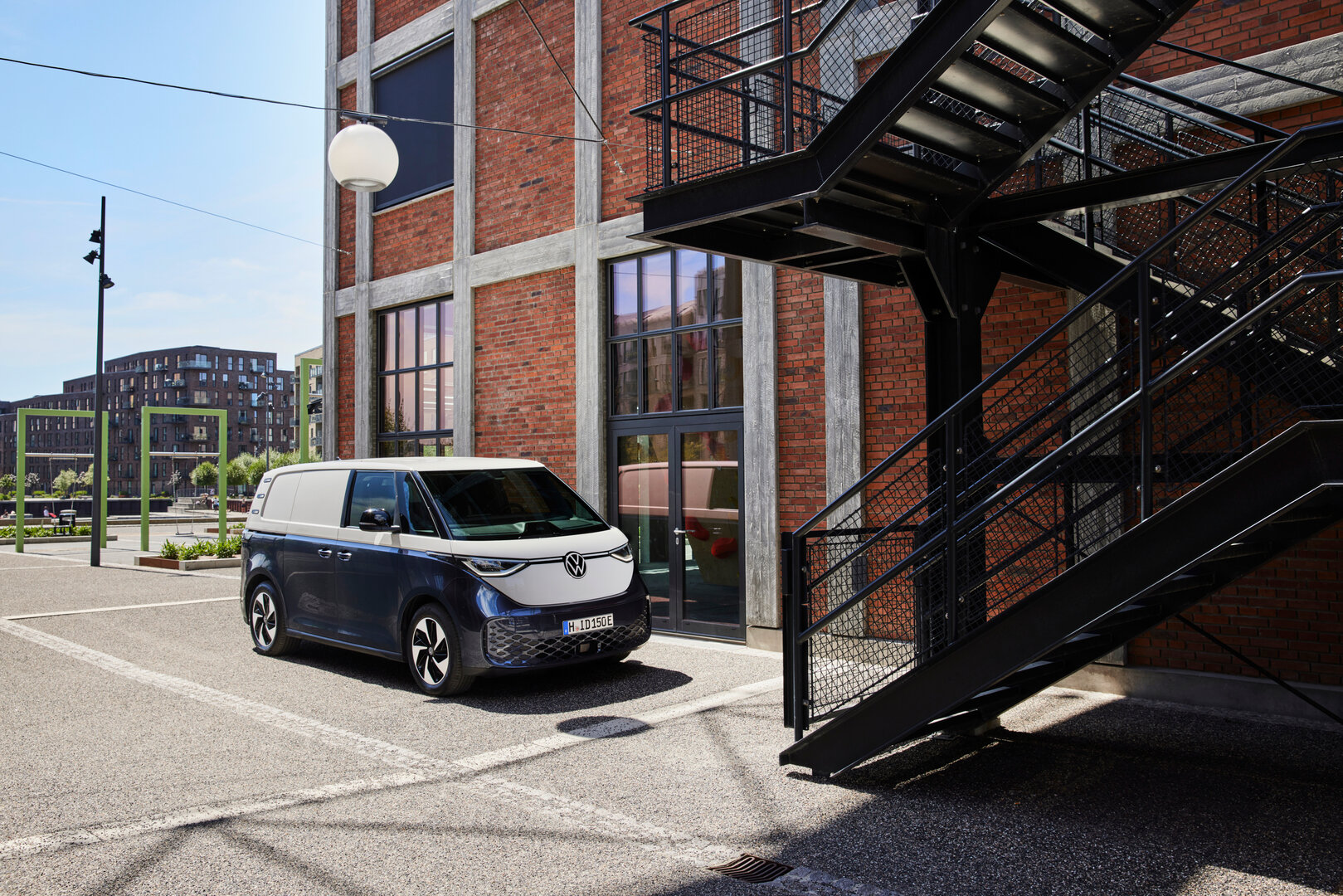
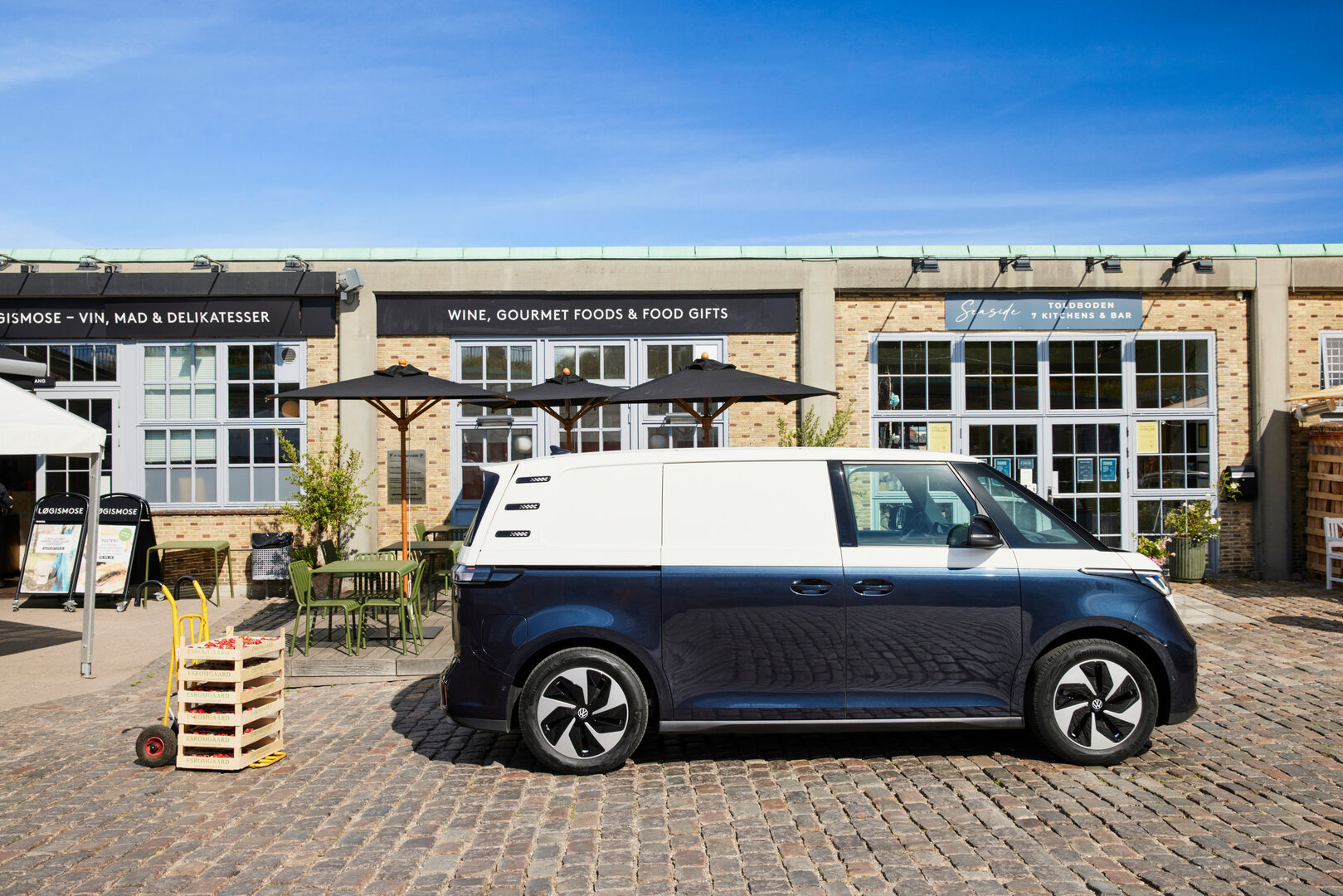
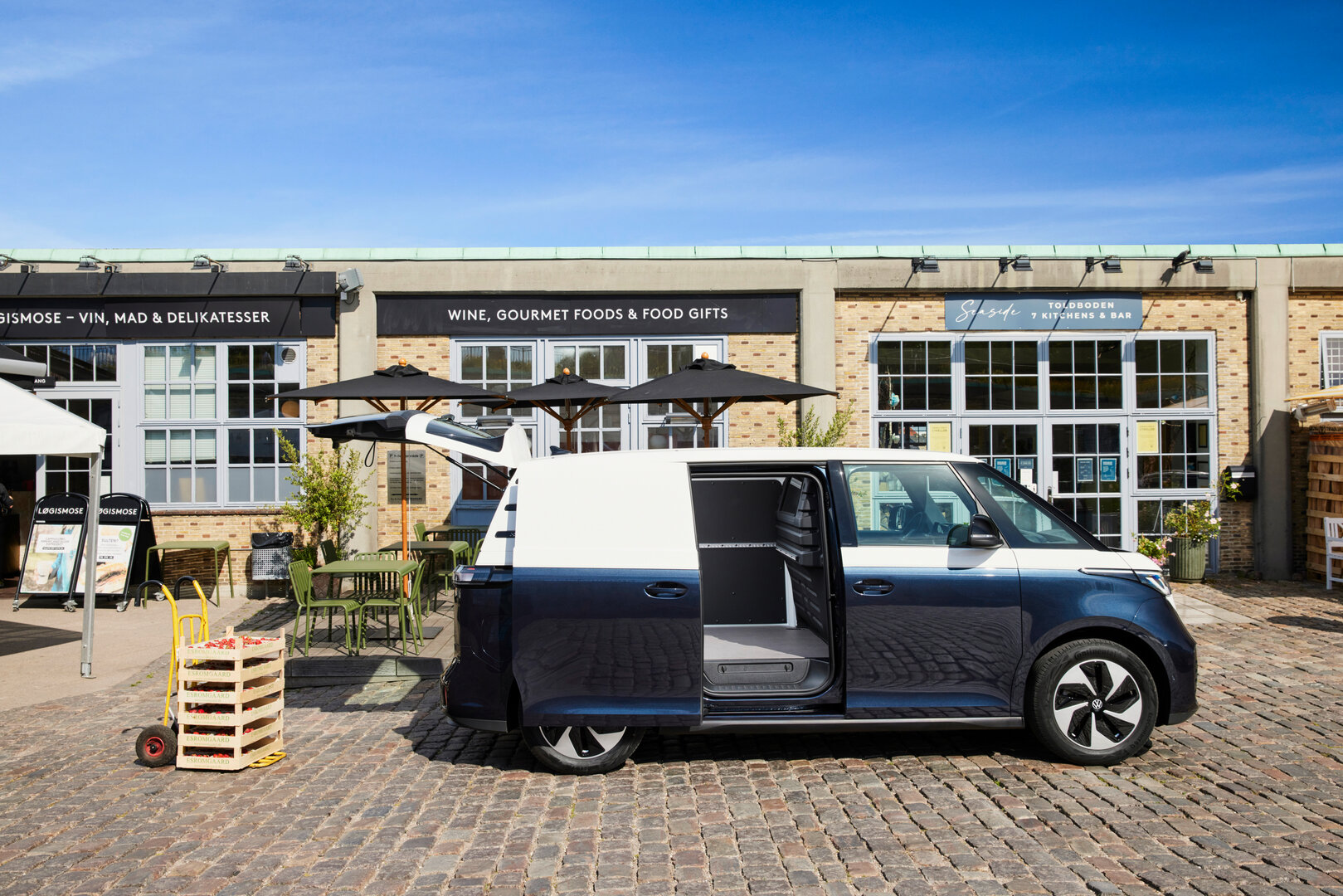
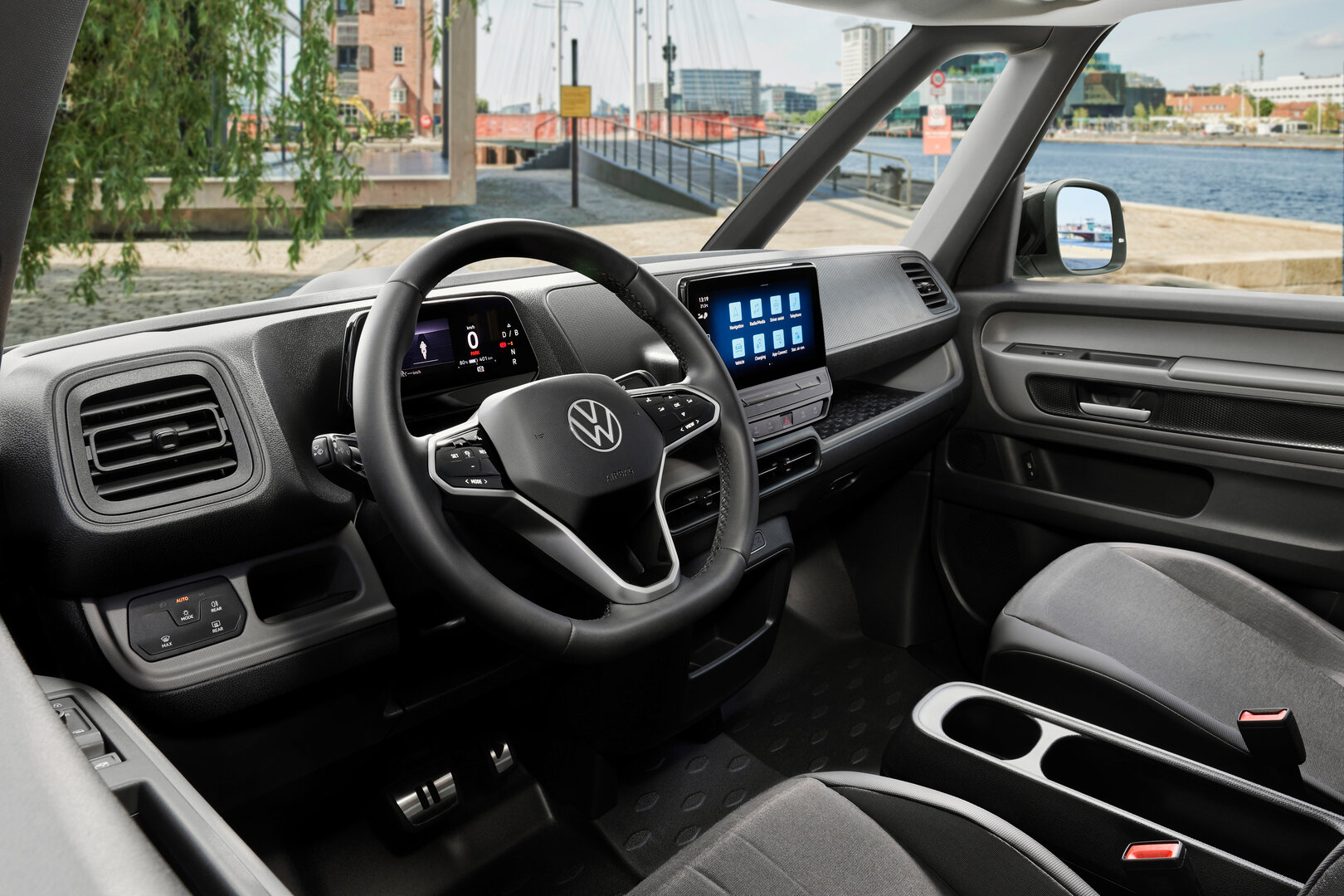
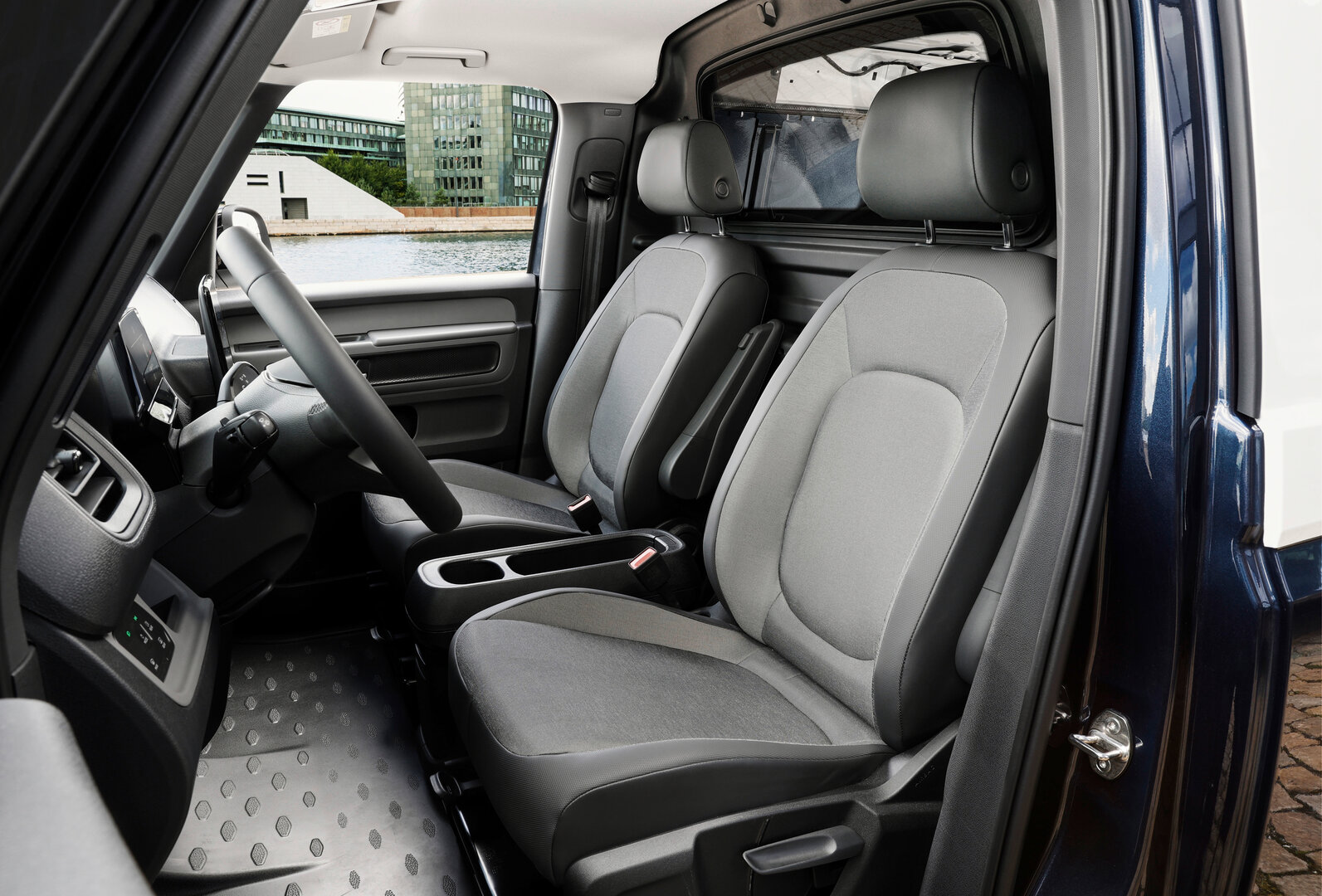
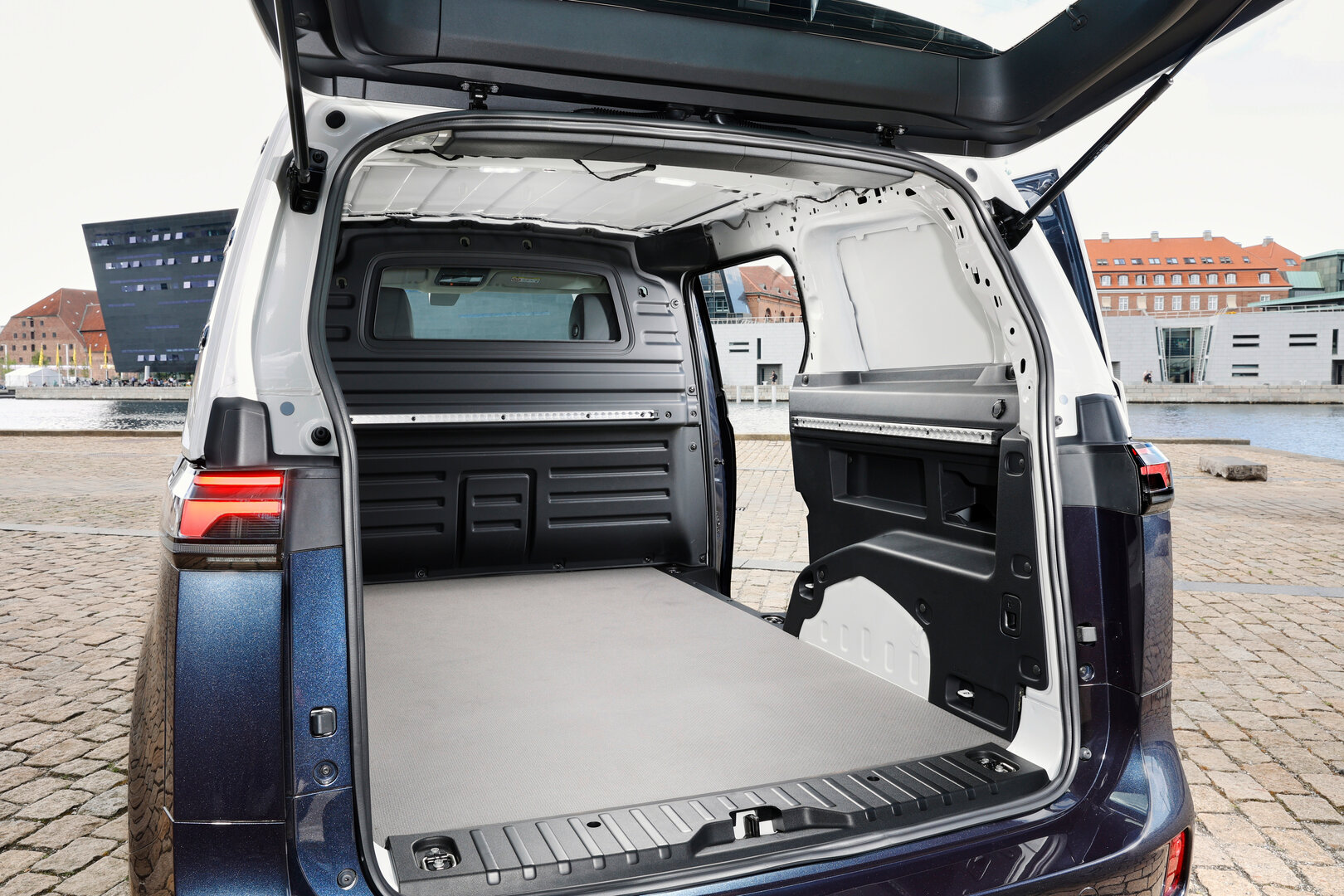
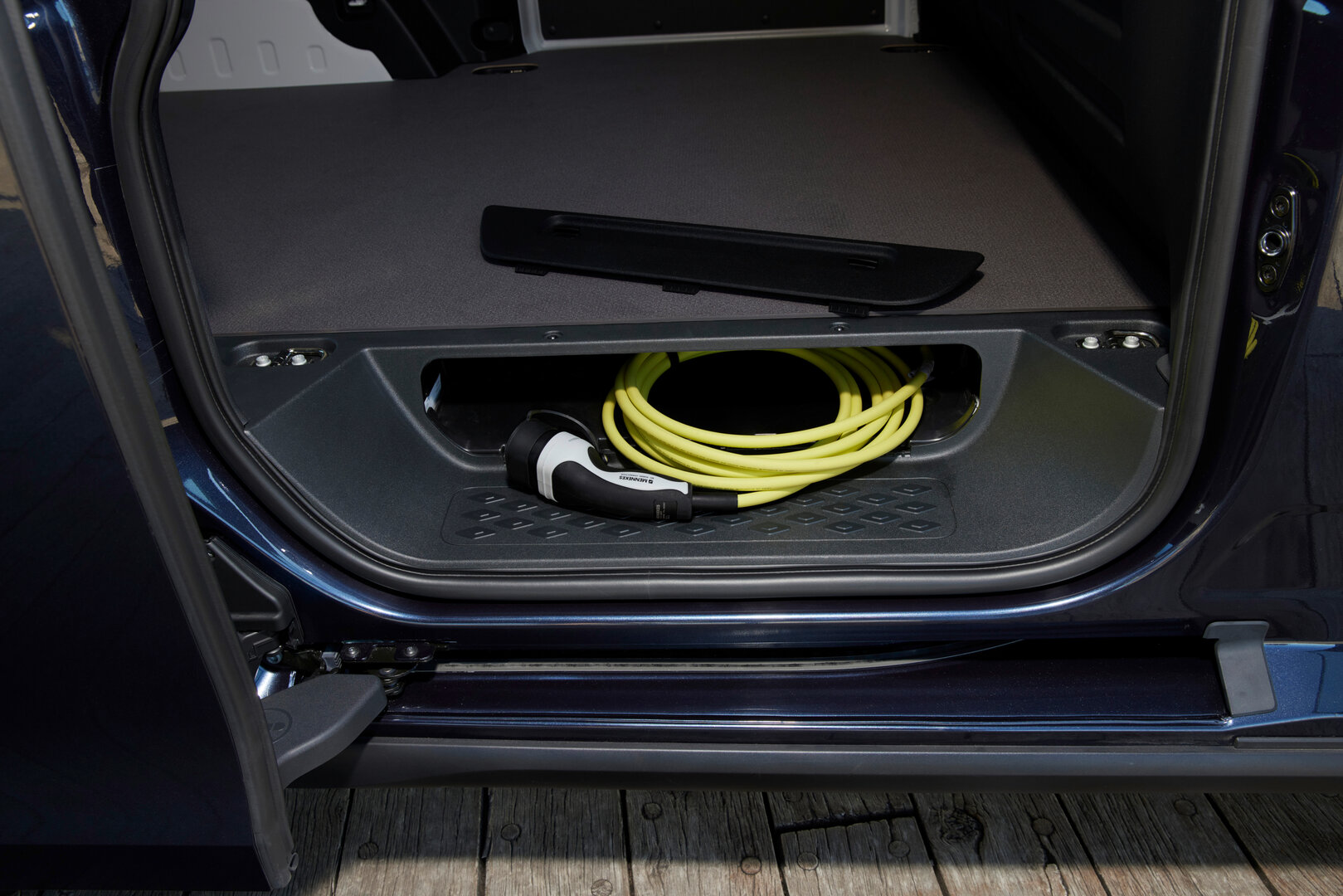
VW ID. Buzz Cargo (Image: VW)
Late pre-orderers have to be patient
Who the ID. Buzz ordered at the start of sales in mid-May or shortly thereafter, the car should be received this month after the IAA at the earliest, i.e. in the days after September 11th, but by the end of this year at the latest. Anyone who has only now taken a liking to the electric Bulli will have to wait until sometime next year. ID are produced. Buzz and ID. Buzz Cargo together with the Multivan (T7) and the T6.1 (Transporter, Caravelle and California) launched in 2021 at the German plant in Hanover, the headquarters of Volkswagen Commercial Vehicles.
ID. Buzz starts at €64,581.30
One thing doesn't seem to deter pre-orderers so far: the price. The ID Buzz may be a fun car, but the price is reasonable at a minimum of €64,581.30 for the ID. Buzz Pro and 54,430.60 euros for the ID. Buzz Cargo is no fun though. And you have to be so honest that what you would like to have in terms of special equipment and how VW presented it to the press at the first exit is more in the range of 75,000 euros and the environmental bonus of 2,975 euros has already been deducted.
The ID. Buzz turns more heads than a Lamborghini
But you have to give VW one thing: The ID. Buzz turns more heads at this price point than a Lamborghini Huracán Spyder three times the price, as proved on the beach in Skanörs, Sweden. While the Lamborghini may have a fantastic-sounding V10 and other quirks as the driver flaunted in a parking lot, the eye-catching ID. Buzz on itself – and this from all age groups from toddlers to seniors and in all genders. You can't keep up with the count, so many people turned around after the bus, took photos, gave thumbs up or wanted to know more about the car. At the Turning Torso in Malmö, the editor involuntarily became a car salesman during a photo shoot and had to present the bus to a lady sent by her husband who was enthusiastic about cars, which resulted in an almost half-hour “sales talk” including a seat fitting. According to their own statement, the couple wants to get an ID. Get Buzz – works.
-
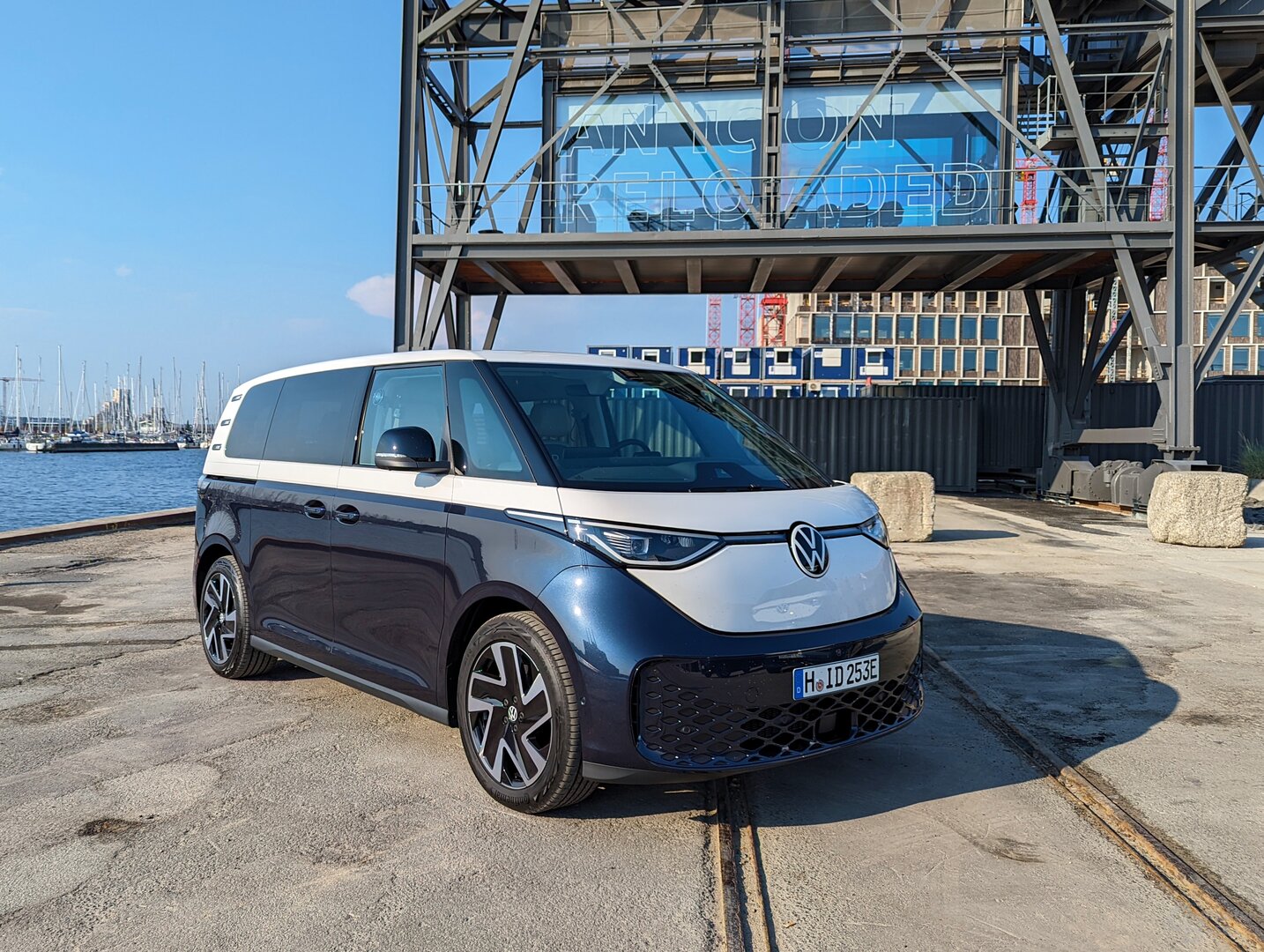 ID. Buzz in Candy White and Starlight Blue
ID. Buzz in Candy White and Starlight Blue
Image 1 of 11
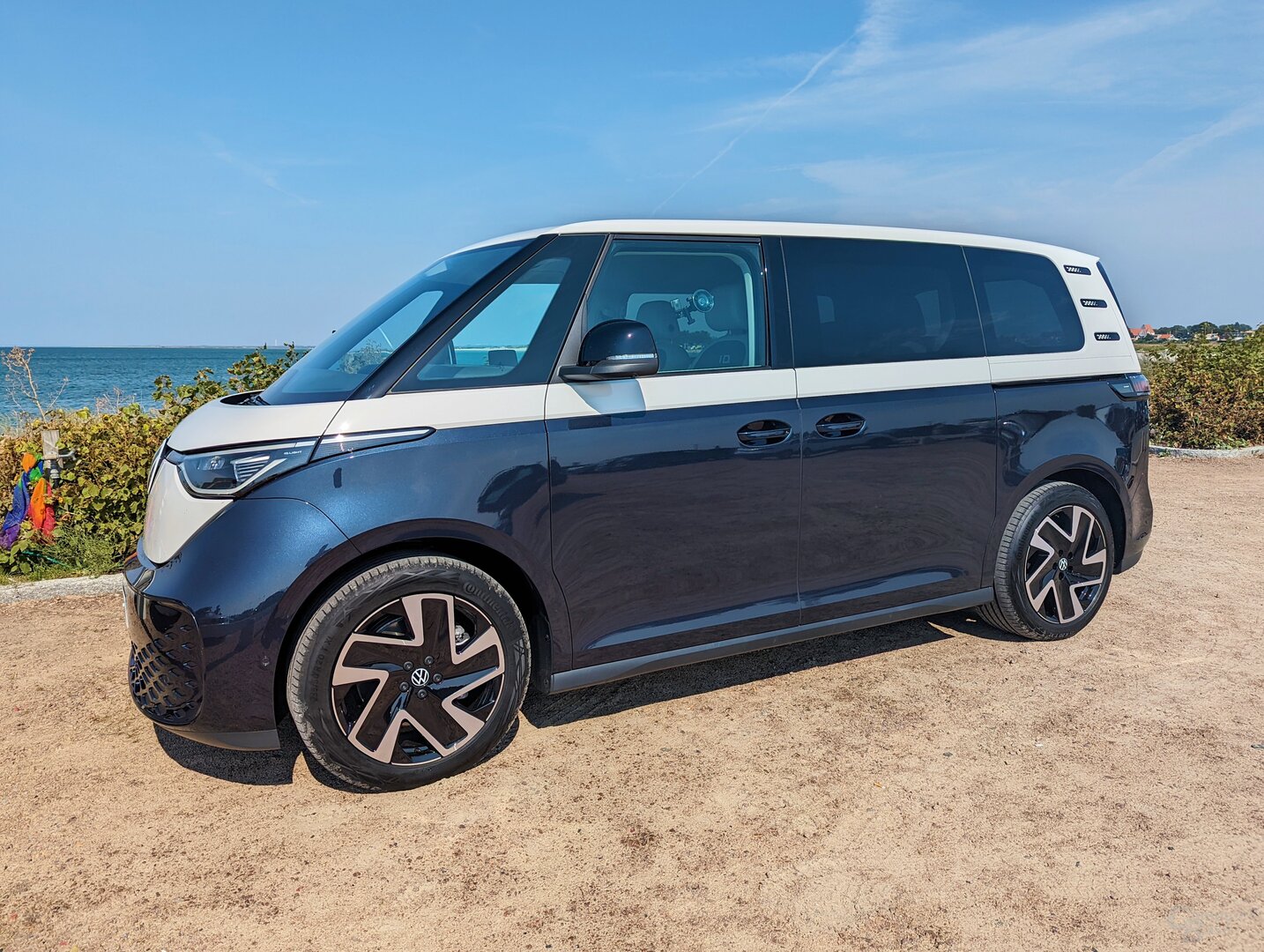
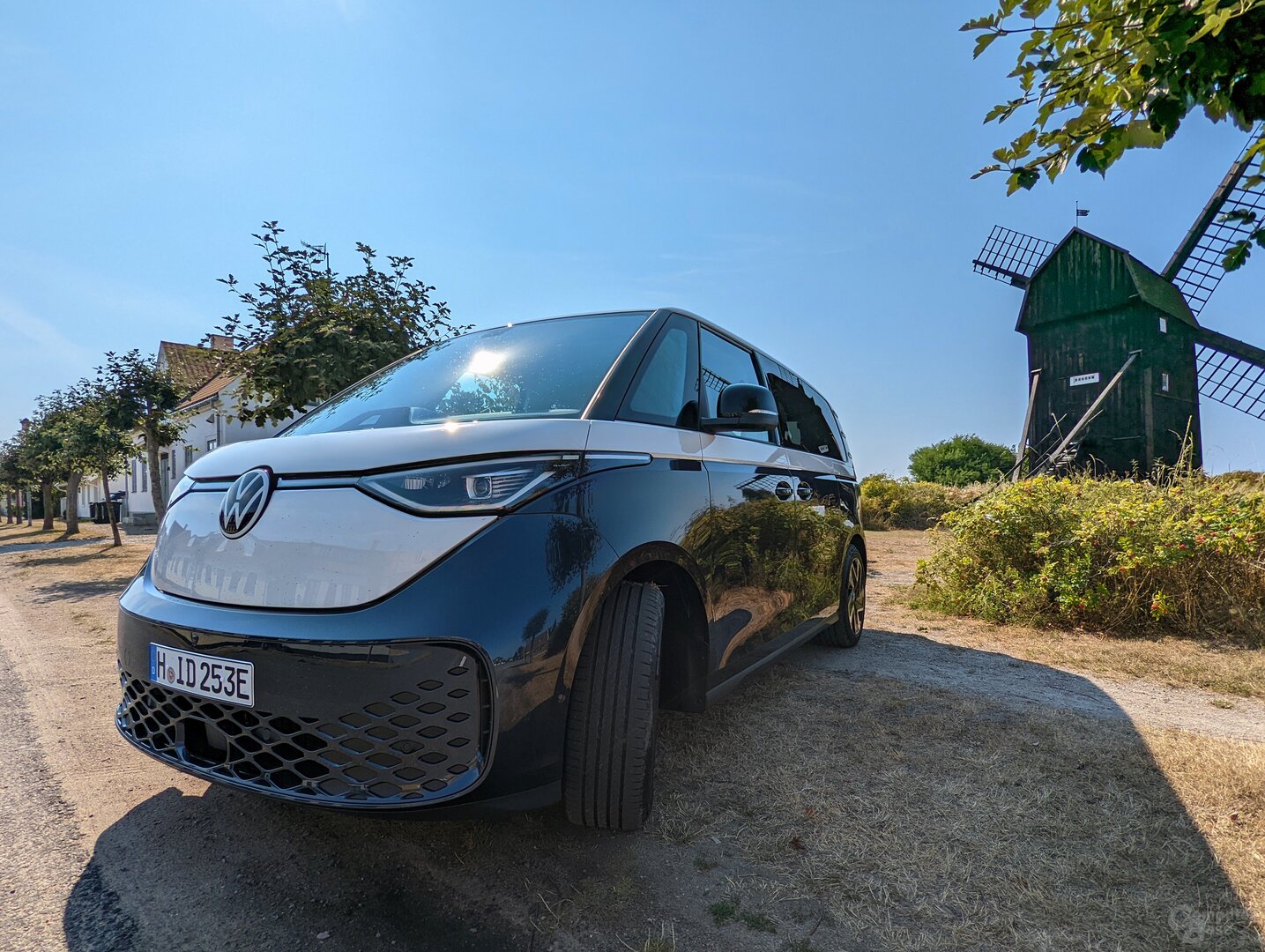
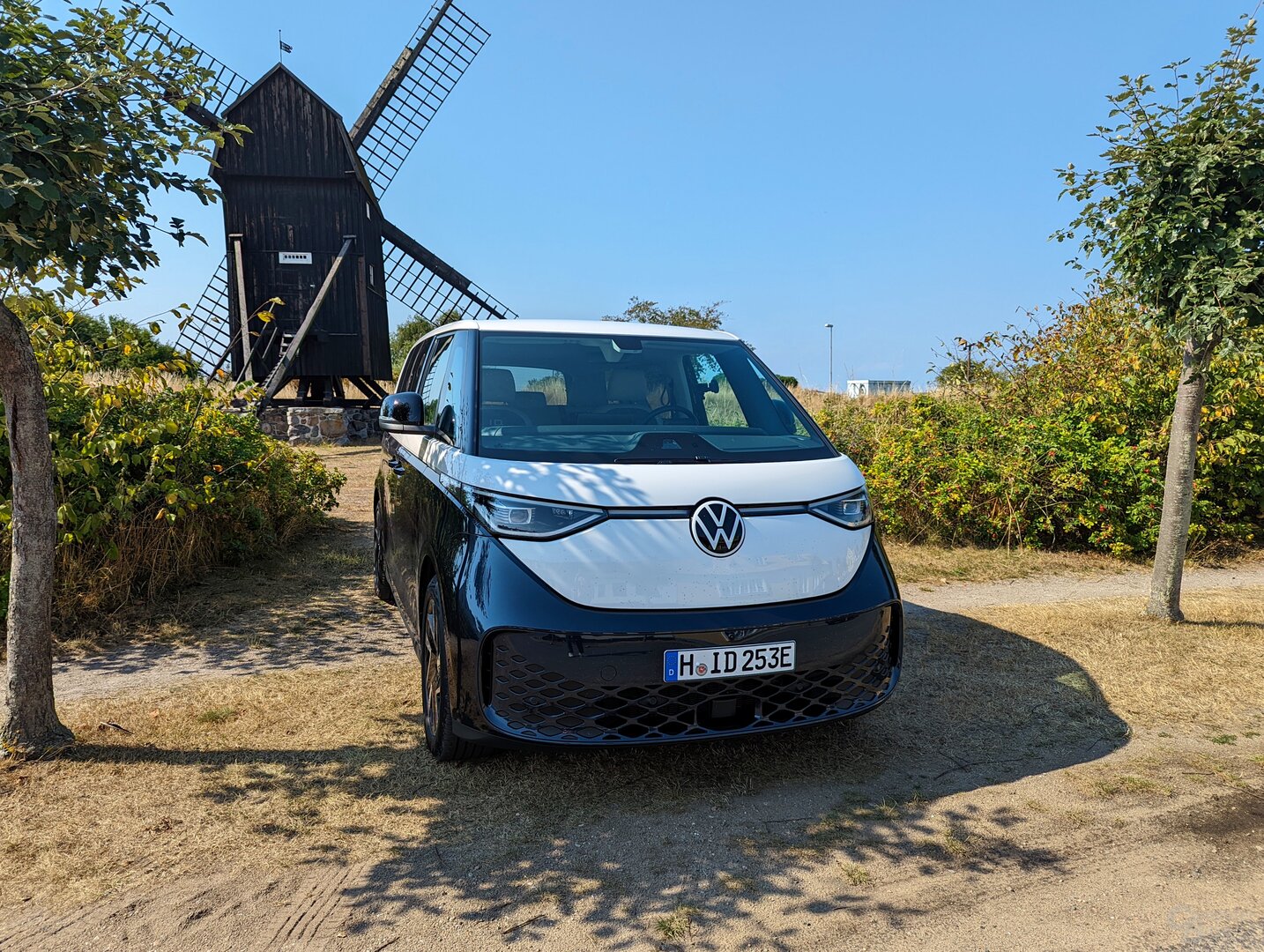
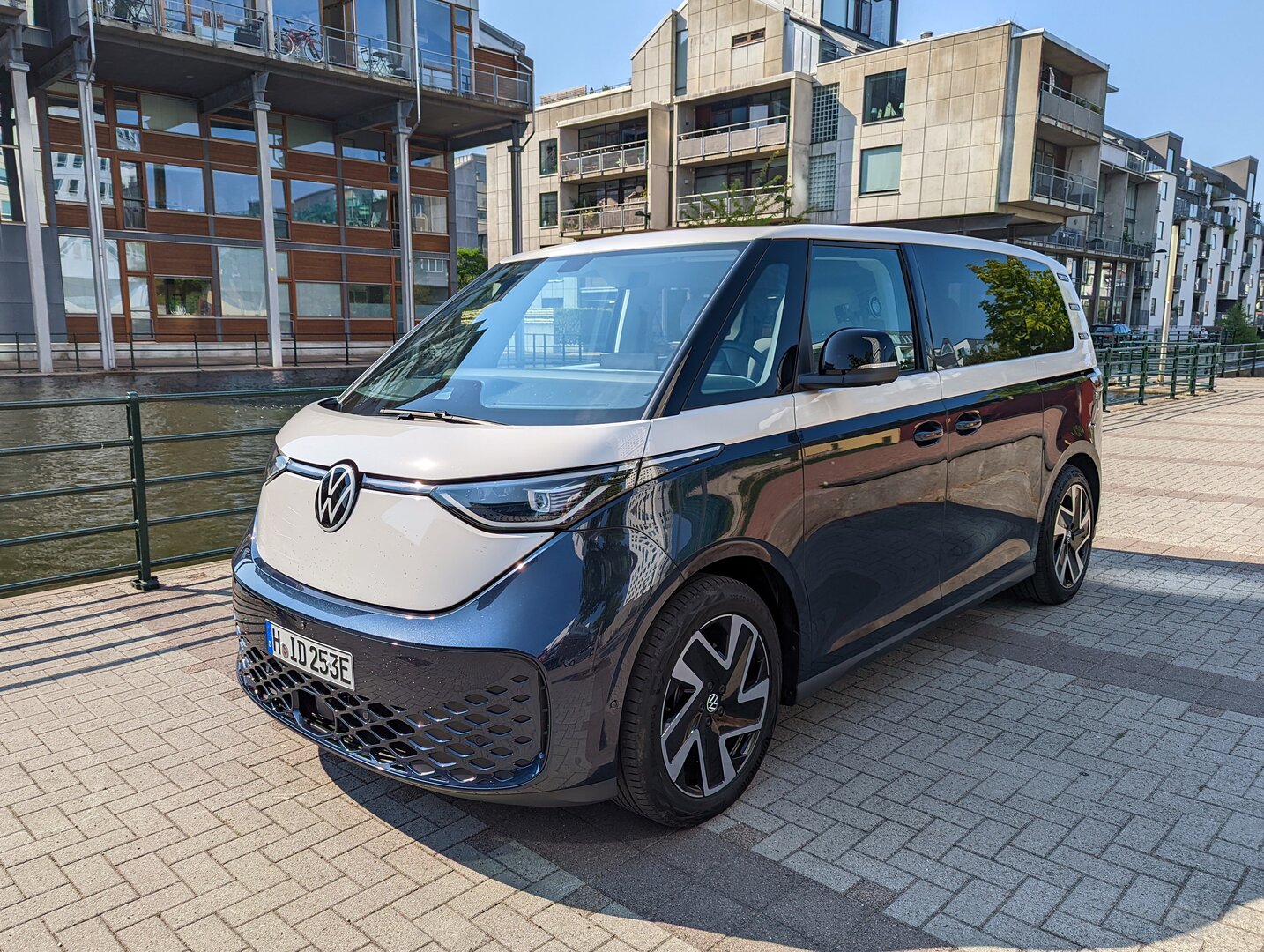
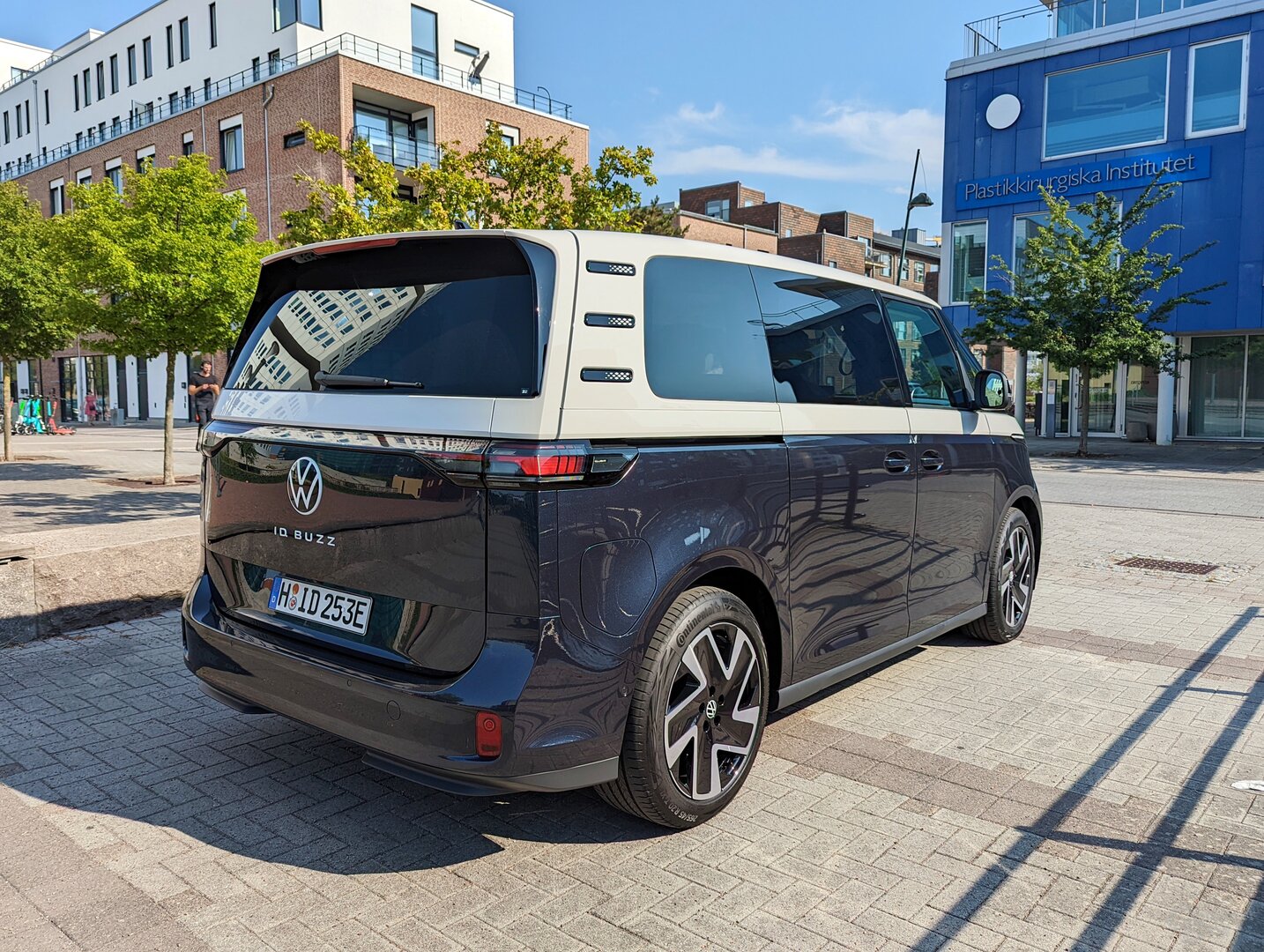
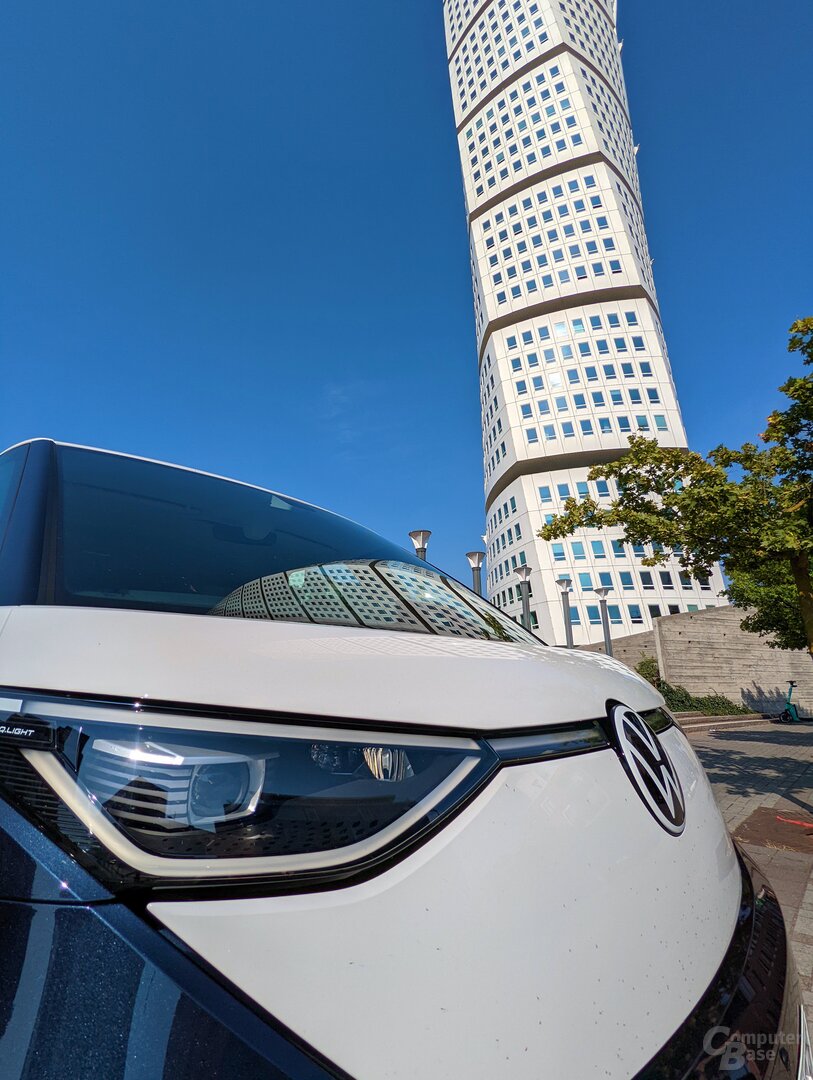
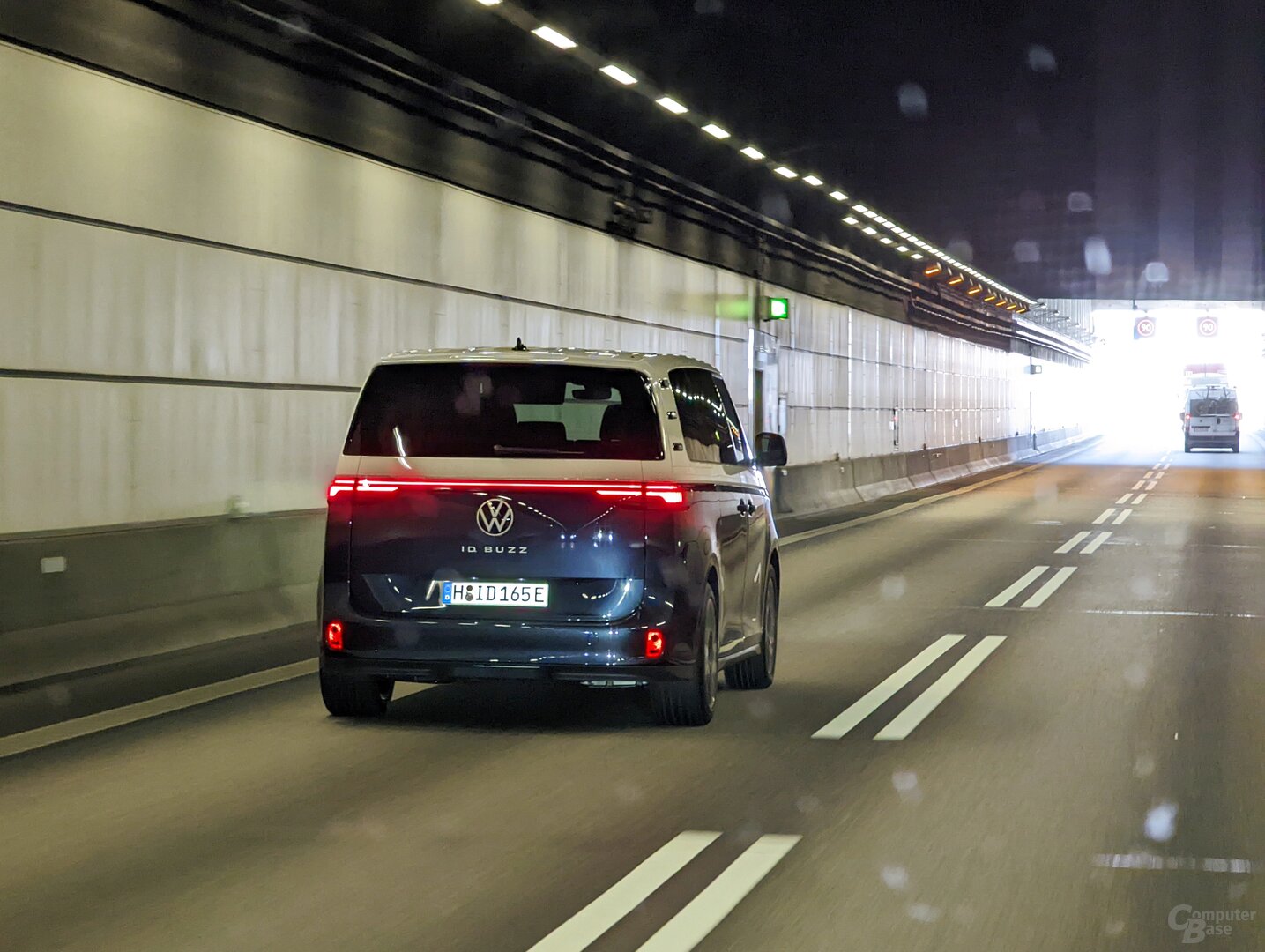
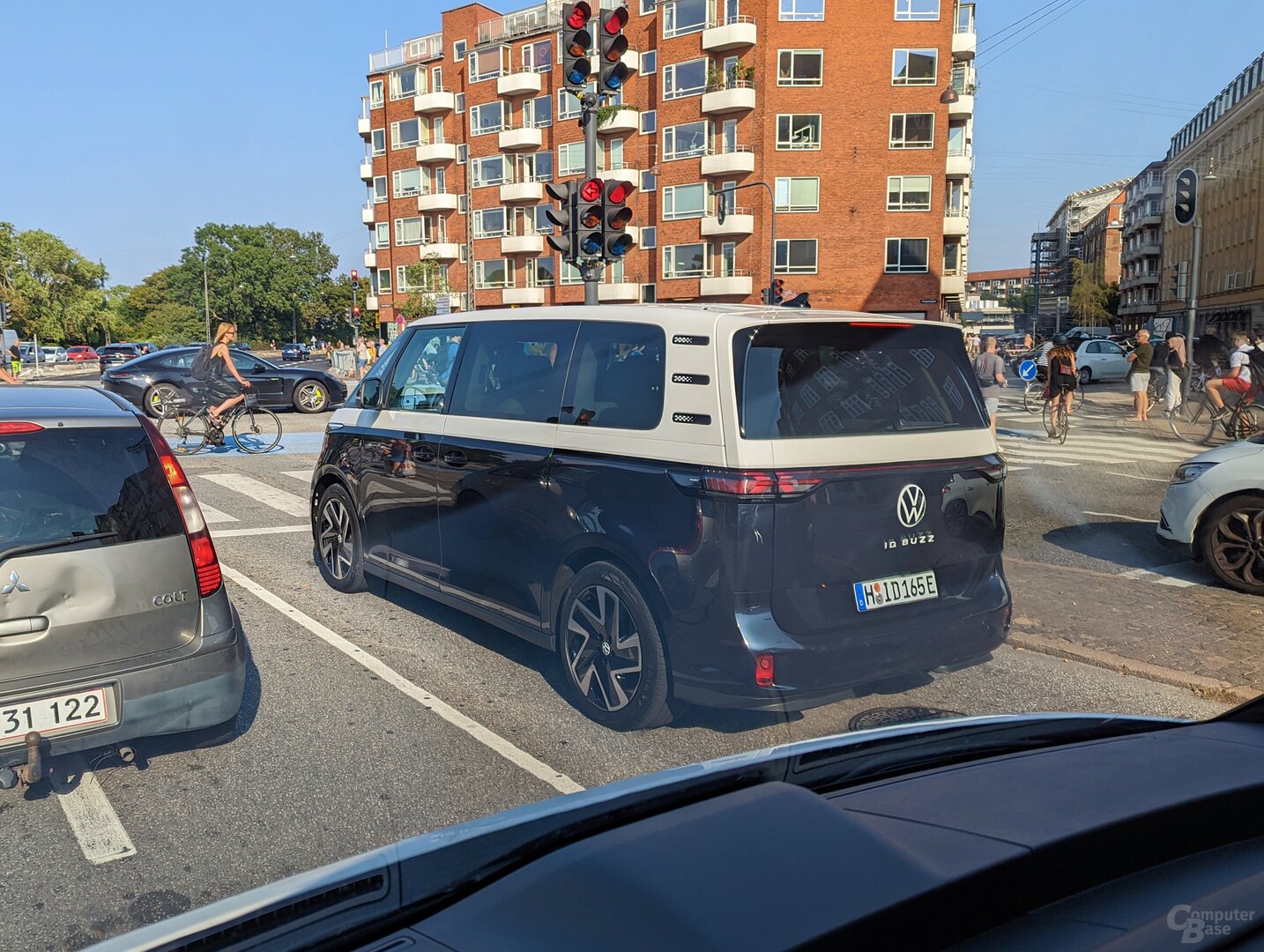
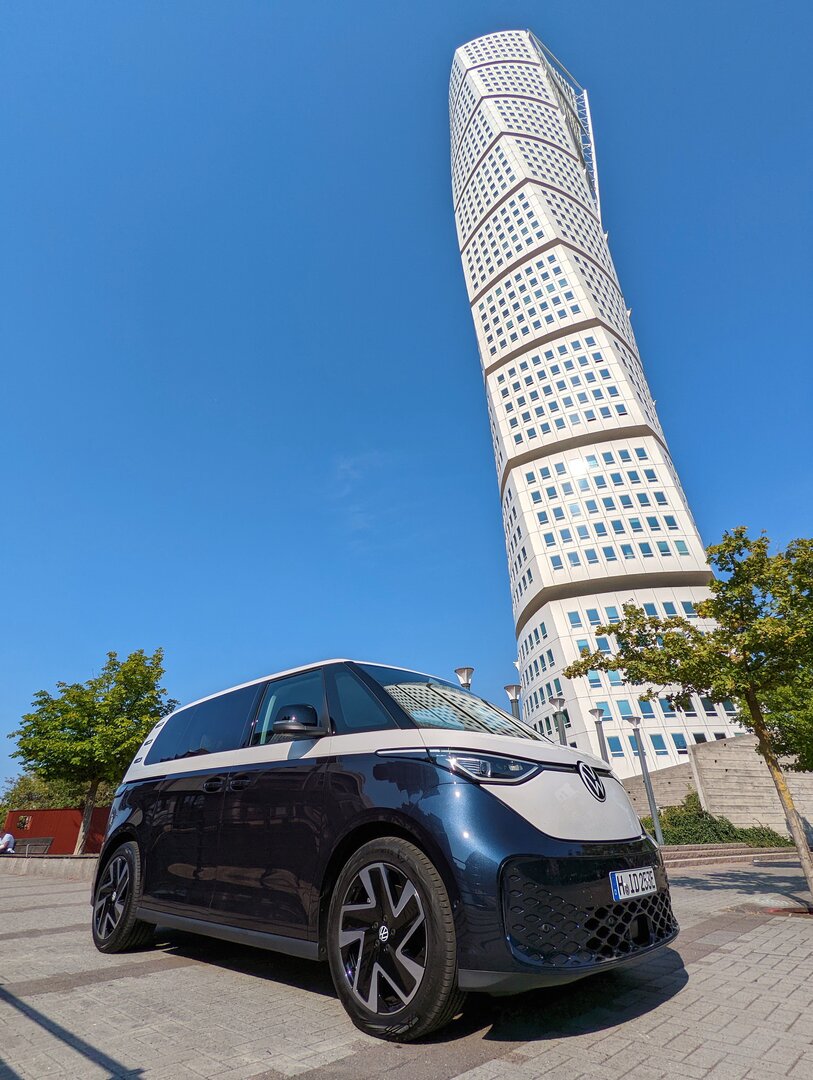
ID. Candy White and Starlight Blue Buzz
Conclusion
That is the conclusion after a day with the ID. buzz The vehicle combines practicality with such a high fun factor that people want to buy the bus even if so many seats and so much storage space are not actually needed. The biggest hurdle for most prospective buyers is probably the price and not the “want to have” factor. Among the current ID. models, the ID. Buzz is by far the most exciting new product and could, but this time in the electrical segment, lead to a success story like that of the T1 more than 70 years ago.
ComputerBase has information about this article from Volkswagen received under NDA at a manufacturer event in Copenhagen, Denmark. The costs for arrival, departure and one night's hotel accommodation were borne by the company. The manufacturer had no influence on or obligation to report. The only requirement was the earliest possible publication date.
This article was interesting, helpful or both? The editors appreciate any support from ComputerBase Pro and disabled ad blockers. More about ads on ComputerBase.